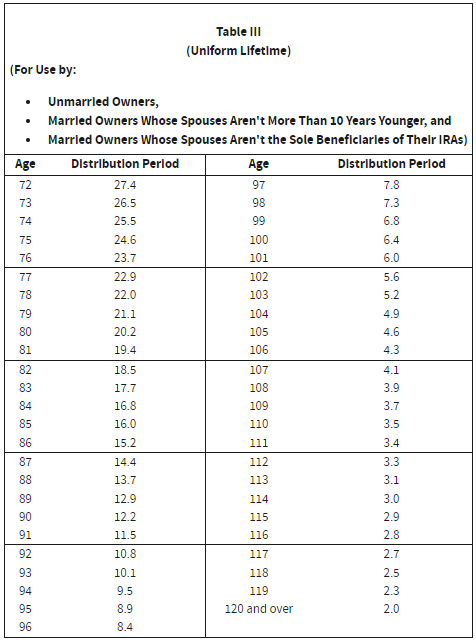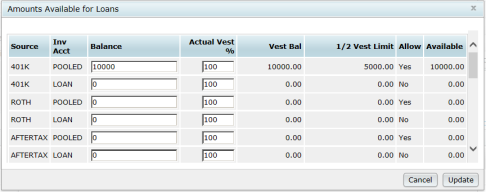Compliance Software User Guide
From start to finish, here is the general list and order of tasks to be done:
- Log into ftwilliam.com
- Select a plan, then select the Compliance module
- Add a new plan year end
- Review and edit Plan Specifications, adding investment accounts if applicable; confirm sources
- Select a census grid for importing participant census data
- Download the worksheet for the census; add data and save as .csv file
- Upload census into ftwilliam.com
- Add supplemental grid and enter any additional data required
- Run Data Scrub and address any errors
- Enter allocation parameters and calculate contributions
- Run Combined Test and address any failures
- If required, run ADP/ACP Test and address any failures
- If required, run General Test and address any failures
- If using the Transaction Menu, upload or add transaction data
- Run Top Heavy Test
- Prepare Client Package
This user guide will go through each step in detail.
Part 1: Getting Started
1.1. Logging In
You will need the company code, login name and password you received when you signed up for the ftwilliam.com system.
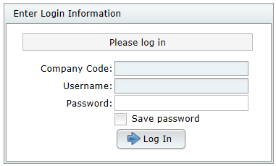
General ftwilliam.com website features available after log-in:
Getting Help: At the top of every page you will find a drop-down menu under the Wolters Kluwer logo for Support options. You can also call us during regular business hours at (800) 596-0714 (we are located in the Central Time Zone). This number can also be found by clicking the “Contact Us” link at the bottom of every page in your account. Product user guides are also available from the Wolters Kluwer button à Support à User Guides.
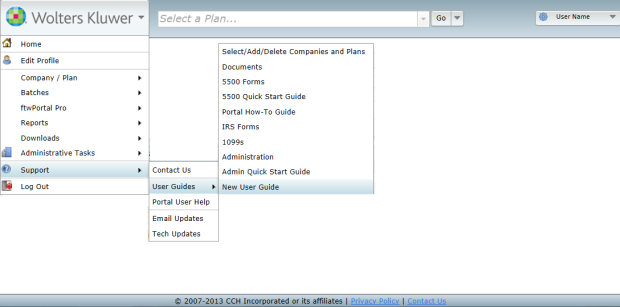
1.2. Select/Add New Company and/or Plan
First time ftwilliam.com users may need to add a company and plan to get started. Click here to review instructions to Select/Add/Delete Companies and Plans.

1.3. Select Plan and Navigate to the Compliance Module
After locating the Plan, click on the name of the plan. A list of available modules will appear under the plan name. To access the Compliance Software, click the “Compliance” button under the plan name. 
Part 2: Add New Plan Year End
2.1. First Plan Year on the ftw Compliance system
Once you press the “Compliance” button for a plan, you will be taken to the Compliance page where the system will have the “Add Year End” box ready for you to enter the first plan year end you want to work on. After entering the plan year end into the text box or selecting the year end from the Calendar tool, click on "Add Year End".

When adding the very first plan year end, the software will copy plan specifications from the plan document, if it’s on ftwilliam.com. If not then the software will use the default provisions for whatever document type you selected. You can customize one or more default plans for the Compliance system. To do this, on the Home screen enter ZZZ - Default Plans in the company search field. Choose a plan type from the resulting list, typically the document type that you use most often. Click “Edit Plan”; you can now enter your plan provisions section by section. Once you have done this, any plan you add of that document type will default to the provisions you entered. You can add additional default plans for other document types that you use.
For the first year you use the system, you will need to setup plan specifications. Once these are set, you will not have to set them up in future years unless there are changes to the plan document specifications. See the Use of the system for the first testing year section for more assistance with using the system for the first time.
2.2. Subsequent Plan Year on the ftw Compliance system
Adding a new plan year end for subsequent years is done by clicking the arrow button to the right of the Year End data in the upper left hand corner of the Compliance Tasks web page. This will expand the box, showing the option to either select a plan year or “Add New Year End”. Selecting the “Add New Year End” option will bring up a pop up box to enter the new plan year end. The system automatically enters the next sequential year end based on the latest plan year end in the system. Depending on the history in the system, you will be given the option to copy specifications from a prior year end or, if the document is on ftwilliam.com, from the plan document.
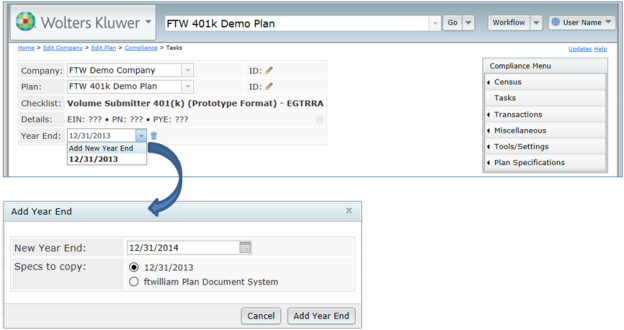
2.3 Batch Add Plan Year End
Batch adding a new plan year ends for subsequent years is done by selecting “Tools/Settings” > “Batch Add Plan Year End” from the Compliance Tasks web page. This option will bring up a pop up box to enter the new plan year end.
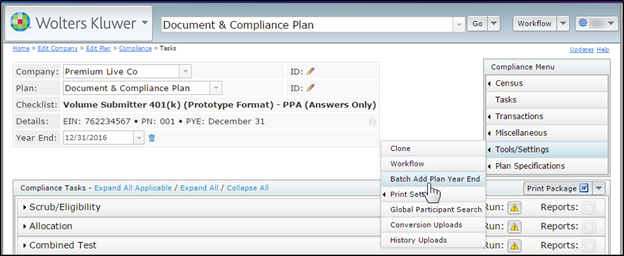
After selecting the year you wish to add, click on “Add Year End”.

A window with the list of plans available to be rolled forward will appear. Note: Only plans that have an existing prior year end will be on the list. Ex. Plan has a 12/31/2015 PYE and no 12/31/2016 PYE. You selected 12/31/2016. The plan will appear on the list for 12/31/2016. Depending on the history in the system, you will be given the option to copy specifications from a prior year end using compliance specifications or, if the document is on ftwilliam.com, from the plan document specifications. The default on the batch level is the prior plan year end compliance specifications. You have the ability to filter the list by Company Name, Plan Name 1, Plan Name 2, Specs to Bring Forward, Resp (*Based on the entries on the Edit Plan page.) and Admin (**Based on the entries on the Edit Plan page.) You are also able to sort by these columns. You can select all plans or choose which plans to roll forward based on your filters and sort options. You have the ability to export the list you have chosen in a .csv. The link is in the lower right hand corner of the “Batch Add Year End” window.
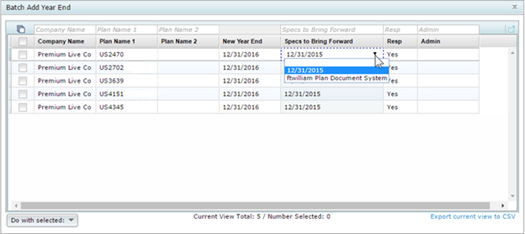
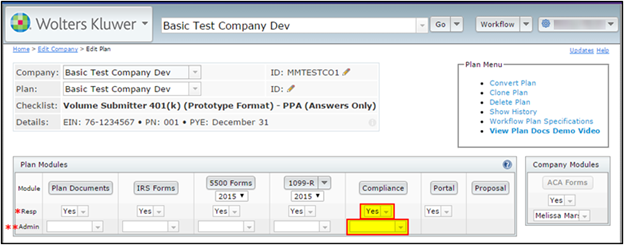
Once you are ready to proceed, select the “Do with Selected” button and a drop down will appear with the option to “Bring Forward Info” or “Change columns”. The change columns option currently only contains the ability to change plan specs for all the selected plans. However, it has been designed this way so more options can be made available in the future.
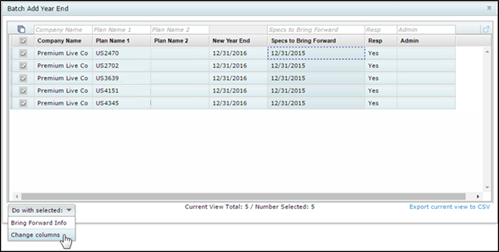
When selecting “Change columns”, a pop up box will appear.
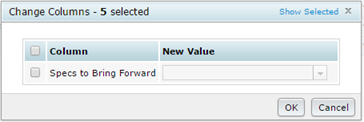
Be sure to select the check box next to “Specs to Bring Forward” and then select the value you wish to replace for the batch from the drop down for the option.

At this point you have the ability to display a list of the plans you have chosen by clicking on the “Show Selected” link in the upper right corner.

Select “OK” to proceed or “Cancel” to be returned to the “Batch Add Year End” window.
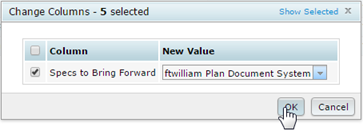
You will see a “Confirm Change” pop up. Select “Yes” to make the change or “No” to be returned to the “Change Columns” pop up.

You will be returned to the “Batch Add Year End” window. From here you can select “Bring Forward Info”.
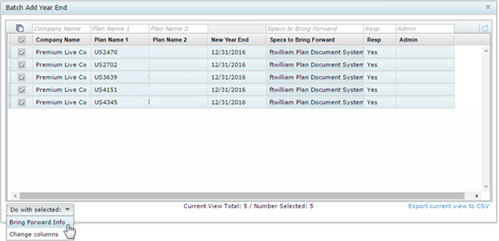
A pop up will appear to confirm your choice.

At this point you have the ability to display a list of the plans you have chosen by clicking on the “Show Selected” link in the upper right corner.

Select “Confirm” to proceed. You will be returned to the “Compliance Tasks” web page. From here select “Compliance” from the breadcrumbs at the top of the screen and you can go to any of the plans you have selected to view the newly added year end OR to view all added plan years, you can select “Tools/Settings” > “Workflow” from the Compliance Tasks web page.
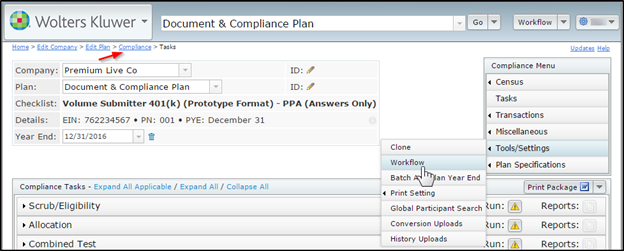
You will be directed to the Workflow page and can sort by the “Yr End” column to see all the plans for that year end.
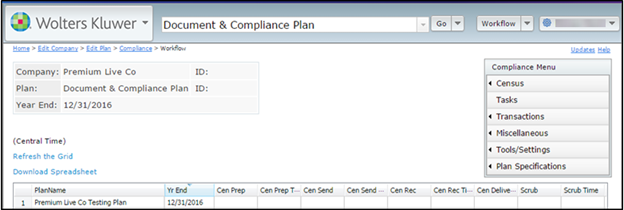
Part 3: Navigation
3.1. Compliance Menu
The Compliance Menu is located in the upper right hand corner of the screen in the Compliance Module. This menu can be found in all of the main pages throughout the Compliance Module and is a handy way to navigate to any page, from any page.
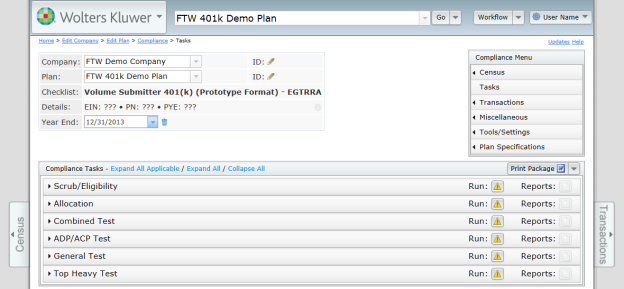
The Compliance Menu is where users will find the following areas of the software:
Census
Hovering over the census option from the Compliance Menu expands the list options to give users the option to edit (navigate to the census web page), download the census, upload the census, create or edit census grids, navigate to the Other Import/Export Reports screen or to portal files. Simply clicking the Census option will also take the user to the Census web page.

Tasks
Clicking Tasks from the Compliance Menu will navigate the user to the Tasks page, where the data scrub, allocations and testing is done.
Transactions
Clicking Transactions from the Compliance Menu will bring the user to the Transactions web page. Hovering over Transactions from the Compliance Menu gives user the option to go to the Transactions web page, perform vendor uploads, navigate to the loan module, view participant transactions and print reports/statements.

Miscellaneous
Hovering over Miscellaneous from the Compliance Menu will expand the list, giving the user the ability to access the 5500 data report, 1099-R Export menu, 8955-SSA Export menu, RMD menu and Miscellaneous Reports (which include the Summary of Test Results, Plan Highlights report, Vesting Export reports and Master File Changes report).

Tools/Settings
Hovering over Tools/Settings from the Compliance Menu will expand the list options giving users the access to the Clone feature, Workflow, print settings, the Global Participant Search feature, conversion uploads and history uploads.
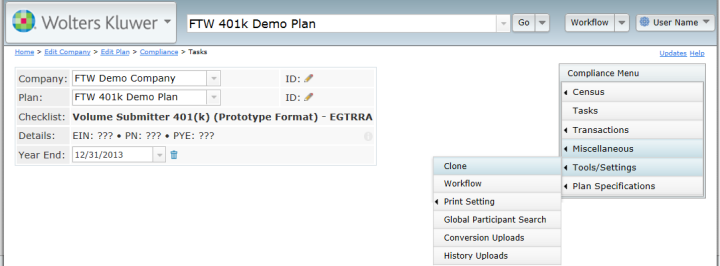
Plan Specifications
Clicking on Plan Specifications from the Compliance Menu navigates the user to the Plan Specifications web page. Hovering over Plan Specifications gives users the edit option (will navigate the user to the Plan Specifications web page), ability to print plan specifications and compare the plan specifications in compliance to those in the plan document.

3.2. Breadcrumbs
Breadcrumbs are located at the top left of every page in ftwilliam.com. Clicking on any part of the breadcrumb will take the user back to that part of the software.

3.3. Tabs
Tabs are located on both the left and right side of every page. Clicking these tabs will take the user to one of the main screens in the software, such as the Census, Tasks or Transactions, as applicable. The options change depending on which page the user is currently in and is intended to help serve as a workflow tool as well as a navigation tool.
Part 4: Plan Specifications
Select Plan Specifications from the Compliance Menu to set up, review or edit the plan specifications; it is very important to ensure the plan specifications are accurate and that overrides are correctly selected. Please see the Help buttons for questions on specific plan specification options and for examples of how to complete the specifications for certain plan designs.
If you use ftwilliam.com for plan documents, the plan specifications will automatically be loaded onto the Compliance system for the plan. Otherwise specifications will be based on defaults that you have set up (in ZZZ-Default plans described under Add New Plan Year End ). To make a change to plan specifications, click on one of the sections to expand them and complete or change the checklist item as required. You may need to change some checklist items if the plan document has changes that do not take effect until a future year.
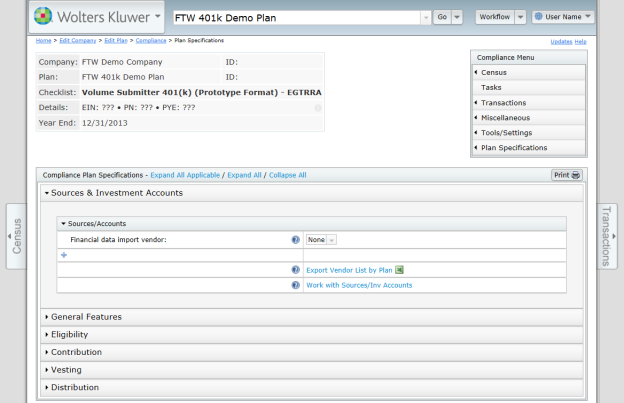
4.1. Sources & Investment Accounts
This section contains the vendor selection, which is used if transactions from a specific vendor are being uploaded into the system. It is also where the “Work with Sources/Inv Accounts” link is found.

Financial data import vendor
Press the drop down box next to Financial data import vendor to select the asset custodian from which you plan to upload transaction files. Selecting a vendor will make the Financial data import ID code field active. This is where you enter the vendor specific account ID. If you plan to upload files from a vendor not listed you should select “Generic”. Check with support@ftwilliam.com to get a sample format for your upload.
Work with Sources /Inv Accounts
Sources and investment accounts (if applicable) need to be set-up in order to properly create transactions for a plan or to use the loan module. Press the “Work with Sources/Inv Accounts” link to review the applicable sources and/or investment accounts for the plan.
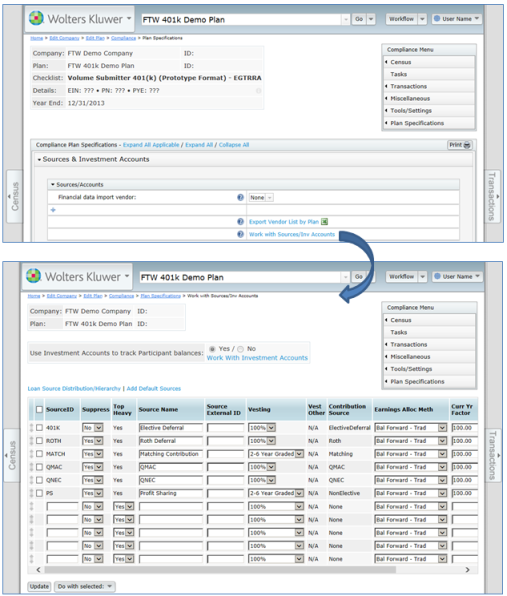
Work with Sources
Below each feature will be discussed as appears on the page from left to right:
- Suppress. You may suppress sources (e.g. QNECs and QMACs) under "Suppress" if you know they will not be used in the plan year and/or you do not want them to appear on statements.
- Top Heavy. You should note whether or not any sources you add will be considered for Top Heavy purposes (i.e. sources rolled over from an unrelated prior plan should show the Top Heavy indicator as "No"). Contribution sources will always show as "Yes" for top heavy purposes and you will not have the ability to modify this.
- Source name / description. The contribution sources will be shown based on plan specifications with default names and descriptions. These are the sources to which the Compliance system will make allocations. You may change account names and account descriptions if you use different descriptors than our system.
- The external ID for a source is used if you are linking the plan to an asset custodian. You can map these external sources to ftwilliam sources on the Transaction Menu as described below.
- Vesting. Vesting shows the vesting schedule as indicated in the plan specifications. Note that some accounts will not let you modify the vesting schedule to something other than 100% (e.g. Elective Deferrals). If the vesting schedule is "Other6" you will have the opportunity to enter information about the other vesting schedule under the "Vest Other" column. The format that this information must be entered is as 6 numbers separated by a semi-colon (with no spaces): "year0;year1;year2;year3;year4;year5" (year 6 will be 100%).
For example, a four year graded vesting schedule would be shown as follows: "0;25;50;75;100;100". In this example, a participant is 0% vested is she or he has less than one year of service; is 25% vested after one year of service; 50% vested after two years of service; 75% after three years of service and is 100% vested after four or more years of service.
- Contribution Source. This tells the user which source contributions are made to. If it is a manually added source (not system generated), this will display as “none” as manual sources cannot receive contributions.
- Earnings Allocation Method. Here you can select the method to be used to allocate balance forward earnings. If you select “Bal Forward - Trad” then earnings will be allocated based on beginning balance minus all amounts going out during the earnings period. "Bal Forward - All Trans” will use the beginning balance, minus amounts going out, plus all additions apart from contributions.
- Current Year Factor. This indicates what percentage of the current year amounts, apart from contributions, added and removed from the plan, are taken into account in the balance forward earnings calculation.
- Current Year Contribution Factor. This indicates what percentage of the current year contributions are taken into account in the balance forward earnings calculation. You might select 50% for elective deferrals as they typically come in through the year, and 0% for non-elective contributions as they are generally added after the close of the plan year.
- Account Information. Here you need to indicate which investments can be used for each source. Click the “Add” link and select all investments that may be used under that source. Note that the Contribution Percent column is not active; you will see an error message if the sum of all the entries in that column does not equal 100 but you can disregard it. Click “Update” once you have selected all the investments that could be used for that source. Once you have added investments you will see a link to “Edit” rather than “Add”. You can click this to make changes. Please note that you only need to add account information if you are using investment accounts.
Do with Selected
At the bottom of the screen, next to the Update button, there is a “Do with selected” option. Clicking the arrow on this button will give the user the option to edit account info, suppress, un-suppress or delete the sources that the user checks above. This is a time saving method, giving users the ability to do a task for multiple items, one time. For example, if an investment account needs to be added to four out of six sources, the user can check the four sources then select the “Edit Account Info” option. The system will make the changes only for the selected sources. Please note that in order to save the changes, the “Update” button must be pressed.
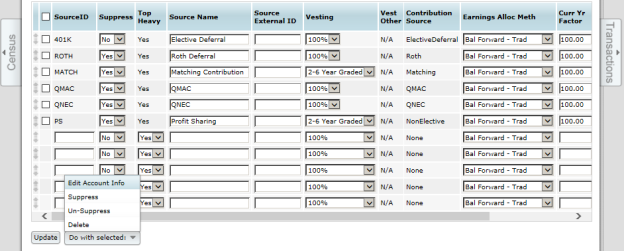
Matching Accounts
There are three possible accounts for matching contributions: "MATCH", "MATCHSH", and "MATCH100". You may or may not use all of these accounts depending on your plan specifications. The account labeled "MATCHSH" is used for safe harbor matching contributions and will be 100% vested. The Account "MATCH100" will be used if the plan has specified matching contributions that are 100% vested but other matching contributions that are less than 100% vested. The contribution account "MATCH" is the only matching contribution account that can have a vesting schedule and will be used for non-safe harbor matching contributions subject to vesting.
Add Default Sources
Clicking the “Add Default Sources” link will add all sources that are applicable to the plan, as set up in Plan Specifications. This is typically used after a plan document change, such as changing a non-safe harbor plan to be a safe harbor plan. Only sources created by the system will permit contributions in the transaction menu. To this end, if a source is missing from the source grid, it is a best practice to first review the permitted sources in Plan Specifications à General Features and Plan Specifications à Contributions, make the necessary changes if applicable; then use the “Add Default Sources” link to add the missing sources.
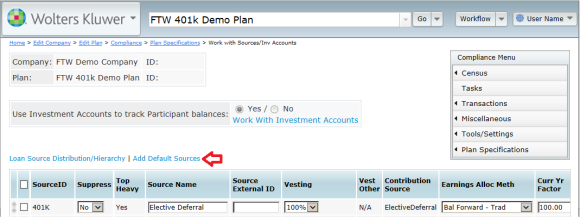
Loan Source Distribution/Hierarchy
Clicking the “Loan Source Distribution/Hierarchy” will open a box where the user will verify the sources that loans can be taken from. Set sources to “Yes” for sources that loans may be taken from and set to “No” if loans are not permitted from the applicable source. Be sure to click “Update” to save your changes. Click the Hierarchy drop down box to set up the hierarchy for loan distributions by source, again either pro rata or ordering rule. Click “Update” to save your changes, then return to the Source Setup page.
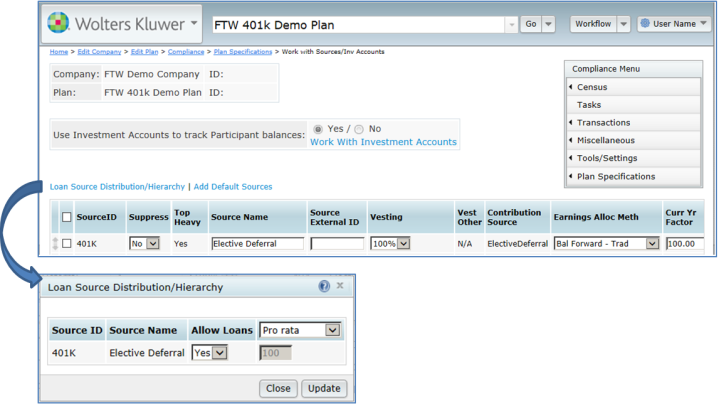
Work with Investment Accounts
In general, investment accounts should be added if you need to have the system allocate earnings and/or if you have more than one place money is held. No investment accounts are needed if uploading from only one vendor and no earnings allocation will be calculated by ftwilliam.com. If you will not be using investment accounts, set “Use Investment Accounts to Track Participant Balances” to no, otherwise set this to “Yes”. When “Yes” is selected, the “Work with Investment Accounts” link will appear. Click this link to enter investments.
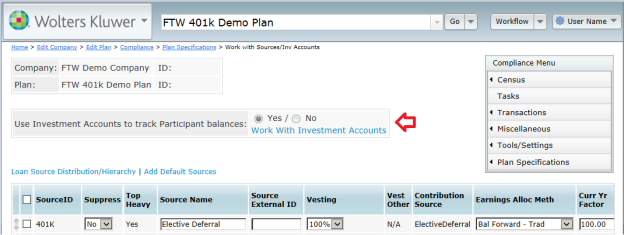
You may add each investment being used by the plan as shown in the screenshot below. A description of each of the columns follows:
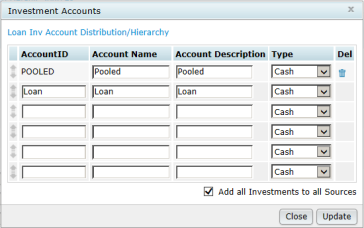
- Arrows – Click on the arrow and drag up or down to change the position of the investment.
- AccountID - this is the unique identifier for the investment used by the system. For amounts held with an asset custodian you should use “Vendor”. Other typical IDs are “Pooled” for a pooled account, “Brokerage” for a brokerage account and “Loan” for the loan fund.
- Account Name - you can assign a name to the investment; this name will be used to identify the investment on other screens and on reports. You may want to use the name of the asset custodian for the vendor account; otherwise you should use something that will easily identify the investment both to you and other system users.
- Account Description - this is a field you can use to enter more detailed information about the investment; it is not used in any other areas or reports.
- Type - select “Brokerage” for brokerage accounts and “Cash” for all other investments. “Unit” is not currently an active option.
- Del – Press the garbage can icon to delete an investment. If the icon does not appear for an investment, this means that the user has not yet pressed the “Update” button and can just erase the text entered in the fields (see Loan investment in the screenshot above for an example of this).
Checking the box to “Add all Investments to all Sources”, automatically adds every investment account setup here to every source on the source page once the “Update” button is pressed. After pressing the update button, a pop-up box will appear, asking the user to confirm that they wish to add all Investments to all sources. Press “Yes” to instantly add all investments to all sources. Press “No” to cancel this operation.
Loan Inv Account Distribution/Hierarchy
If the plan is using the Loan Module you will also want to indicate which investments can be used for loan issue. Select “Yes” from the drop down box for each of the investments that can be used for loans. Note that the Loan Fund should always have “No” selected. You should also ensure that the designated loan fund is correct under “Select Loan Account”. Next click “Hierarchy” and indicate whether loans should be issued pro-rata from all applicable investments or whether the ordering rule is used. If you choose “Ordering Rule” you will need to indicate the order by using the sequence numbers.
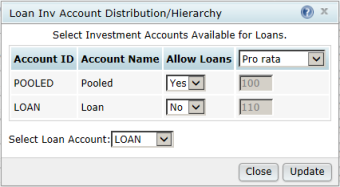
4.2. General Features
This section contains the basic information about the plan such as the plan type, plan year begin date, plan year end and original effective date. It also contains the permitted contribution sources and compensation options. For the first plan year on the system, make sure all dates are in numeric format as specified in the instructions to the left of the date field. Additionally, if you want to use employee number, rather than social security number as the unique participant identifier, you should indicate this here under “Enter ID for Participant Upload/Download:”.
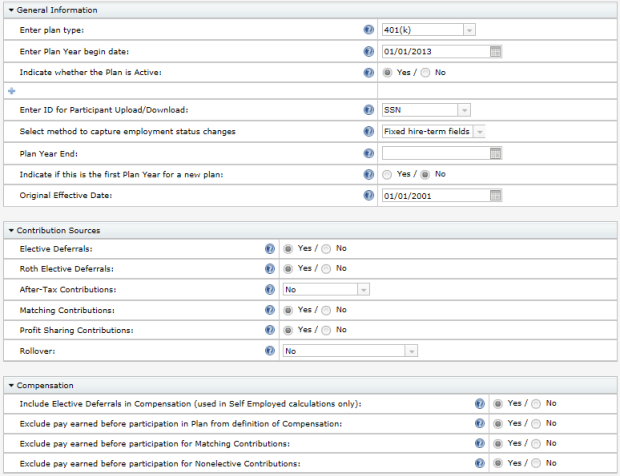
4.3. Eligibility
The Eligibility section of Plan Specifications is where the user will set exclusions (such as union or leased employees), indicate whether the eligibility computation period will switch to the plan year, review the age and service eligibility rules for each source, break-in-service rules and confirm the special participation date (as applicable to the plan). For specific information regarding each option in this section click here.
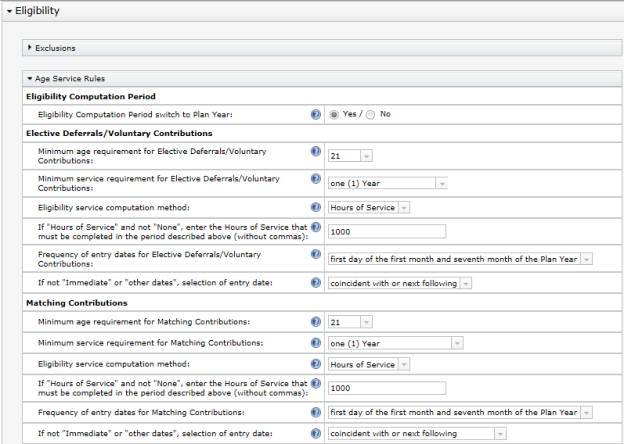
4.4. Contribution
The Contribution section of Plan Specifications is where contribution limits will be entered, safe harbor specifications will be selected and allocation requirements for sources and 410(b) corrections will be selected. This is also where the Nonelective formula can be changed. Please be sure that all contributions that should be active are selected in this section, such as safe harbor, Davis Bacon and collective bargaining arrangement (CBA) contributions. For specific information regarding each option in this section click here.
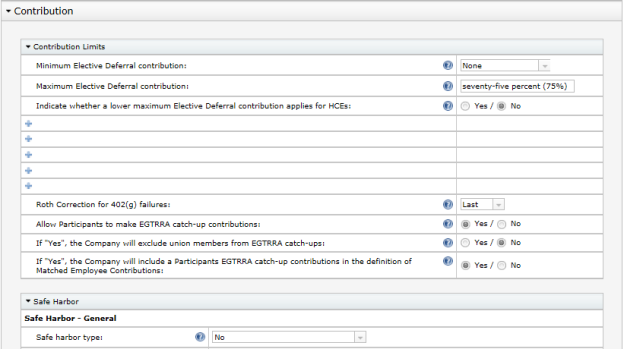
4.5. Vesting
The vesting section is where certain vesting related settings can be found, such as vesting service computation method, computation period and vesting exclusions. Additionally, this is where the global option to override prior years of cumulative years of vesting service can be set. Please note that the vesting schedule for each source is found in “Work with Sources/Inv Accounts”. For specific information regarding each option in this section click here.
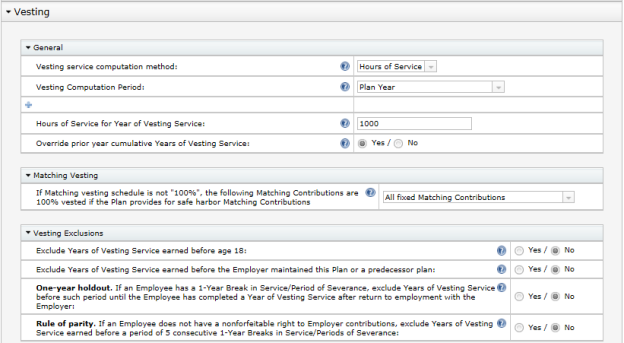
4.6. Distribution
There are three questions related to determining retirement age. Please note that these questions will be determined by the plan document.
If “Age only” applies, the system will only look at a participant’s age to determine if normal retirement age has been attained. The normal retirement age can be selected by using the drop-down box.
If “Age and Participation” applies, the system will look at both a participant’s age and years of service to determine if normal retirement age has been attained. The user will need to select the number of years a participant is required to participate before reaching normal retirement age. Note: For purposes of the Rate Group Test, the system determines participation by looking at the non-elective date of participation. If the plan is a safe harbor non-elective plan, the system will now look at safe harbor non-elective entry date to see if it is earlier than the regular non-elective date. If it is, the system will use that date to calculate anniversaries of participation. If both entry dates are in the future, the system will set years of participation to zero.
For specific information regarding each option in this section click here.

Once you have completed setting up plan specifications ftwilliam.com plan document users can check their work by using "Compare Specifications to Plan Document" from the main Compliance Menu.
Part 5: Census
The main census page and various census options can be accessed from hovering over or clicking on Census in the Compliance Menu.

From the Census web page, users can download, upload and edit census data. Users can also navigate to Other Import/Export/Reports, Portal Files and the participant master records.
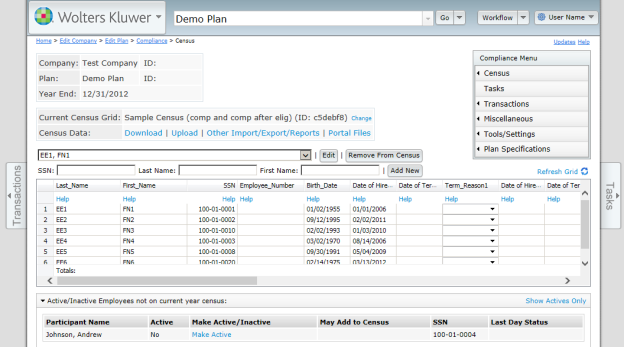
5.1. Select Census Grid
If you are setting up a new plan the first step on this page is to select the census grid for the participant data that you will be uploading. Click on the “Change” link to select, edit or change the Current Census Grid. From the drop-down box highlight the grid you want and click the “Set Census Grid” button. You will see that each of the grids available has a unique code - a combination of letters and numbers - that the software uses to identify it. You will see this code when you download the grid as described below.

We’ve created several sample “primary census grids” that we suggest you use to upload your census data. Appendix I displays a chart to help you choose the grid that is right for your plan.
In addition to the individual characteristics shown in Appendix I, all of the sample grids contain the following recommended fields:
- Last Name
- First Name
- Social Security Number
- Date of Birth
- Date of Hire 1
- Date of Termination 1
- Termination Reason 1
- Date of Hire 2
- Date of Termination 2
- Termination Reason 2
- Hours
- Statutory Compensation
- Elective Deferral Contribution
- Roth Contribution
- Match Contribution
- Safe Harbor Non-Elective Contribution
- Non-Elective Contribution
- Officer Status
- Ownership Percentage
- Family Group (for ownership attribution)
- Family Group Relationship
- New Comparability Group
If additional columns are needed or you would like to delete columns that you will not be using, it is a best practice that you copy the primary census grid that most closely matches your needs, rename that grid then make the edits.
To view what fields are available in a particular grid or to custom-design your own census grid, see the "Edit Data Entry Grids" options below. Note that only grids that contain either the SSN (Social Security Number) or Employee Number field (or both) will be available as an option to select as a data entry grid. Users can elect to use either field as the key for uploading census data via the Plan Specifications Menu, General Features/Accounts and Sources, in the General Plan Features box.
5.2. Edit Data Entry Grids
To edit a grid, click on the “Change” link next to current Census Grid or from the Compliance Menu, hover over Census and select the Create/Edit Grids option. This will open the Compliance Grids pop-up box. From here, select the grid you wish to edit (or copy, then edit) from the drop-down box, then press either the “Edit” or “Copy” button, as applicable. Users can also create their own grids from scratch by pressing the “Add New” button or delete existing grids by pressing the “Delete” button.

When the user selects the “Edit”, “Copy” or “Add New” option, the selected grid (or a blank grid if adding new) is opened.
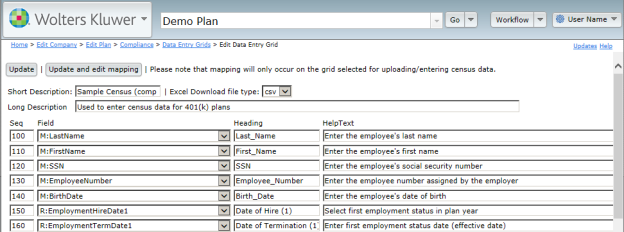
To change an existing field, use the drop-down box under the “Field” column to select a different field, then modify the heading and help text as applicable. Be sure to press the “Update” button to save changes.
To delete a column, select “None” in the “Field” column and click “Update”.
To add a column, enter a new sequence number designed to place the new column where you want it located. e.g. if you want the new column between items with sequence numbers 180 and 190, you would give it a sequence number from 181 to 189; when you click the “Update” button the numbers will be resequenced to 10 units apart. Select the column type from the Field drop-down box; the Heading and HelpText boxes will auto-populate. If you add a new field and leave the Seq ("sequence") information blank, the system will default the new field to have a Seq of 100 and place the new field at the top of the grid. Note that although the Heading and HelpText boxes do auto-populate they are editable and you can enter your own descriptions. These descriptions will be used on the spreadsheet that you download.
Please note that if you modify an existing grid or create a new grid, the first two lines (sequence numbers 100 and 110) must be last name and first name. These equate to the first two columns on the actual grid. Also, when you modify a grid it will have a different unique identifier that is automatically assigned.
5.3. Mapping of Data Entry Grid
The system can custom-map fields and do simple calculations on fields. To get to the mapping information for a field, select the census grid that will be used for the plan from the "Data Entry Grids" page. Once you have the census grid selected, you should be at the "Edit Data Entry Grid" page and will see a button to "Update and Edit Mapping". Once you select the button to "Update and Edit Mapping", you will be taken to the "Update and Edit Mapping" page. Here, you will see most fields available in the system (under "system Field") and you will be shown any default field mapping if any. For example, as a default most compensation fields are mapped from the field "Compensation_Statutory".
You may only map fields on the selected census grid. The census data scrub does the mapping as specified in the selected census grid. No other mapping is ever done. A grid used in the Other Import/Export/Report Menu does NOT map.
When mapping on the “update and edit mapping” screen, the only data fields available for mapping in the “grid field” drop-down are those fields that are listed on the “edit data entry grid” screen. For example in the screen shot shown, the “Service_EligibilityHours” is a column that’s on the census grid. The drop-down boxes below indicate other fields that are being mapped from it, i.e. “Service_EligibilityHoursInitial”, “Service_VestingHours” and “Service_ParticipationHours” are all fields that are being mapped from “Service_EligibilityHours”. To remove this mapping, select “None” from the Grid Fields drop-down box; to customize the mapping, select “Custom Calculation” from the Grid Fields drop-down box and enter the field names that you want to map in the Custom map column. The field names need to be separated by “+” or “-”.
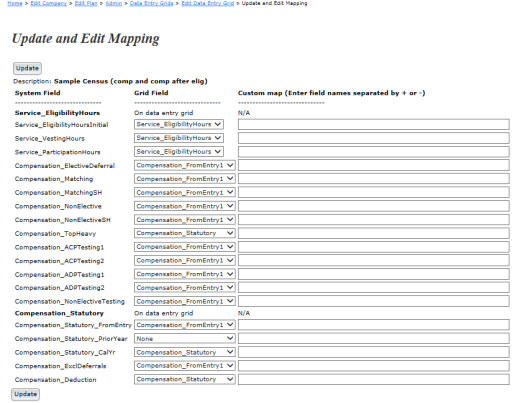
Custom calculations can be set up on the “update and edit mapping” screen by selecting “custom calculation” from the grid field column drop-down list and then copying data elements (from the system field column) to the custom map column and separating the fields with a “+” or “-” sign. For example, if you collect "Census_UDFNumber1" on the census grid and it represents a form of "other pay" that is excluded for the purposes of Nonelective contributions, a custom calculation for "Compensation_NonElective" could be done where, on the "Update and Edit Mapping" screen, the "Grid Field" selected would be "Custom Calculation" and "Compensation_Statutory-Census_UDFNumber1" would be entered in the custom map column. When the census scrub is run, the data collected in the grid will be used to calculate the Nonelective Compensation.
5.4. Edit, Download, Upload Census
Having selected the format for uploading/viewing your participant census data, you are ready to load your data.
Edit Census
Data can be edited directly within the census grid - to update a field, simply double-click on it and enter the new information. The system automatically saves your edits. To add a participant, enter the SSN or Employee ID number in the box above the grid and click on "Add New". You will then be able to enter data in each of the fields for the new participant. Generally however you will want to upload data into the grid. The system will try to ensure the formatting is within certain limits for certain fields. If you enter data with incorrect formatting you may see the error "Not Valid" and the field will not be updated. If you enter a date as "1/1/01", the system will update the date to the correct formatting ("1/1/2001").

Download Census
Pressing the “Download” link from within the census or from the Compliance Menu under the Census heading will bring up a pop-up box with three download options.
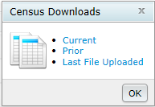
Current Census
In general, before uploading a census, you will need to download the blank census so that your spreadsheet will have the correct formatting. The field names must match those on our system and be in the same order. The ID number of the selected census grid also must match the number in the first column of third row of the spreadsheet (cell A3) that will appear in the downloaded spreadsheet file. This means that if you add, remove, or move a column from the selected data entry grid you generally must download a new Excel file for your census. In addition, in order for the file to be re-uploaded by the system, it must be saved in .csv format.
Another use for downloading census would be after census scrub or after other changes have been entered into the system via a portal or the "Edit Census" link. Items in the census may be updated by the system (during a data scrub - you will be shown errors if a census item is updated) or by the user. You can download the latest version of the census by clicking on "Download Census".
Note that if changes were made to the census on the system you can still get a copy of the census that was last uploaded to the system (would not include any subsequent changes made by the system or the user) by clicking on the "Print Reports" link across from the "Do Census Data Scrub" link on the Compliance Menu page. This will open a "Report Menu" screen where the last option "Download Most Recent Census" will generate a copy of the census that was last uploaded to the system.
NOTE: even if you plan to enter data on the excel sheet and upload data back to the software, you may want to consider clicking Edit Census and on the Data Entry Grid page that appears add a participant’s SSN. This will give you a drop down lists showing permissible entries if applicable as well as access to the help buttons for each column.
Download Prior Census
Clicking on the “Prior” link will generate a copy of the census prior to any changes last created by the "Do Census Data Scrub" link.
Last File Uploaded
The system saves the most recent census uploaded. Even if changes are made to the census on the system (via a data scrub or user entry), you can download a copy of the census as it was last uploaded.
Upload Census
When initially adding census data to the software it is generally easier to upload it. It is a best practice to download the grid to Microsoft Excel format, enter your data then upload the spreadsheet.
Prior to uploading the census, it is highly recommended that the data you receive from your client is reviewed for completeness and accuracy. For example, if the census has both statutory compensation and statutory from plan entry compensation, both fields must be completed for all participants.
To upload the census click the “Upload Census” link, select the file to upload, enter the total number of rows in the census file (if the last row ends on row 50, enter 50), then press “Submit”. Note: Users may enter more rows than there are census records, but not less. For example, if the last row ends on row 50, users may enter 100.
Upon uploading the census, the Spreadsheet Upload Results screen will:
- Show the number of rows selected for upload
- Show the total number of records to be added
- List participants with new records
- If no census data has been uploaded for the plan year, all records in the spreadsheet will be listed as new records.
- If the user has already uploaded data for a plan year, and needs to re-upload the data, the user will only see new records listed if additional participants were added to the census after the initial census data upload.
For first census year, indicate whether eligibility dates should be reset
If this is the first plan year on the FT William system, you will have the option to have the system clear out all of the status fields that the system calculated after the census was previously uploaded and the data scrub was run. This is a handy tool to use if invalid data, such as an incorrect termination date or hire date was previously uploaded.
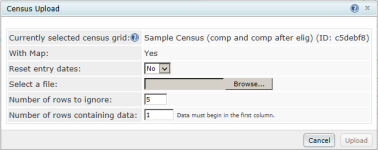
Retain prior year codes
For years subsequent to the first plan year on the system, users have the option to either copy the following status fields from prior year or upload with the census:
- Ownership percentage
- Family code
- Family relationship
- Officer status
- New comparability group number
- Employee class
- Employee class other
- Note: The system defaults to “Yes” to have the prior year data pulled instead of the census data. If “Yes” selected, data for the seven fields from the prior year will overwrite data for those seven fields even if that data is in the current census being uploaded. To have the system use the data in the census, simply set the override to “No”.
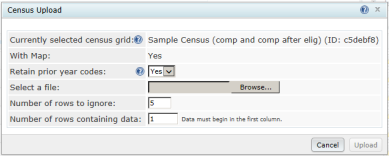
Upload file name
Click the browse button to search your computer for the census file you wish to upload. Please note that the census file must have been saved as a .csv file. Also note that the format must match the format in the grid selected from the Work with Data Entry Grids screen.
Number of rows to ignore
The number of rows to ignore defaults to 5 indicating that the participant data starts on Row 6; if you have made any changes to the top of the spreadsheet you need to adjust this number accordingly. Please note that there is a number in the third row that must not be removed or changed. This number tells our system what data will be in each column.
Number of rows containing data
You must also enter the approximate number of rows containing data - you may over-estimate the number of rows but not underestimate. (Once the system reaches the number of rows you entered a blank row or an invalid Social Security/employee number, the system will stop uploading).
Submitting the file and reviewing results
After clicking on "submit", you will be taken to the "Spreadsheet Upload Results" page. If your upload was successful, the system will display the number of records added. If your upload was not successful, you will see an error message. The most common error involves not having the correct census ID number in cell A3 of the spreadsheet (see the section "Download Census" above for more information).
If you click on the "return" link from the "Spreadsheet Upload Results" page, you will be taken back to the main “Compliance Menu” page and be prompted to run the data scrub.
For some fields only a certain number of entries will be valid. These fields appear as drop-down boxes in data entry grids on the system. Upon upload, the system will try to match the text in a particular field to the correct field value. For example: the field "Officer" has two possible values: "Yes" or "No". If you upload a census with "yes" (all lower case) or even simply "y", the system should identify that the value of that field is "Yes". Of course, if there are multiple values that begin with the same letter, you will have to enter more of the beginning letters of the field to have the system recognize the correct value.
You can effectively start over for a plan year by uploading a new census. This will clear out all the "R" (regular) field types on the system for the applicable plan year end. This will also clear out any errors that appeared after a census data scrub. Master file data will not be cleared out by uploading a new census unless you are directly uploading master file information (i.e. participant’s address or earliest date of hire).
5.5. Other Import/Export/Reports
Other Import/Export/Reports can be accessed from the Compliance Menu by hovering over Census and selecting Other Import/Export/Reports or from within the Census screen, by clicking the Other Import/Export/Report link.
Click here for more information on adding historical data
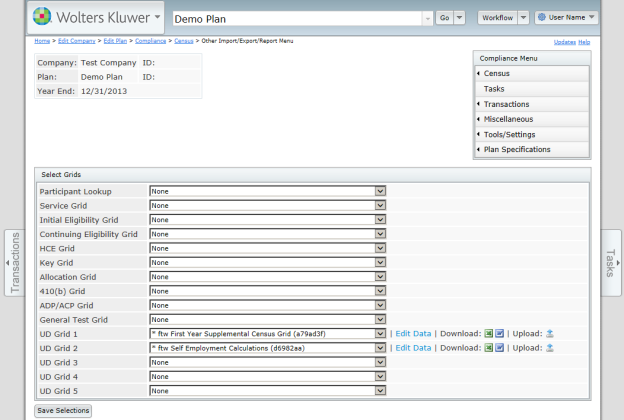
Most plans will need other information entered into the system beyond the census data, at least in the first plan year. For example, if you are running the Top Heavy test you will need to add information about prior year in-service distributions using a supplemental grid in the Other Import/Export/Reports menu. There are several * ftw grids that we suggest you use to view or edit supplemental data. You can import or directly enter data that does not appear in your census. In general you should first upload a census for the plan year, then enter other information under the Other Import/Export/Reports menu and then do a census data scrub.
Note that "Upload" will not be an option if the selected grid does not have SSN or employee ID information and you will instead see "N/A - no SSN" where "Upload" would normally appear. If you have a data grid that you would like to use for upload and need to add a SSN or employee ID field, you can edit the grid in the Work With Data Entry Grids menu.
If you wish to add additional historical data to your census, a useful grid to add for a first year plan is “Sample Census Supplemental with Disagg No OR” – this grid is generally added from the “UD Grid 1” drop-down box; it allows you to enter supplemental data for prior years of service and in-service distribution amounts for Top Heavy testing. There are two options to upload data into the system (see Mapping for more info on mapping):
- Upload No Map: Data uploaded will not be mapped. The system will only use the data fields uploaded.
- Upload with Map: The system will use the data fields uploaded and will do any mapping as set up under the Mapping options for the census grid selected.
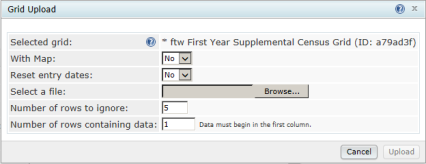
Data Review / Data Export
You can export/download information in any selected grid to an Excel file or simply review the data in a grid online.
For example, after doing a census scrub, the system will determine whether an employee is a key employee. You may wish to view more information about a particular employee to better understand why they were determined to be / not be a key employee than is provided in the standard Census Data Scrub HCE/KEY Status report. All of the fields that are relevant to a key determination are provided in the default "Key Data" grid. By entering the Other Import/Export/Report Menu after a census scrub and selecting the "Key Data" grid, you can see whether an indicator used for the key determination was correctly entered (for example, family status may not have been entered correctly and this information does not appear on the Census Data Scrub HCE/KEY Status report but does appear in the Other Import/Export/Report Menu "Key Data" grid).
User-Defined Reports
You can add a grid to create and print custom reports to a Word document or Excel file. Firstly you would need to set up a grid in the Work with Data Entry Grids menu so that it has the information you want reported in the order you would like it to appear. You can then print the report from the Other Import/Export/Reports Menu.
Several sample grids are supplied with the Compliance software. All grids can be customized under the Work with Data Entry Grids menu. All grids for your company code’s log-in (and division, if applicable) will be available in this menu. Before you can work with a particular grid, you will have to select the grid from the drop-down box and click on "select grids". This allows you to set up variations of the allocation grid, for example, that you can select for different plans.
NOTE: We strongly suggest that you make a copy of any sample grid you wish to change (select the grid, click "Copy This Data Entry Template" and give the new grid a custom name).
Appendix I contains suggestions for supplemental grids that are available for extracting additional data on the Other Import/Exports/Reports menu.
Participant data
This link will open the "Participant Menu" window with the following additional options described in more detail below (each will open a window with a check-list of fields and their corresponding values).
- Master File: Address, entry dates for contributions and overrides, and vesting years of service (YOS).
- General Status: Hire and termination date(s), employee class and status, ownership, key/HCE determinations, in-service distributions for past 4 years
- Eligibility: Years of service for contributions, catch-up eligibility
- Compensation: Shows compensation for contribution types and other purposes
- Contribution: Contribution amounts for all types of contributions, excess elective deferrals
- Other: Actual deferral and contribution rates, ADP/ACP failure data
The Participant Menu also has options to "Print Master File Data" or "Print all Participant Data" to a Word document (printing all Participant data will create a checklist-like Word file with all the participant data for a participant - typically creates a 7-page Word document in a check-list format).
Eligibility / Vesting / Benefit History
These three grids all work in a similar manner. The grid shows the years of service and hours of service earned for each computation period year in the system as well as status change dates. The following example will illustrate how these grids operate:
A sample Eligibility history link is shown below for the 2013 testing year. The first field shown is the "Comp Period year End" which shows the computation period year end for which the status was calculated. This person was hired 1/1/2001 and for the computation period ending 12/31/2013, he completed one year of service.
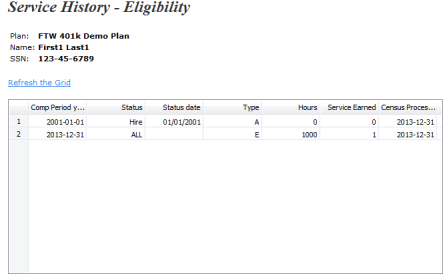
The next three columns taken together show the status, status date and type of record shown. The field "Type" indicates the type of status. There are two main categories of status types:
- A: General status change with a status of hire or term. "A" status types will not have corresponding hours of service.
- E, V or B: "E" = eligibility; "V" = vesting; and "B" = Benefit. These status types will have corresponding Statuses to indicate what type of contribution they pertain to ("ED" - elective deferrals, "MT" - Matching, "NE" - nonelective, or "ALL" - all contribution types).
The hours of service is displayed, typically taken from the census grid, and the service earned will indicate the years of service earned for the computation period.
5.6. Portal Files
Part 6: Select Task
6.1. Scrub/Eligibility
Scrub/Eligibility Parameters
Click on the Scrub/Eligibility row to expand and view the parameters here. Within this section are the global eligibility overrides, HCE/Key overrides and limit overrides. For specific help on each question within this section, click here.
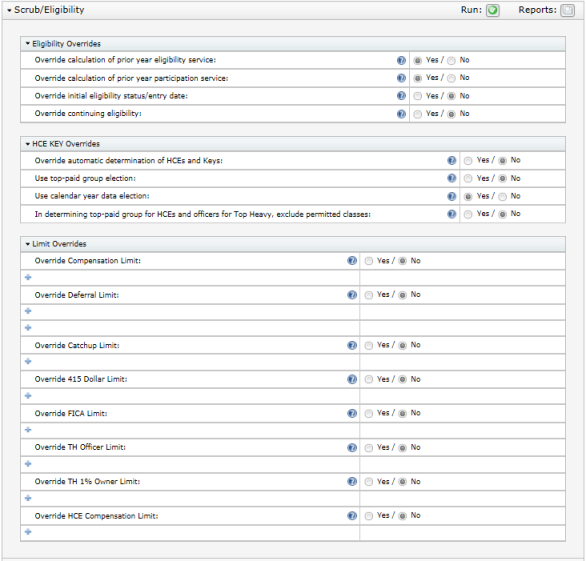
Scrub/Eligibility Results
When the run button is pressed, the system does a large number of calculations/determinations. Using census data and any supplemental data you provide, plus prior year data and service history (if available), it will attempt to calculate/determine the following:
- Eligibility
- Entry dates
- Catch-up contributions
- HCE/key determinations
- Edit checks
- Field mapping
If the census scrub runs and a data element needed to do calculations on the system is not on the census grid and not mapped, the system tries to find the data somewhere else. For example:
- If service_eligibilityhours is on the grid, but service_vestinghours is not on the grid and not mapped, the system will populate vesting hours with eligibility hours and will generate a warning to let you know that the vesting hours of service has been defaulted to be the same as eligibility hours of service;
- If prior year compensation is missing from the census or from a supplemental census, the system will use current year compensation for prior year compensation and generate a warning.
The warning lets you know the substitution was done and you should confirm and correct as needed.
Below is an explanation of each of the boxes you may see on the "Census Data Scrub" page:
Suppressed Errors/Warning
You may suppress all warnings by clicking on the “Suppress” link located to the right of “Suppress all Warnings”. You may suppress errors and/or warnings individually by clicking on the “Suppress” link to the right of “Suppress Individual Errors/Warnings”. This will open a list of each individual error and warning that is available and you can go through and suppress any you do not wish to see.
Plan Errors/Overrides
This box shows plan level errors and any applicable overrides that may apply to the plan. The overrides shown usually come from plan specifications although some may indicate that the system is calculating a field for all participants because no data was provided.
Summary of Participant Errors/Warnings/Overrides
This box shows a summary of the number of unsuppressed errors and warnings that are applicable for each participant. You can click on the name of a participant to go to more information on that participant.
At the top of this box is a link to “Clear All Participant Errors/Overrides”. This gives you the option to clear the errors and warnings for all participants instead of suppressing the warnings. We would strongly encourage suppressing errors instead so that you can still review them for troubleshooting in the future.
Errors listed for each Participant
Each Participant is shown in detail. If a default answer is used to complete a field, the default will be shown. The "Type" column will indicate whether it is an Error ("E"), Warning ("W") or Participant Level Override ("O").
Suppressed Errors/Warnings
This box lists the errors that have been suppressed. If you would like to reactivate/reapply the error, you can click on "A" under activate to have the error listed for the applicable participants.
Scrub/Eligibility Reports
Back at the "Compliance Menu" page, the "Print Reports" button across from the data scrub allows you to print or save the following reports in either Microsoft Word or Excel:
- Eligibility Status
- HCE/KEY Status
- Key Status Next Year
As is the case for all the default reports on the system, if there is information you would like to see that is not in one of the predefined reports for the data census scrub, go to the Other Import/Export/Report Menu and review some of the more detailed report grids there or set up your own report under the Work With Data Entry Grids menu.
6.2. Allocations
Set Allocation Parameters
Clicking on the Allocation row will expand the Allocation Parameters. Here you can enter details about how allocations should be handled in the plan. The options you see will be based upon the plan specifications (for example, if matching is not permitted in the underlying plan specifications, then options for matching allocations will be grayed out and you will not be able to select from them).
Allocation Overrides
If employer contributions will be uploaded (not system calculated), the source specific overrides should be used. The overrides must be set prior to running the data scrub. If the employer contributions are uploaded and the overrides are set to no, the data scrub will zero out all of the contributions uploaded with the census. If this happens, set the source override (match or profit sharing, for example) to yes. Then re-upload the census data and re-run the data scrub.
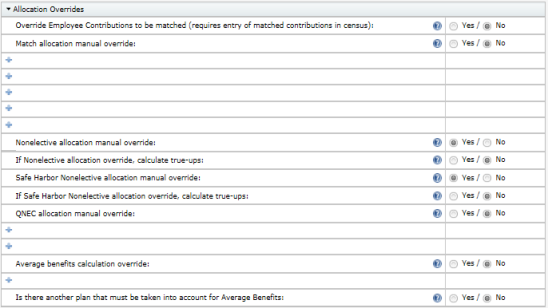
Matching Allocation
This section is where the safe harbor match and discretionary match formulas will be entered, as applicable, as well as any plan limits related to the match. The match formula (both safe harbor and discretionary) can have up to three rates. Below is an example of a discretionary match formula, where 100% of compensation will be matched on the first 3% of compensation deferred, plus an additional 50% will be matched on the next 2% of compensation deferred. Please note that in the second tier, 5% is entered as the maximum, not 2%.

Top Heavy Allocation
Questions related to top heavy minimum allocations will be found here. The system will display the top heavy status for the current plan year. This is based on the prior year top heavy test or the Top Heavy Parameters, if overrides are used. If the plan is top heavy as of the Determination Date (displays Yes), a top heavy minimum allocation will be due. If this is “No”, then no top heavy minimum allocation is due for the current plan year. Also in this section is where the top heavy minimum allocation override is found. The top heavy minimum override must be set to yes and a percentage entered if the plan has self employed persons.
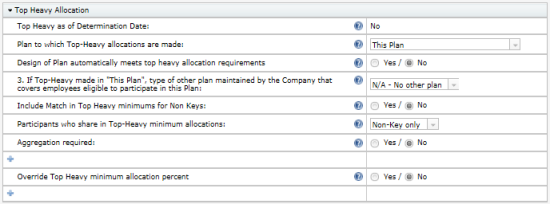
Nonelective Allocation
Both safe harbor and discretionary nonelective allocation formulas will be entered in this section. The safe harbor non-elective allocation must be entered as a percentage (cannot be a dollar amount). Regular pro-rata and integrated nonelective allocations can be entered as either a dollar amount or a specified percentage. If the plan has an age weighted allocation, the user must have a dollar amount entered. Age weighted allocations cannot be allocated using percentages. New comparability formulas will be allocated by groups. Users can enter a dollar, a percentage or the greater of a dollar or percentage for each group.
When “Dollar” is used, the dollar amount entered will be allocated across all participants, so that the total allocation equals the dollar amount entered here. When “Specified” is selected, the percentage entered is the percentage of compensation each participant will receive.
For specific help on each question within this section, click here.
Run Allocation
Clicking on the Allocation “Run” button from the tasks page will calculate employer contributions based on the allocation parameters. A pop-up box will open and display errors and overrides if applicable.
Allocation Report
The allocation report and integrated report (if applicable) are available via the reports button on the tasks webpage or from within the results window.

If a contribution type is not applicable to the plan and the account is appearing on the allocations report, you can suppress the account under the Accounts and Sources menu in the Plan Set Up options.
As is the case for all the default reports on the system, if there is information you would like to see that is not in one of the predefined reports, go to the Other Import/Export/Reports Menu and review some of the more detailed report grids there or set up your own report under the Work With Data Entry Grids menu.
6.3. Combined Test
The “Combined Test” is a series of tests that includes the 415 Annual Additions Test, 410(b) Coverage Test, Deduction Limit test and the Compensation Test (as applicable to the plan).
Set Combined Test Parameters
Clicking on "Combined Test Parameters" from the Compliance Menu page, will take you to the "Combined Testing Parameters" screen. Here you can enter details about how the Combined Tests should be handled in the plan.
On the "Combined Testing Parameters" screen there are a number of options regarding Aggregation/Disaggregation that will apply to the ADP/ACP tests and the General Test as well as those covered under the Combined Test. These answers will be displayed in the ADP/ACP and General Test Parameters screen but can only be modified in the Combined Test Parameters. For step-by-step instructions on aggregation or disaggregation, please see the Special Topics section.
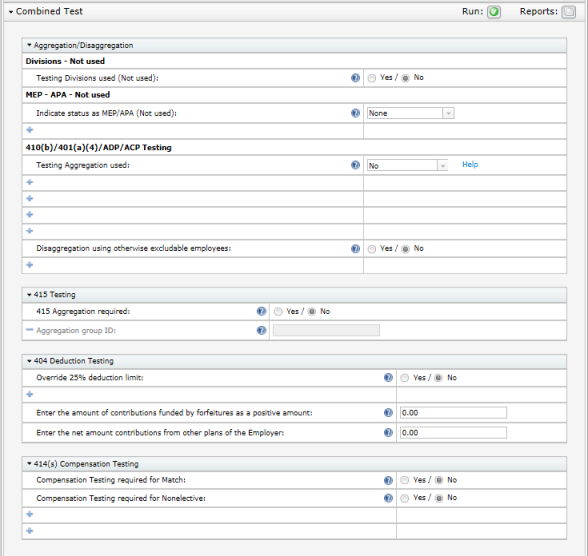
For specific help on each question within this section, click here.
Do Combined Test
Click the "Run” button next to the Combined Test to run the 415 Limit test, 410(b) Coverage test, and the 404 Deduction Limit and 414(s) Compensation tests. You will be taken to the "Combined Test" page where results are shown for each of these tests. 410(b) ratio percentage test details will be shown for each contribution type.
Combined Test Reports
You can print the report for each test performed directly from the "Combined Test" page or once you return to the main Tasks page, click on the "Reports" button to view the test results report.
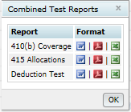
As is the case for all the default reports on the system, if there is information you would like to see that is not in one of the predefined reports, go to the Other Import/Export/Report Menu and review some of the more detailed report grids there or set up your own report under the Work With Data Entry Grids menu.
6.4. ADP/ACP Test
Set ADP/ACP Testing Parameters
Clicking on ADP/ACP Test from the Tasks page will expand the ADP/ACP Parameters. Here you can enter details about how ADP/ACP Testing should be handled in the plan. This is also where prior year testing data can be entered if prior year testing is selected and it is the first year on the system. Note that if you want to use disaggregation of otherwise excludable employees, you select this option on the “Combined Test Parameters” screen as it will apply to all of the required tests.
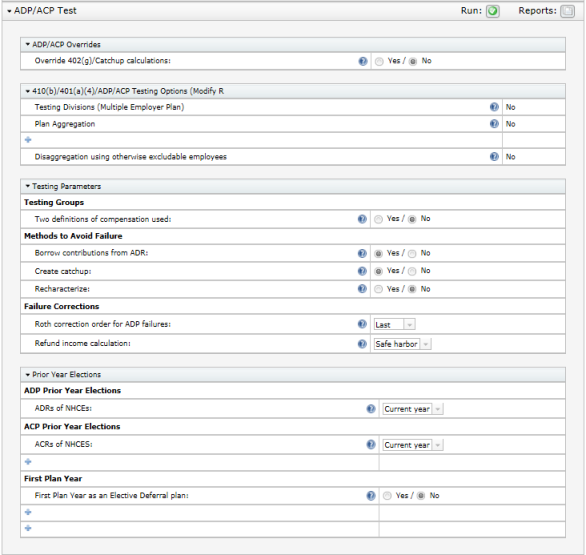
For more information and examples, click on the help button for a particular question.
Run ADP/ACP Test
Clicking the "Run” button next to ADP/ACP Test from the Tasks page will calculate the ADP/ACP Test based on the testing parameters. Test results will be displayed (PASS/FAIL) in a pop-up window. ADR (Actual Deferral Ratio), ACR (Actual Contribution Ratio), ADP (Actual Deferral Percentage) and ACP (Actual Contribution Percentage) will be shown if applicable for nonhighly and highly compensated employees.
Please note that if you are using disaggregation of otherwise excludable employees for the ADP/ACP tests, you will see three rows of results on the ADP ACP Test Results screen; if either test fails, you will need to select a correction method in the “testing combination to correct” drop-down box. You can either select “ExclNHCE:1” - this corrects based on the test excluding NHCEs who have not met statutory eligibility. Or you can select “Two Tests:1” which runs two separate tests, on those not excludable and on those excludable, and corrects based on those results. You should make this selection before printing the ADP/ACP report.
- “DisaggOver” - this shows the test results for the group who are not excludable.
- “DisaggUnder” - this shows the test results for the group who do not meet statutory eligibility.
- “ExclNHCE” - this shows the results excluding only the NHCEs not meeting statutory eligibility from the test.
Of course if there are no excludable HCEs, lines one and three above will show the same results.
To correct a failed ADP or ACP test follow the steps below. On the ADP/ACP Test Results screen you will see a summary of the outcome of test. If either test has failed you will see the correction options available.
Do Refunds/Calculate Catch-ups
Clicking this link will display the amount of refunds to HCEs necessary to pass the test. If any of the HCEs targeted to receive a refund are catch-up eligible and have not used their entire annual catch-up amount, then as much of the refund as possible will be recharacterized as catch-up. Amounts that do need to be returned will be displayed in the ADP (or ACP) Refund Earnings box. You can calculate earnings either by entering the amount of the beginning balance plus contributions during the year, and the earnings for the Elective Deferral or Roth source for the HCE, then click the “Update earnings” link and the software will calculate the amount of the earnings to be refunded. Or, if you have transaction files in the Transaction Menu area, you can click the “Update ADP/ACP refund earnings with transaction data” link to calculate the earnings.
Estimate QNECs
You should also see the option to estimate QNECs so long as the plan is set up to allocate QNECs to NHCEs only; this is in the Eligibility section of Plan Specifications. You can click the “Estimate QNECs” link to see the percentage required for each NHCE; the total cost of the QNEC is also displayed. Note that the allocation formula for the QNEC is selected in Plan Specifications under Contributions. Pro-rata, Bottom-up (Targeted) and Fixed Amount formulas are all available.
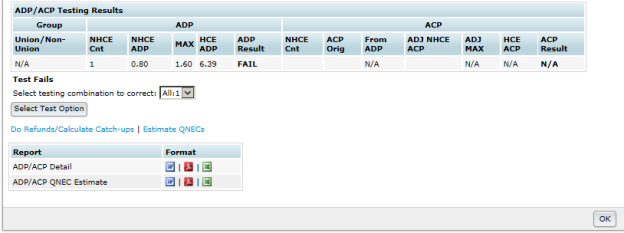
ADP/ACP Test Report
You can print the detail report, test corrections report and QNEC reports directly from the "ADP ACP Test Results" page or once you return to the Compliance Menu page, click on the "Reports" button to view the ADP/ACP test results.
As is the case for all the default reports on the system, if there is information you would like to see that is not in one of the predefined reports, go to the Other Import/Export/Report Menu and review some of the more detailed report grids there or set up your own report under the Work With Data Entry Grids menu.
6.5. General Test
Set General Test Parameters
Clicking on "General Test" bar from the Tasks page will expand the "General Test Parameters". Here you can enter details about how the general test should be handled in the plan.
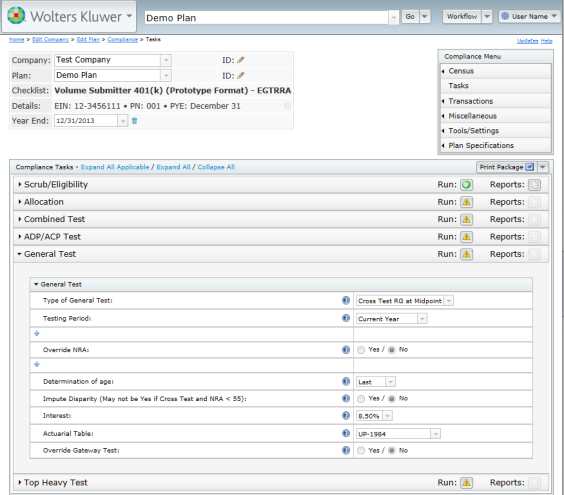
The General Test options affect the rate group test, average benefit test and/or gateway test.
Type of General Test:
- Cross Test - Selecting Cross Test will run the general test based on the allocation projected to retirement age. This is the system default.
- Standard – Selecting Standard will run the general test using actual allocation rates (does not project benefits into the future). Please note that the gateway test is not required to be met using this option.
Testing Period:
- Current Year – Selecting current year will run the general test based on current year allocations. This is the system default.
- Account Balances – Selecting Account Balances will run the general test using participant’s account balances divided by the number of participation years of service.
- A participant’s account balance is calculated when statements are run.
- Transactions must be uploaded in the system for the current year.
- Correct end balance batch must be posted for the current year.
- Statements must be run to have the system pull the correct account balance data. Note: statements must be re-run any time changes are made to participation years or when balance information is changed.
- The account balance is split by source type as follows:
- GenTestAllocationPermDisp GenTestAllocationNoPermDisp, GenTestAllocationOtherSource GenTestAllocationOtherPlan as applicable
- Participation years of service
- Go to Other Import/Export/Reports and select “Sample Census Supplemental w disagg no OR with prior participation yos (638be22)” in one of the user defined spots and press update. Then press the “Edit Data” link next to the grid. Enter the number of prior years of participation each participant has earned for Service_ParticipationPrYrCummMT and Service_ParticipationPrYrCummPS. If the values are different, the system will select the higher number.
- Note: If it is the first year on the system you will not need to set the individual participant overrides to “Yes” since the global override is automatically set to yes. If it is not the first year on the system, you will need to set the individual participant override (Service_ParticipationPrYrCummOverride) to “Yes” for all individuals you will be overriding. Or, you can set the global override for prior year participation service by clicking Scrub/Eligibility Parameters and setting Override calculation of prior year participation service to yes.
- After all changes are made to prior year participation service, run the data scrub, then run one of the statement options in the Transactions menu.
If Testing Period is "Account Balances" override calc of balances:
- No – If No is selected, account balances will be pulled from the statements (after one of the Transactions options are run).
- Yes – If Yes is selected, the user should go to Other Import/Export/Reports and select Sample General Test Acct Bal grid. The following fields are added together and will need to be changed (as applicable). Note: these fields are normally system generated as described below, but once you set the override to yes, you can just overwrite the data in these fields.
- Acct Bal Non-elective Perm Disp: Non-elective contributions.
- Acct Bal Non-elective Perm Disp – Adj: Enter any distributions (as a positive amount) from the non-elective source here.
- Acct Bal Non-elective No Perm Disp: Safe harbor non-elective contributions, QNECs.
- Acct Bal Non-elective No Perm Disp – Adj: Enter any distributions (as a positive amount) from the Safe harbor non-elective contributions and QNEC source.
- Acct Bal Other Source: 401k, Roth, Match, Safe Harbor Match
- Acct Bal Other Plan: Balances from other plans (ex. Defined Benefit)
Override NRA:
- No – If No is selected, the normal retirement age that was selected in Plan Specifications will be used in the general test.
- Yes – If Yes is selected the normal retirement age selected in the following question will be used in the general test.
Determination of age:
- Last - Selecting Last uses a Participant’s age at the end of the Plan Year.
- Nearest - Selecting Nearest could skew test results, depending on birth dates of HCE and NHCE. The testing age for anyone born in the first six months of a Plan Year (assuming a calendar year plan year) is the age attained during the Plan Year. For anyone born after June 30th, the testing age would be attained age on the next birthday (January 1 to June 30 of the next Plan Year).
Impute Disparity (May not be Yes if NRA < 55)
- Yes – Selecting yes will run the general test with imputing disparity.
- No – Selecting no will run the general test without imputing disparity. Note: Imputed disparity cannot be used if NRA is less than 55.
Interest: The interest rate is a factor in cross testing when projecting the allocation to retirement age. A higher interest rate will produce a larger value at retirement age.
- Select "7.5%", "8.0%", or "8.5%".
Actuarial Table: Actuarial tables determine one of the factors used in cross testing when projecting the allocation to retirement age.
- Select one of the actuarial tables listed from the drop down box.
Override Gateway Test
- No: This is the system default. Selecting No allows the system to calculate the gateway test.
- Yes: Select "Yes" to override system calculated result. This will show an automatic PASS result.
Run General Test
Clicking on "Run” General Test from the Tasks page, will calculate the General Test (Rate Group Percentage Test and/or Average Benefit Test, if applicable) based on the parameters. You will be taken to the "General Test" page where testing parameters will be shown as well as the Rate Group Test, Gateway Test and Average Benefit Test (shown at right). You can print the test report directly from the "General Test" page or once you return to the Compliance Menu page, click on "Print Reports" to view allocation calculations and eligibility for each contribution type.
If you fail one or more of the tests, the Auto Solve options to correct a failed test will be displayed on the General Test screen. You will see two options to correct each test - either to increase amounts given to NHCEs or to decrease amounts to NHCEs. Clicking one of the links will show you the change required to pass the test and you will see a “View Changes” link that you can click to see the cost or the amount of the reduction for each group.
For each failed test you can select the preferred correction method and click “Revise Allocations and Re-run Test” to correct.
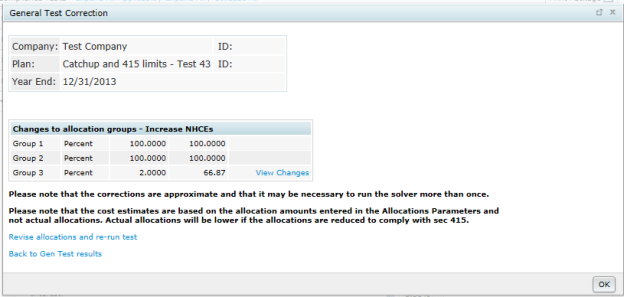
General Test Reports
The Rate Group Test and Average Benefits Test reports can be printed directly from the General Test results screen or accessed via the Reports button on the General Test bar. The Reports feature allows you to review the details without redoing the task.
As is the case for all the default reports on the system, if there is information you would like to see that is not in one of the predefined reports, go to the Other Import/Export/Report Menu and review some of the more detailed report grids there or set up your own report under the Work With Data Entry Grids menu.
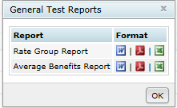
6.6. Top Heavy Test
Click here for help troubleshooting top heavy testing.
Set Top Heavy Test Parameters
Clicking on "Top Heavy Test" bar from the Tasks page will expand the Top Heavy Parameters.
The Top Heavy calculations are run at the end of an annual cycle after allocations have been run and transactions have been posted in the system. Transactions must be up-to-date as of the determination date for the applicable testing year. Note that one of the parameters that you need to set under “Top Heavy for Next Year” is whether to use all transactions or just ending balances. Generally the software calculates ending balances from the other transactions - beginning balances, plus contributions and other gains, minus distributions, fees etc. So unless you actually have a batch of ending balances posted in the Transaction menu you need to select “All transactions other than ending balance” from the “Transactions to use when calculating Participant balances:” drop-down box.
If the employer has multiple plans the Top Heavy test must be run on an aggregated basis. This can be accomplished by entering an aggregation code, which is the same for all plans of the employer. The indication that aggregation is used and aggregation IDs are found on the ADP/ACP Test Parameters screen (the ID code is one you may make up and must be the same for all aggregation group members). If for some reason account information is not available for other plans (e.g. the plans are not on the ftwilliam.com Compliance system) you can manually enter ending balances for the other plans (Under the "Set Top Heavy Test Parameters" menu, there are fields to enter Key and Non-Key Balances for other plan).
To override the system calculation of the Top Heavy ratio, set the override at the top of the "Set Top Heavy Test Parameters" menu to “Yes”. Set the order of Top Heavy allocations and select which Participants will share in Top Heavy minimum allocations. Also, make sure that all Key Employees are identified as such, especially for the first Plan Year the Plan is on ftwilliam.com's Compliance system.
For more information and examples, click on the help button for a particular question or click here.
Run Top Heavy Test
Clicking on "Run” Top Heavy Test from the Compliance Menu page will calculate the top heavy test based on the parameters and balances in the Transaction Menu. The "Top Heavy Calculation" results screen will pop-up, containing basic top heavy status information.
Top Heavy Test Report
You can print the test report directly from the "Top Heavy Calculation" page or once you return to the Compliance Menu page, click on "Reports" to view Top Heavy Calculations. The Report feature allows you to review the details without redoing the task.
As is the case for all the default reports on the system, if there is information you would like to see that is not in one of the predefined reports, go to the Other Import/Export/Report Menu and review some of the more detailed report grids there or set up your own report under the Work With Data Entry Grids menu.
6.7. Client Package
The software allows you to select a package of reports and statements that you can send to your client; this section of the User Guide describes how to customize this package.
The steps in the process are as follows:
- Create one or more custom styles to use for all your reports and statements (or you can use one of the default styles).
- Add a default client letter that will be available for all your clients.
- Assign a style to each of your reports and statements - you do this plan by plan.
- Select which reports and statements to include in the client package - again this is done plan by plan.
- Print the package, plan by plan.
Select Reports
Click on the arrow next to Print Reports and press the “Select Reports” option to identify what reports to include in the client package.
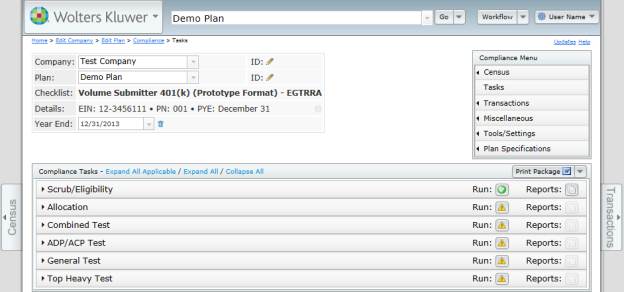
The first box on the left “Edit Client Letter” is used for the cover letter that is included with the client package. You will see a link: “Update Default Letter” at the top of this box; clicking this link will populate the box with the text entered for the global client letter on the Edit/Create Custom Styles screen. You can now customize the letter for this particular client.
The first box on the right, “Prepared By” will feed to the cover page for the client package. You can add or modify your firm name in this box to determine how the name is displayed on the cover page, which appears after the cover letter and before the table of contents in the package. Note that first entry that you make to this box will populate globally, across all plans. Any changes you make subsequently will only be made on a plan by plan basis.
Next you can indicate which reports and statements you want to include in the client package by adding a number in the box on the right for each report you want to include; the number indicates the order that you want the reports to appear in the package. The cover letter will always be first followed by a Table of Contents. If you want the Eligibility Report to appear first, enter “01” next to it. Enter “11” next to the report you wish to appear second and so on. These numbers do not have to be consecutive; the software just looks at the value and orders the reports based on the relative value. Using numbers that are a few units apart allows you to more flexibility to change the order of the reports, or add additional reports to the package at a later date.
Please note that there are two alternate formats for participant statements. One is the Individual Participant Statement, a one page per participant summary of activity, and the second is the Custom Participant Statement which is typically is a two page statement and includes the following:
- An additional section showing a “Your account at a glance”.
- A second custom message option - all messages are added on the “Edit Print Styles” screen described above.
- Separate tables showing the breakdown of assets by investment and by source.
- Available in portrait format only.
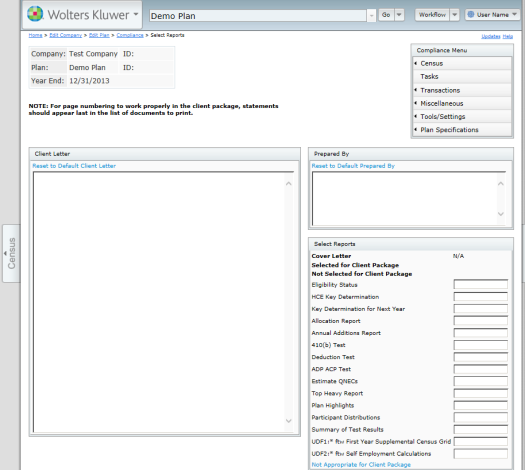
Print Package
To print your reports package, after you have indicated which reports and statements to include, return to the main Tasks page and click the “Print Package” button. This will generate a document in Microsoft Word© containing all the reports and statements that you selected for the package. Note that it is still editable - you can make changes to the formatting if you wish. Once the package is as you want, you can print it, or send electronically to your client. To print in pdf format press the arrow button next to the “Print Package” button and select the pdf option.

Part 7: Transactions Menu
The Transactions/Statements menu can be accessed either by using the tabs on the side of the Compliance software or by clicking “Transactions” from within the Compliance Menu in the upper right corner of the Compliance software. This is where users keep track of account balances and other financial activity in the plan needed in order to create participant statements and other financial reports, and do Top Heavy testing.
When you first open the Transaction Menu page, you will see three boxes as follows:
- Begin Date/ End Date - this is where options are selected for your statements and financial reports.
- Transaction Batch Actions - this is where add batches options are located; you will likely begin here.
- Transaction Batches - this is where transaction batches are displayed, either as pending or posted batches.
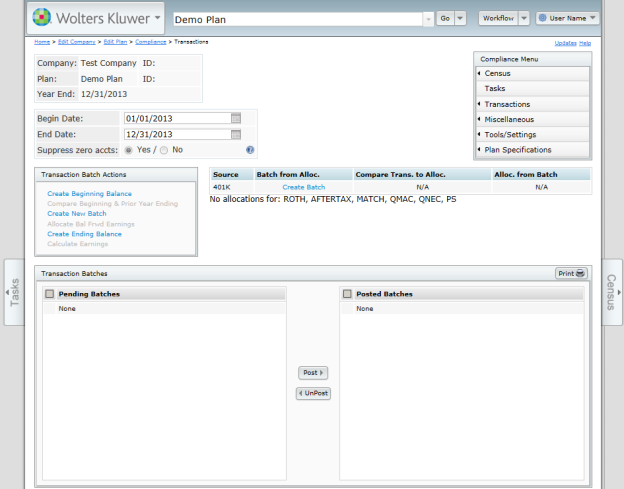
7.1. Adding Transaction Batches
There are several ways to add transaction batches to the Transaction Batches box:
- Adding a manual batch.
- Creating batches from allocations you have previously run.
- Uploading a file from the asset custodian.
- Using the loan module and adding loan distributions or repayments - please see the Loan Module for information.
We will address each of these below.
Creating a Manual Batch
To create your own batch, click on "Create New Batch". You will be taken to the "Create Batch" page where you can select the transaction type from a drop-down box.
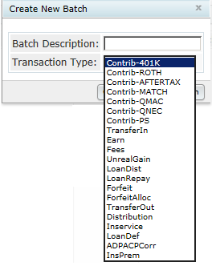
After you have selected the type of batch to add, you may want to provide your own description in the box provided and then click on "Add Batch". The Batch you created will now appear as a "Pending" batch in the "Select Batch" box.
You may add transactions to a batch via an upload or by manually entering them for each applicable participant on the batch data entry grid. To upload transactions, from the “Select Batch” box under “Pending”, click on the “csv” link to the right of the batch. Open the file and add your transactions to the spreadsheet; save it as a .csv file on your hard drive. Then click the “Upload” link to the right of the batch, browse for the file and upload it. To add transactions manually for a particular Participant, double click on the batch in the "Select Batch" box. A data entry grid will open and at the bottom of the page you should see options to "Add Transaction" with a drop-down box to select a participant. After selecting the participant and clicking on "Add transaction", you can enter data into the grid for the participant.
Modifying and Posting Batches. Whenever you upload, create or add batches, they appear as a "Pending" batch in the “Select Batch” box. Whilst pending, batches can be deleted, modified or posted; you do need to move each batch to the “Posted” area for the transactions to be included in the participant statements and financial reports. To post a batch, from “Transaction Batches” box check the small box to the left of the batch and click the “Post” button. This moves the batch to the Posted Batches area - you can always unpost it later if you find that you need to make a correction etc. To post multiple batches, check the box to the left of the “Pending Batches” text at the top. This will select all batches below. Then simply press the action that you wish to take for all of the batches (post/unpost/delete).

Adding a “Create Beginning Balance” Batch. If this is the first testing year the plan is on the system, unless it is the first year a plan is in existence, you will want to create a new batch for the beginning balances. Click on "Create Beginning Balance" and select to either create the beginning balance from sources or manually.

Save the batch and add your transaction amounts by participant and by source as described above.
If it is the second year the plan is on the ftwilliam.com Compliance system and transactions were completed in the prior year, you will have the option to create the beginning balance from the prior year ending balance. This option will create a pending batch bringing forward the prior year ending balances.
Adding a “Create Ending Balance” Batch. Ending balances are normally calculated fields, based on the beginning balance and the financial activity during the period. So you would not normally create an ending balances batch until you have finished all the annual work on the plan and are ready to add a new plan year. Adding the ending balances batch will populate the fixed ending balance fields from which the next year’s beginning balances can be brought forward.
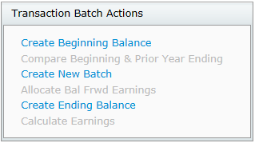
Using the “Compare Trans. to Allocations” Feature. Clicking this link will compare the allocations created in the Compliance system to the transactions (whether posted or unposted). It will show the grand total and "NO ERRORS" if there are no differences between the two files. If there are differences between the two files, it will provide a list of participants with differing balances and the amount in the allocation file and the transaction file for that participant.
Creating Batches from Allocations You Have Previously Run
After you have run allocations for a plan year, you will see options to create batch from the different allocation types. If you click on "Create Batch" under the “Batch from Alloc” column, you will be provided with an allocation date and will be prompted to enter the contribution date. Each is explained below:
- The Allocation Date will be provided as the last day of the current testing year; this indicates the allocation was made for that plan year even if actually contributed in a later year.
- The Contribution Date is the date that the contributions were actually made to the plan (for top heavy testing purposes). If a profit sharing allocation is not actually made until February of the next plan year, enter that date. If you are entering elective deferral contributions that were all made during and throughout the plan year, you may just enter the last day of the plan year.

Once you click on "Add Batch", the batch will be added to the Select Batch Menu under “Pending”.
Uploading Transaction Files from an Asset Custodian
ftwilliam.com offers the option of importing financial data from an asset custodian or vendor. You would download a transaction file from the vendor’s TPA website, and then upload the file on the ftwilliam site. Uploads from the following vendors are available:
|
Vendor |
File Type |
|
American Funds |
.csv</ |
|
Great West |
.pas</ |
|
Guardian |
.csv</ |
|
Hartford-MFS |
.csv</ |
|
ING |
.fi1</ |
|
ING-Omni |
.fi1</ |
|
John Hancock |
.txt</ |
|
Lincoln |
.csv</ |
|
Nationwide |
.txt</ |
|
Principal |
.csv</ |
|
Transamerica |
.csv</ |
|
Generic |
.csv</ |
The generic upload format is available for uploads from vendors that we do not have a custom tool for; you would need to reformat the data into a specific layout to upload it. You can request a sample layout from ftwilliam.com - it’s an Excel spreadsheet.
Uploading Transactions from the Asset Custodian for a Single Plan
The steps for set up and uploading files are as follows:
- From the Compliance Menu page select “Plan Specifications”. In the top Sources & Investment Accounts box select the Financial data import vendor from the drop-down box. Enter the plan’s vendor account number (usually their contract number) into the Financial data import ID code box. You will also need to click on the “Work with Sources/Inv Accounts” link to review the sources allowed by the document.
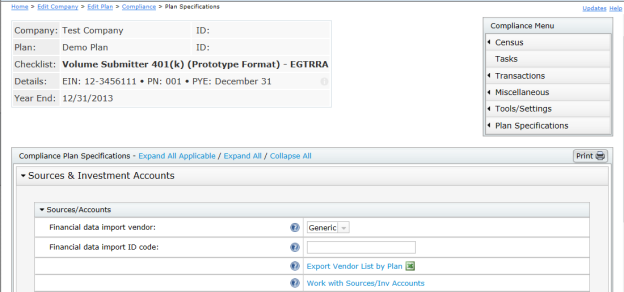
- Go to the vendor’s TPA website, log in and download a transaction file for the period you need. The format of the file you need differs from vendor to vendor so you need to make sure you get the correct file format - see the different types in the table above.
- Save the file on your hard drive or server. You should not open it; just save with the appropriate suffix.
- From the main Compliance Menu on ftwilliam.com, hover over the Transaction option and click on “Vendor Uploads”.

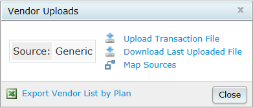
- Click “Map Sources”. You will see a list of all the sources that may be used by this vendor and you need to indicate for each source this plan has, which ftwilliam source they should be mapped to. Once you have completed this, click on “Update” and then return to the previous screen.
- Click “Upload Transaction File”. Browse for the file on your hard drive or server, select it and click “Submit”.
- The uploaded transactions will be displayed as batches in the “Pending” area in the “Select Batch” box. You can edit or delete any of the batches at this point, or post them. We do suggest that you do not post an “Ending Balances” batch if that is included; rather you should let the software calculate the ending balances.
Note that once the upload is complete, if it contained any transactions for plans that are not set up already, with the appropriate year, on ftwilliam you will receive an error message. If you receive such messages you can make the corrections on ftwilliam, i.e. add the appropriate plan(s) and/or year(s), and then do the upload again.
Lincoln Batch
Working with Lincoln Financial, ftwilliam.com has developed a tool to import transactions for multiple plans at one time. Follow the steps below to import from Lincoln:
- Log on to the Lincoln website and enter “Data Direct”.
- Click on “Data Download” on the Navigation Bar on the left. Select “Report Request”.
- Enter your search criteria and click “Search”. The screen will populate with a list of plans meeting your search criteria.
- Check the “Select” box for all the plans you want to download transactions for. Scroll to the bottom of the page and click “Next” to go to the “Report Request” page.
- On the “Report Request” page select “Activity Import File” from the “Report Type” drop-down box. Enter the date range you want and indicate whether you wish to receive an e-mail notification when the report is available. You should also indicate the “Result Type” as a “CSV” file. Click “Submit”.
- When the report is available, go to the “Active Downloads” screen to retrieve it. Save the file to your hard drive or server as a .csv file.
- On ftwilliam.com you should complete steps 1 and 4 described above for each plan in the Lincoln download.
- From the main Compliance Menu on ftwilliam.com, hover over the Transaction option and click on “Vendor Uploads” from any of the plans for which the batch will apply.
- Click “Map Sources”. You will see a list of all the sources that may be used by this vendor and you need to indicate for each source this plan has, which ftwilliam source they should be mapped to. Once you have completed this, click on “Update” and then return to the previous screen.
- Click “Batch Upload Transaction File”. Browse for the file on your hard drive or server, select it and click “Submit”.
- The uploaded transactions will be displayed as batches in the “Pending” area in the “Select Batch” box. You can edit or delete any of the batches at this point, or post them. We do suggest that you do not post an “Ending Balances” batch if that is included; rather you should let the software calculate the ending balances.
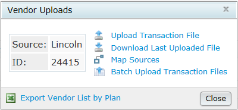
Download File
After uploading a transaction file from a vendor, the user can click “Download Last Uploaded File” to view the file that was uploaded. Please note that this link will show all vendor files with the exception of ING and Mass Mutual files.
7.2. Statements/Reports
After you have all transactional data in the Transactions menu, you will be ready to run statements or other transactional reports. Statements and reports are located either from the Compliance Menu – Transactions – Reports/Statements or by pressing the Print button within the Transaction Batches box on the Transactions screen.
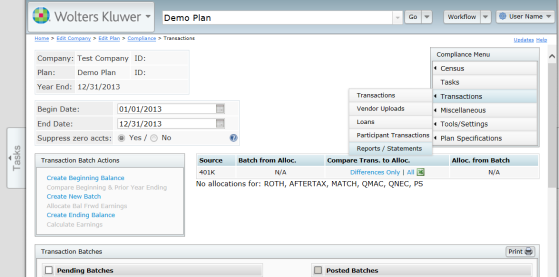
Distribution Report
This report will show all active employees who received a distribution during the plan year and inactive participants with a balance or who received a distribution during the plan year. Before running the distribution report, one of the statement options (such as “Statements – Individual Participant”) must be run first.
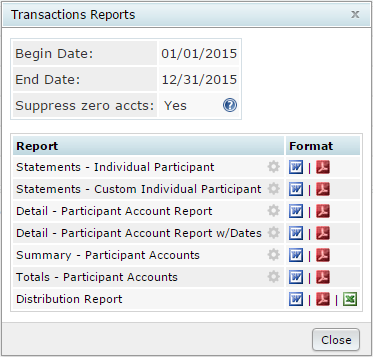
The distribution report contains the following fields:
- SSN
- Last Name
- First Name
- Hire Date – First hire date on the system
- Term Date – Last termination date on the system
- Status – Either Active or Term. Based on the status as of the last day of the plan year.
- Source Type
- 401K
- Roth
- Match
- QNEC
- QMAC
- PS
- SH NE
- SH MA
- Rollover
- Roth Rollover
- Distribution Amount –The distribution amount will be a sum of all distribution types, listed by source, then total of all sources.
- Remaining Balance – This is the end balance as of the end of the plan year by source, then total of all sources.
- Vesting % - The vesting percentage will be displayed for each source type.
- Remaining Vested Balance – This is the total vested balance by source.
- Distribution Type – Pulls from the different distribution batch types as coded in the system. Note: if the participant is not active on the last day of the plan year, the type will be classified as “Distribution”. Otherwise the system will display the last distribution type in the plan year.
- Inservice
- ADPACPCorr
- LoanDef
- Distribution
The distribution report is a great tool to use to determine which terminated participants still have account balances that can be distributed. The report is split by active participants, inactive participants with current year distributions and terminated participants with a remaining balance. This report can be printed either as a .csv or word file.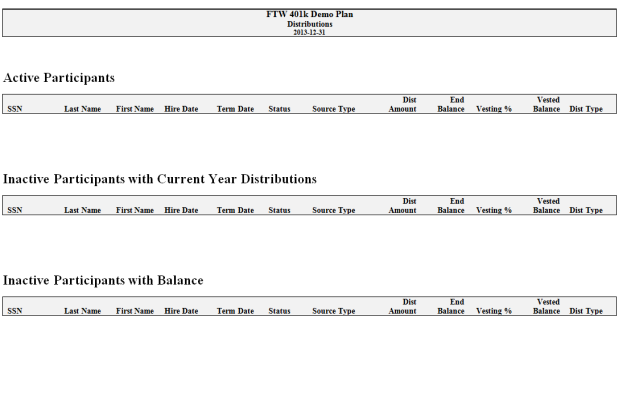
7.3. Creating Allocations from Batches
With the click of a button, the system will copy the contributions uploaded into the transaction system to census for testing and reporting.
After transaction batches have been posted, a link “Create $xx.xx Allocations” will appear under “Alloc. from Batch”. A warning will also appear if there are pre-existing allocations in the census, letting the user know that those allocations will be overwritten by the copied allocations. When you click this link, the allocation amounts will copy into the census. If using investment accounts, all funds will be summed. Similarly, if there are multiple contribution batches of the same source type, these will also be summed. Please note that a participant must already be in the census to have an allocation copy for them and the system will set the applicable allocation parameter override to yes.

7.4. Loan Module
If you use ftwilliam.com for document purposes, the loan module will only be available if the plan allows for loans. For non-document users, the loan module is always available.
Loan Investment and Source Set Up
Prior to working in the loan module, users will need to set-up loan distribution hierarchies for investments and sources. Note that loans are tracked as an investment in the ftwilliam software.
Loan Investment Account Setup
Select “Plan Specifications” from the “Compliance Menu” page. Under “Sources and Investment Accounts” click the “Work with Sources/Inv Accounts” link. Make sure that “Use Investment Accounts to track Participant balances” is “Yes”; if not, select “Yes”. The “Work with Investment Accounts” link will appear; click this link. Add an investment account for loans. Typically the AccountID would be “LOAN” and the Account Name and Account Description would both be “Loan Fund” though you may certainly use something different. Investment Type would be “Cash”. Note that if you do not have any other investment listed on this screen you should add one, typically the AccountID would be “Vendor”, “Brokerage” or “Pooled” and you can add your own account name and description.
Check the “Add all Investments to all sources” box if all sources are permitted to have loans taken from them. This will automatically add all listed investments to all sources. If there are some sources that do not have one or more investment accounts, you will need to manually add the investment accounts to the sources. Click “Update” to save your changes.
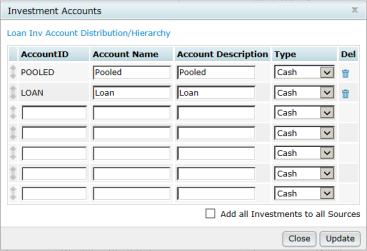
Next, on this same screen, click on “Loan Inv Account Distribution/Hierarchy”. For each investment select “Yes” or “No” from the “Allow Loans” drop-down to indicate whether money in that investment is available for loans. Note that the loan fund should not be available for loans. Make sure that the loan fund is selected in the “Select Loan Account” drop-down.
Use the last column to establish the loan distribution hierarchy - either pro rata or ordering rule. If you select the latter you will need to enter sequence numbers to indicate how the investments should be ordered when a loan distribution is processed. Click “Update” to save your changes.
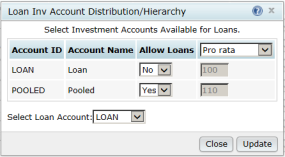
Source Set Up for Loans
Select “Work with Sources”; you’ll go to the “Source Setup” page. Click the “Loan Source Distribution/Hierarchy” at the top; this will open the “Select Sources Available for Loans” screen. Make sure the sources that loans can be taken from have “Yes” selected and others have “No”. Be sure to click “Update” to save your changes. Click the “Hierarchy” button to set up the hierarchy for loan distributions by source, again either pro rata or ordering rule. Click “Update” to save your changes, then return to the Source Setup page.
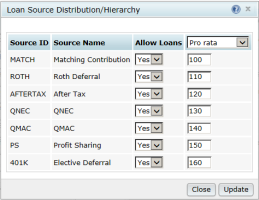
On the “Work with Sources/Inv Accounts” page, you should click to “Edit” or “Add” each source for which loans are allowed; this is located to the far right of each source under “Account Information”. Here you need to ensure that the loan fund is listed as an available investment for each source that permits loans. Also any other investments permitted to be used for that source should also be listed. Click “Update” to save your changes, then return to the main Compliance Menu page.
Adding New Loans and Servicing Loans
Assuming you have up-to-date account balances in the Transactions Menu, you are ready to work in the loan module. To access the loan module, select “Loans” under the “Transactions” option of the “Compliance Menu”.
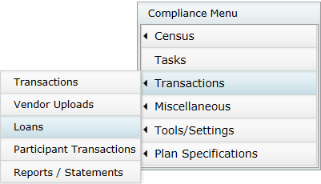
The Loans page is where new loans are created, viewed, modified and where loan report options can be found.
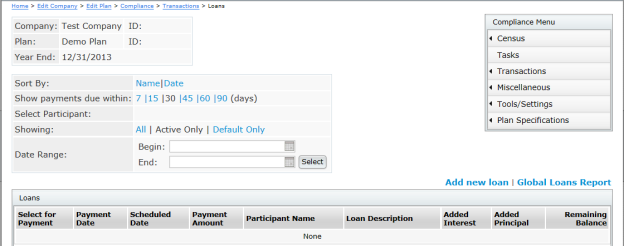
New Loan
Select the link “Add new loan” and you will be taken to the “New Loans” page. Under “Create a New Loan” you should see a list of participants in the plan. Select the participant from the list and click “Add Loan”.
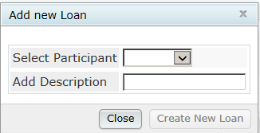
This will create a “Pending Loan” for the selected participant.
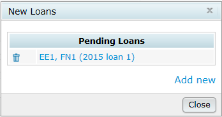
Click the link under “Pending Loans” to be directed to the edit loan page where the following loan specifications can be entered.
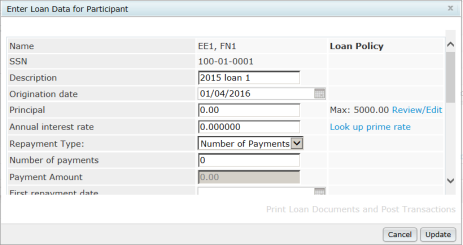
- Description – Enter a description of the loan that will be taken. This description can be any set of values and is determined at user discretion.
- Origination date – This date is the date the loan is taken by the participant. Clicking the box will prompt a pop-up calendar. Use the years and the bottom to scroll through the years. Use the arrows at the top to move back or forth through the months or the drop down box to select a month. Click on a day to select the day of the month/year. Double-click in the field to manually enter a date in mm/dd/yyyy format.
- Principal – The principal amount is the amount to be taken from the plan as a loan to the participant. The system will calculate the maximum loan amount available, shown at the right of this field. The principal amount cannot exceed the maximum amount. Note that in some cases the system may not have all the information it needs to calculate the maximum available loan. Click on “Review/Edit” to review and update the amount.
- Review/Edit – Users can change the amounts available by source and investment, and/or the vesting percentage. Enter applicable amounts for any outstanding loans previously taken in “Highest Balance” and “Current Balance” if the loan is not appearing in the “Outstanding Loans” total above. Click “Update” to save your changes and have the system recalculate the maximum loan amount; then return to the New Loans screen. Note that any changes you make here will not feed to any other part of the system; you are only impacting the amount available for a loan.
- Annual interest rate – Enter the amount of interest to be applied to the loan.
- Look up prime rate – Plan administrators may refer to the prime rate currently in effect to determine a fair interest rate to use for loans. Clicking the “Look up prime rate” link will display the prime rate shown by bankrate.com in a new web page.
- Repayment Type – Select either “Number of Payments” or “Payment Amount”. Additional selections will be made below, based on the selection made here.
- Number of Payments – Enter the total number of payments the participant will make. The system will calculate the payment amount to satisfy principal and interest amounts needed to pay off the loan within the total number of payments entered.
- Payment Amount – Enter the amount the participant wishes to make per payment. The system will calculate total number of payments needed to pay off the loan in the amortization schedule.
- First repayment date – This is the date the participant will make their first payment. This date cannot be prior to the origination date nor can it be greater than 90 days past the origination date. Clicking the box will prompt a pop-up calendar. Use the years and the bottom to scroll through the years. Use the arrows at the top to move back or forth through the months or the drop down box to select a month. Click on a day to select the day of the month/year. Double-click in the field to manually enter a date in mm/dd/yyyy format.
- Number of outstanding loans permitted – This number is pulled from the plan document. If changes are needed to this number, they must be made in the plan document. A warning message will appear if the number of loans created, exceeds this number.
- Allow extended term for principal residence – The plan document may permit an extended repayment time for loans that will be used to purchase a principal residence. Choose either yes or no from the drop down box to change the answer here. Select “yes” if the loan will be used to purchase a principal residence. The default answer is no. The answer under the loan policy column will display yes or no. If “yes” is displayed, the plan document does permit the extended repayment.
- Payment frequency – Using the drop-down box, select the frequency in which payments will be made
- Payable in full on termination – If the loan is payable in full upon termination of employment, set this to yes. Answers should be based on the plan document.
- Prepay loan – This is determined by the plan document. Options include:
- None- No prepayment permitted
- Prepay in full only – Only a full repayment is permitted
- Prepay in full or in part – More than the minimum payment is permitted, up to full repayment.
- Repay by payroll deduction – Determined by the plan document. Usually loan repayments are done through payroll deduction, so the default here is “yes”. Set this to “no” if the plan document dictates otherwise.
- Loan processing fee – If there is a loan processing fee, set this to “yes”, otherwise, set to “no”.
- Loan processing fee amount – If “Loan processing fee” is “yes”, enter the dollar amount of the loan processing fee here.
- Loan maintenance fee - If there is a fee for maintaining a loan, set this to “yes”, otherwise, set to “no”. Please note that this fee is separate from the loan processing fee and is usually applied on an annual basis (or other periodic time frame).
- Loan maintenance fee amount - If “Loan maintenance fee” is “yes”, enter the dollar amount of the loan maintenance fee here.
- Loan default period – Select the time frame in which the loan will go into default if payment is not timely made. Options are “maximum cure period” and “specified number of days”. Please refer to the plan document.
- If “Specified day”, number of days – If “Loan default period” is “specified number of days”, enter the number of days in which the loan will go into default once a payment is not made.
Once all applicable data for the loan has been entered, click “Update”, then click “Print Loan Document and Post Transactions” to continue. Please note that the “Print Loan Documents and Post Transactions” link will not be active until after pressing the “Update” button and receiving a message that the updates were successful.
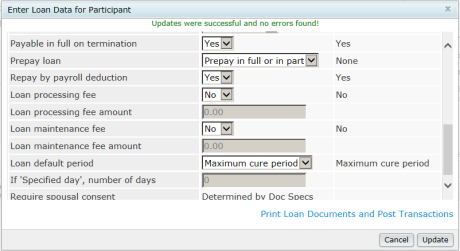
This brings you to a screen that summarizes the loan details, provides links to “Amortization Schedule (csv) (doc)”, “Promissory Note (doc)”, “Note and Amortization (doc)”, and “Post Loan”. In general, you will want to print and save the documents before posting the loan. After posting the loan, these reports will be available in the Loan Reports.
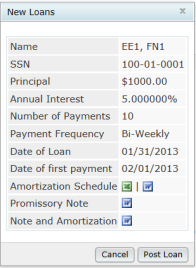
Once posted, the loan will be added as a pending batch transaction in the “Transactions Menu”.

The loan distribution batch has the negative loan amount coming out of the applicable accounts and the positive loan amount going into the loan fund, resulting in a zero net amount.
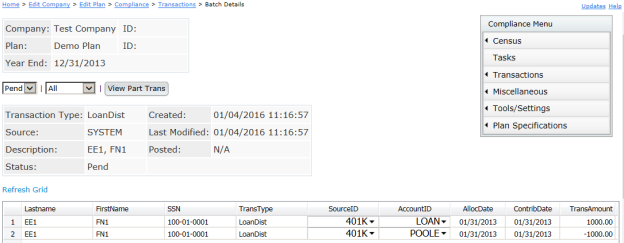
Service Loan
Posting payments can be done directly within the main screen of the loan module. At the top of the screen, there are multiple options to sort and view existing loans (sort by date or participant, active/defaulted only, etc.). To select a payment, click to select along the left-hand side of the page. To select several payments within a date range, enter the begin and end date in mm/dd/yyyy format and press “Update”. This will automatically check all the payments within that time frame. If pre-payment is applicable, enter any pre-payment interest and principal for the payment date and click “Update” to view the total payment selected. Once you are ready, click “Post Loan Payments”. You will be taken to a page to confirm the amount to post, and once confirmed, the loan payment(s) will be added as a pending batch transaction in the “Transactions Menu”.
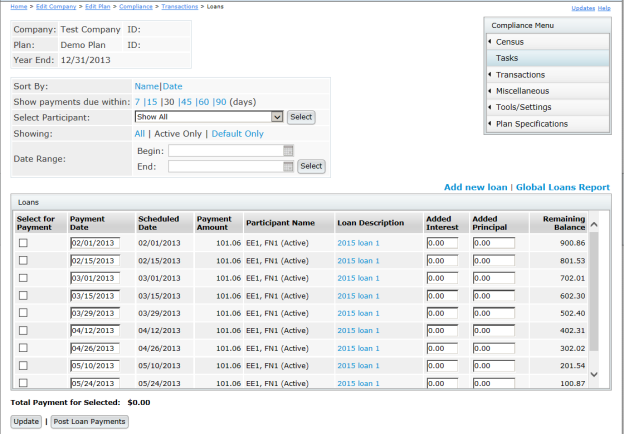
Loan Report - Default Loan
There are multiple reports, functions and documents that can be accessed in the Global Loan Report Menu.
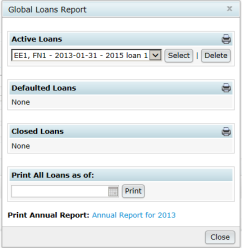
To delete a loan, select the participant under “Active Loans” and click “Delete”. You will be asked to confirm the delete.
To default or offset a loan, access amortization schedules and other loan documents, select the participant under “Active Loans” and click on “Select”. You will see similar documents as were available before the loan was posted, plus the additional options to unpost payments and “Default Loan”. To default a loan, click on “Default Loan”, update the default date and click on “Post Loan Default”. You will be asked to confirm “Post Loan Default” and be taken back to the loan data for that participant. You will have a new option to “Perform Loan Offset” after defaulting the loan and the loan will be listed as defaulted. Offsets can be performed here to close the loan and offsets will appear as pending batches in the Transactions Menu.
Other reports available include loans as of a certain date, “Print Current Active Loans”, “Print Current Defaulted Loans”, “Print Current Closed Loans” and “Annual Report for YYYY”.
7.5. Payroll
The payroll feature gives users the ability to upload payrolls, compare hours and compensations from payroll totals to the census, push payroll hours and compensations to the census, and create contribution batches in transactions from the payrolls.
Payroll Navigation
From the home page, select a plan and navigate to the Compliance module. From the Compliance Menu, hover over Transactions and select Payroll.
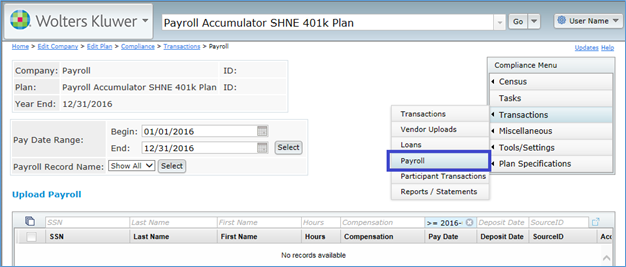
Uploading Payrolls
Click the "Upload Payroll" link to begin the file upload process.
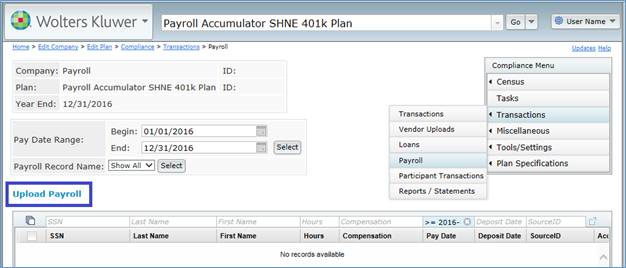
A sample file showing the format of the upload can be downloaded, along with an explanation of codes, which shows the sourceIDs that must be used and a description of each. Note that the source ID’s outlined here match those in our system in the Work with Sources /Inv Accounts screen.
Once the file is in the proper format, users will browse their computer for the payroll file. The payroll name automatically populates with the file name. It is required that each payroll name be unique. Press Upload to upload the selected file.
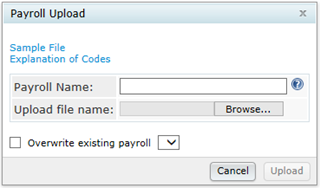
Payroll Correction/Overwrite
If users determine that the payroll that they uploaded had errors, they can upload a corrected file and overwrite the incorrect payroll, by checking the box to overwrite existing payroll, and selecting the applicable payroll name. The overwritten payroll retains the original payroll name. The original payrolls will be deleted and the new payrolls in the corrected file will replace them.
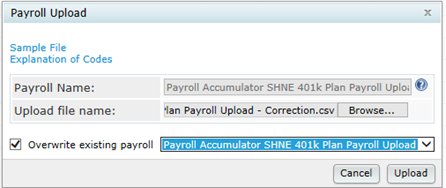
Filtering Payrolls
Payrolls can be filtered by using the filter boxes at the top of each column. The columns have advanced filtering capabilities, which are described in the help that appears when you click on one of the filters.
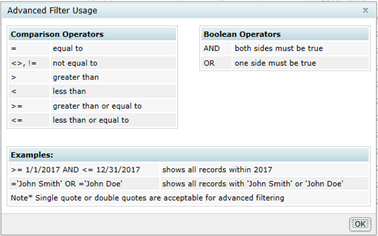
Users can also filter by selecting a pay date range or payroll record name. The pay date range defaults to the plan year, but can be edited by the user to display any date range.

Sorting the Payroll Grid
Payrolls are sorted by default by last name, first name, then pay date. To change the sort order, click the header name of the column you wish to sort by. An arrow will appear next to the header name, indicating if it is sorting in increasing or decreasing order. A down arrow will indicate a sort for that column in a decreasing order. An up arrow indicates that the column is sorted in ascending order.
Compare to Census / Push to Census
Hours and Compensations from uploaded payrolls can be totaled, compared to and pushed to the census. Select the payrolls that you want to include in the push. Once you have checked all of the payrolls you wish to select, press the “Do with selected” button at the bottom left of the page and press the “Compare Census Data” option.
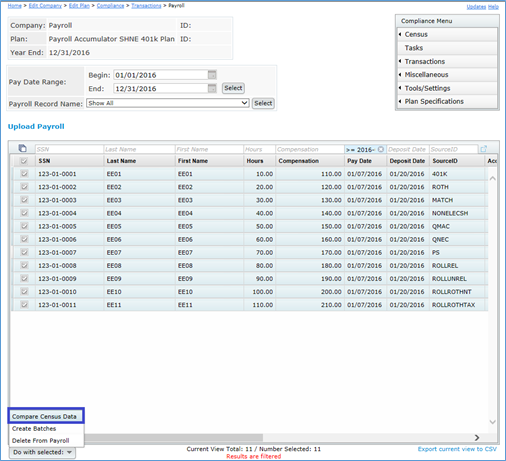
The “Compare – Differences Only” window will popup, showing the list of participants with differences in either hours or compensation. To view the full list of participants compared, press the “Download CSV of complete comparison” link. Select the participant hours and/or compensation that you wish to push to the census, then press the “Push to Census” button.
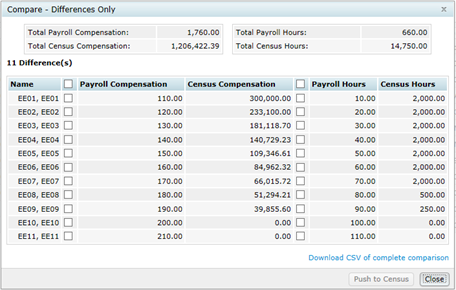
If you elect to push compensation to the census for any participant, you will have the option to either push the payroll compensation to all compensation fields or only to statutory compensation. Pressing the “Close” button will cancel the push to the census.

Contribution Batches
Contributions from uploaded payrolls can be pushed to transactions in the form of contribution batches for each payroll date, by each contribution source. To push contributions from Payroll to Transactions, check the box on the left side of the Payroll grid for each payroll you wish to add to Transactions. Once you have checked all of the payrolls you wish to select, press the “Do with selected” button at the bottom left of the page and press the “Create Batches” option.
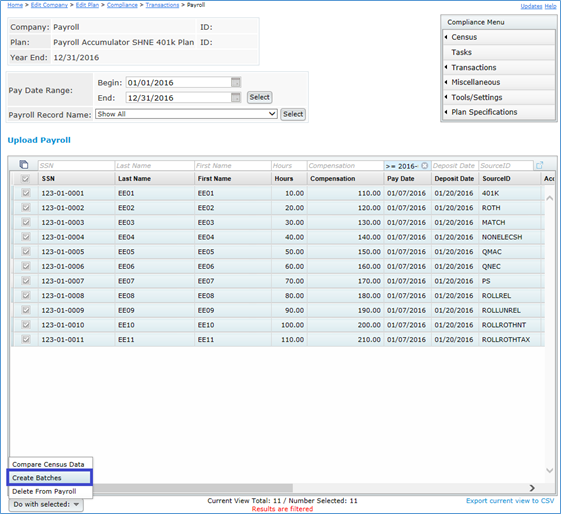
A confirmation screen will appear, requesting that you confirm that you wish to create batches. You can cancel or confirm batch creation. If you confirm batch creation, batches for each payroll will be created and a confirmation box will display the results. Here you have the option to either navigate to Transactions or remain in Payroll.
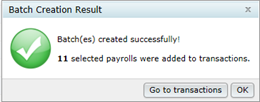
In Transactions, payrolls with the same source type and pay date will be included in a single batch.
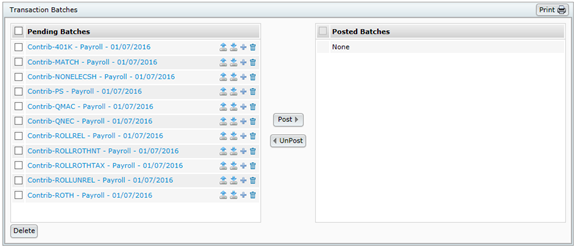
Once batches are posted, links to create allocations from batches will become available above the posted batches. Click each applicable allocation link to push the total amount per source from Transactions to Census.
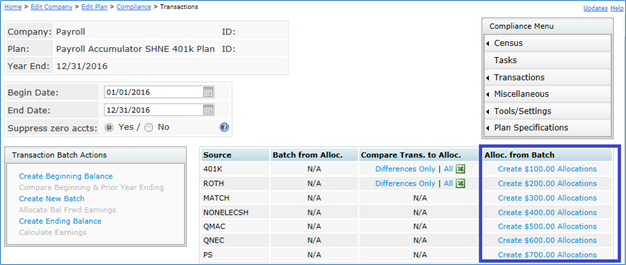
Part 8: Miscellaneous Tasks
8.1. 5500 Data Report
Clicking the 5500 Data Report option will provide information for the participant count fields for the plan’s Form 5500/5500-SF/5500-EZ. The 5500 Participant Summary grid provides the actual numbers.
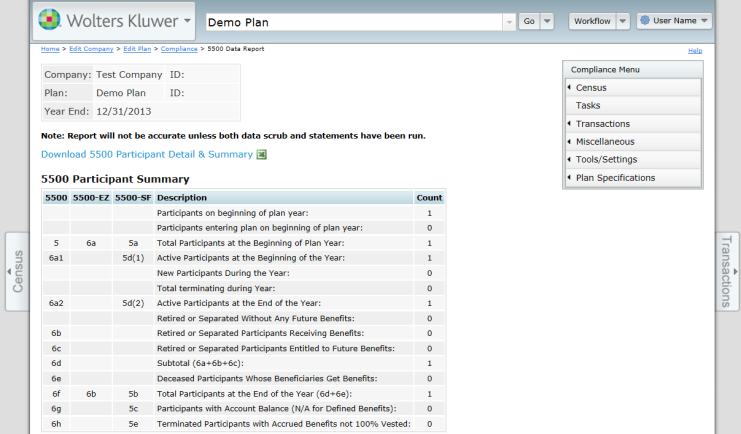
When you click the “Download 5500 Participant Detail & Summary” link you will see a list of all the participants in the plan with indicators as to whether they are eligible, active, have a balance etc. Below is a description of how the 5500 counts are determined in the 5500 data report.
- Part at BOY: Anyone with a vested balance on the last day of the prior plan year except where the only balance is unrelated rollovers and the employee in not eligible to participate plus any active participants as of the last day of the prior plan year (Date of Entry prior to the first day of the plan year being reported) with eligibility = Yes.
- Part Enter at BOY: Anyone who enters the plan the first day of the plan year being reported.
- Total Part BOY: Anyone in Part at BOY or Part Enter at BOY who has a 1 = 1. (5500 Line 5, 5500-EZ Line 6a(1), 5500-SF Line 5a)
- Active Part BOY: Any active participant (eligibility = Yes) at the beginning of the year plus any active excludable participant at BOY with a vested balance except where the only balance is unrelated rollovers. (5500 Line 6a(1), 5500-EZ 6a(2), 5500-SF Line 5d(1))
- Enter During: Anyone who has an entry date after the first day of the plan year being reported with eligibility = Yes.
- Term During: Any participant in Active Part BOY or Enter During whose status is terminated/retired/disabled/death with a termination date during the plan year being reported.
- Active EOY: If the participant has 1 in Active Part BOY or Enter During equals 1 then 1. Else, if the participant has a 1 in Term During equals null. (5500 Line 6a(2), 5500-EZ Line 6b(2), 5500-SF Line 5d(2))
- Ret or Sep w/o benefits: Participant status equals terminated/retired/disabled with a termination date during the plan year being reported and a zero vested balance.
- Ret or Sep rec benefits: Participant status equals terminated/retired/disabled with a termination date during the plan year being reported and participant is receiving installments or took a partial distribution and has a remaining vested balance. (5500 line 6b)
- Ret or Sep entitled to future benefits: Participant status equals terminated/retired/disabled with a termination date during the plan year being reported with a vested balance and did not take an installment or partial distribution during the plan year. (5500 line 6c)
- Subtotal: If Active EOY, Ret or Sep rec benefits, Ret or Sep rec benefits or Ret or Sep entitled to future benefits equals 1 then 1. (5500 line 6d)
- Deceased part-bene rec benefits: Any deceased participant code Death in the census with a vested balance. (5500 Line 6e)
- Tot EOY: If Subtotal or Deceased part-bene rec benefits equal 1 then 1.(5500 Line 6f, 5500-EZ Line 6b(1), 5500-SF Line 5b)
- Part w/acct bal: Anyone with a vested balance at the end of the year except where the only balance is unrelated rollovers. (5500 Line 6g, 5500-SF Line 5c)
- Term w/accrued ben not 100% vested: Anyone terminated/retired/disabled with a termination date during the plan year who had a vested balance, except where the only balance was unrelated rollovers, which was not 100% vested. (5500 Line 6h, 5500-EZ 6c, 5500-SF Line 5e)
If you are comfortable with the data you can use it to populate the appropriate fields on the 5500. When you open Form 5500/5500-SF or EZ on ftwilliam.com you will see a button “Populate Line 5 & 6 from Compliance” (or just Line 5 for 5500SF or Line 6 for 5500-EZ). Clicking this button will populate the fields.
8.2. 1099-R Export Menu
The 1099-R Export enables users to calculate data pertinent to the Form 1099-R and export that data directly from the Compliance module to the 1099 System.
The system uses the following data to determine who and what data should be transferred to the 1099-R (as applicable):
- Participant distributions (in Transaction Menu)
- Participant’s date of birth
- Participant’s address
From the Compliance Menu, select Miscellaneous, and click 1099-R Export to begin.
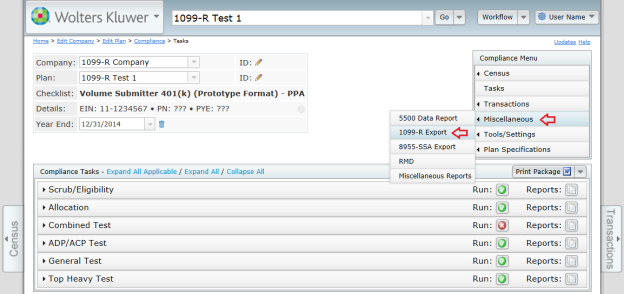
The 1099-R Export Menu has three menu options; calculate, view/edit and transfer the 1099-R records. You must run the calculation option before the “View/Edit” and “Transfer Records” options become available.
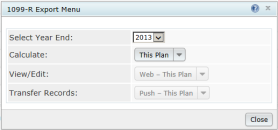
Calculate 1099-R Transfer Records
Select Calendar Year End
The Calendar Year End that the user selects determines the Form 1099-R that the data will be exported to. The participant distribution information is also taken from this year.
Calculate for This Plan/All Plans
A user with administrator rights will have the option to run the calculation for either “This Plan” or “All Plans”. Users that do not have administrator rights will only see the option to calculate for “This Plan”. Pressing “This Plan” or “All Plans” next to the Calculate option will first calculate transfer records based on distribution transactions posted in the system. Then the system will print the results and create transfer records with applicable data to populate the fields in the 1099-R. These results will appear in a popup window for your review.
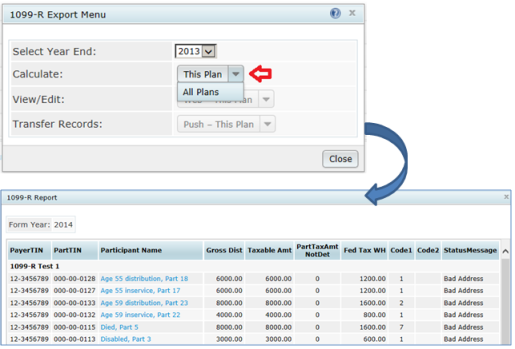
Please Note: Any existing 1099-R transfer records for the plan or globally (as selected by user) will be overwritten when new transfer records are created. This means that if you made edits to the data from within the 1099-R export menu, those changes will be lost each time you press the Calculate button.
The distribution codes and withholding percentages are determined by the system as follows:
|
Distribution Code |
Transaction Type |
Age Condition |
|
1 |
Distribution or In-service |
59 ½ or younger* |
|
2 |
Distribution |
Less than 59 ½ and greater than age 55. |
|
7 |
Distribution or In-service |
Greater than 59 ½. |
|
8 |
ADP/ACP Correction |
|
|
L |
Loan Default |
|
|
B |
Any distribution type of Roth or Roth Rollover sources |
|
*If the distribution is taken in the year the participant attains age 59 ½, user must review the code selection and edit as applicable.
|
Withholding % |
Distribution Type |
|
20% |
Distribution; In-service |
|
10% |
ADP/ACP Corrections |
|
0% |
Loan Default |
* Withholding amount is based on distribution amount and withholding percentage. Withholding percentage is based on distribution type as shown above.
View/Edit 1099-R Transfer Records
The View/Edit option prints all 1099-R Transfer records, either for the current plan or for all plans and either within a web page or a csv file as selected by user.
If a CSV option is selected the system will print the results to a csv (excel) file for the user to review.
If one of the Web option is selected the system will direct the user to the results page online. The page will contain all a list of all participants with 1099-R records for the calendar year selected. There is a link for each participant’s record. Clicking on a link permits the user to edit data in the 1099-R Transfer records for that participant. Please note that any data that you change here is temporary and will not be reflected in the Compliance master records for that participant. As such, once you close the 1099-R Export Menu, the data that you changed is erased. It is suggested that you enter information such as address data in the compliance software by using a supplemental grid if you want this data to “stick”.
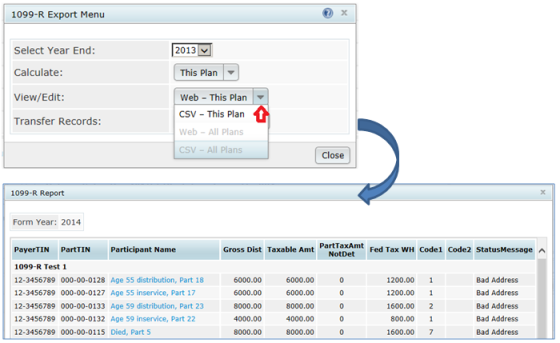
Transfer Records to 1099-R Module
Next to the transfer records task, the user has the option to either “Push” the records directly to the 1099-R or print the records to a “CSV” file. This can be done for “This Plan” or “All Plans”, again depending on individual user rights.
Selecting “Push” transfers all calculated 1099-R data to the 1099 module, either for “This Plan” or for “All Plans” as selected by user. If there is existing data already in the form all data will be replaced. If there is no prior 1099-R, the system creates one.
Selecting “CSV” prints the results to a csv (excel) file. This file can then be uploaded into the system.
**Warning: If you have completed any 1099-R’s you may not want to Transfer 1099-R Data for all plans as this will overwrite all 1099-R’s previously completed!
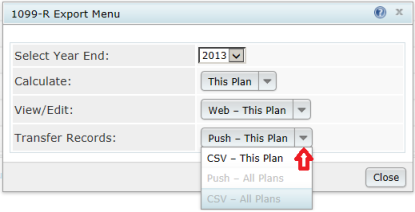
8.3. 8955-SSA Export Menu
The 8955-SSA Export Menu enables users to calculate data pertinent to the Form 8955-SSA and export that data directly from the Compliance Menu to the 5500 System.
The system uses the following data to determine who should be on the SSA (as applicable):
- Participant’s termination date
- Participant’s vested account balance (statements must be run for the account balance to be recognized)
- Participant forfeitures/distributions (from the Transaction/Statement Menu)
Click the “8955-SSA Export” option from the Compliance Menu under Miscellaneous Tasks. Here you will have the option to create SSA transfer records, view/edit SSA transfer records and transfer the SSA data.
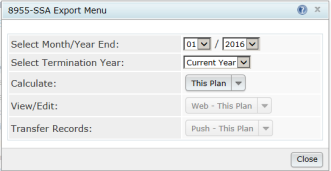
Select Plan Month/Year End
The Plan Month/Year End that the user selects determines the Form 8955-SSA that the data will be exported to. The participant account balance information is also taken from the same year from the Compliance software. Please note that if the plan year end is a fiscal year end, the current year will only be available if the month selected is less than or equal to the current month in the year. For example, if today were 9/24/2013, users will only be able to select months 1-9 in 2013. If months greater than 9 (10-12) were selected, the 2013 year will not appear as an option.
Select Termination Year
If “Current Year” is selected, the Entry Codes for Page 2, Part III, column (a) will be determined as follows:
- Code A: Participants with a vested balance that terminated in the current year in which the Form 8955-SSA is being filed.
- Code D: Participants that terminated in any prior year and distributed/forfeited entire balance in current year.
- None: Participants whose entire balance has been forfeited/distributed in the current year and who were rehired during the current year. These participants will not be exported to the Form 8955-SSA.
If “Prior Year” is selected, the Entry Code for Page 2, Part III, column (a) will be determined as follows:
- Code A: Participants with a vested balance that terminated in the year prior to the year in which the Form 8955-SSA is being filed.
- Code D: Participants that terminated two years or more prior to the year in which the Form 8955-SSA is being filed and distributed/forfeited entire balance in the current year.
- None: Participants whose entire balance has been forfeited/distributed in the current or prior year and who were rehired in the current year. These participants will not be exported to the Form 8955-SSA.
*If prior year was a conversion year all results must be reviewed with care.
*A “year” is defined as the 12 month period that precedes the month/year the user selected above.
Calculate for This Plan/Calculate for All Plans
With the click of a button, this menu option will first calculate transfer records based on service history and transactions posted in the system. Then the system will print the results and create transfer records with the following information either for a single plan or for all plans as selected by user:
- Entry Code
- Annuity Type – System will default the annuity type to code A. Will only transfer if the entry code is set to A or B.
- Payment Frequency– System will default the annuity frequency to code A. Will only transfer if the entry code is set to A or B.
- Participant Name
- Social Security Number
- Termination Date
- Termination Reason
- Ending balance
- Vested balance - Will only transfer if the entry code is set to A or B.
- Status - Status messages will be shown here (e.g. no statements, rehire date, or OK)
Please Note: Any existing SSA transfer records for the plan or for all plans (as selected by user) will be overwritten when new transfer records are created.
View/Edit
If the csv file option is selected, the system prints all SSA Transfer records to a csv (excel) file, either for a single plan or for all plans as selected by user.
If the web page option is selected, the system prints all SSA Transfer records, either for a single plan or for all plans as selected by user to a web page for the user to review. This option also permits the user to edit all data in the SSA Transfer records for that participant by clicking the link available in each record. When editing data, please be sure to click the update button in the edit screen to save your changes then press the refresh button in the 8955-SSA list to view changes.
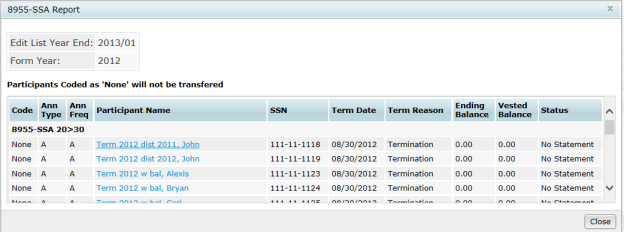
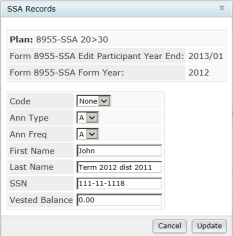
Transfer Records
If the csv file option is selected, the system will print the results to a csv (excel) file. This file can then be uploaded into the system. Please refer to the 8955-SSA instructions for additional information for uploading this data.
Choosing Push transfers all calculated SSA data to the 5500 system with the push of a button, either by plan or for All Plans as selected by user. If there is existing data already in the form all plan level data will remain intact and all participant data will be replaced. If there is no prior Form 8955-SSA, the system will create one.
Warning: If you have completed 8955-SSA’s already you may not want to Transfer SSA Data for All Plans as this will overwrite all SSA’s previously completed!
8.4. Required Minimum Distributions
The Required Minimum Distribution Screen is accessed from the “Compliance Menu” by hovering over “Miscellaneous” and clicking on “RMD”.
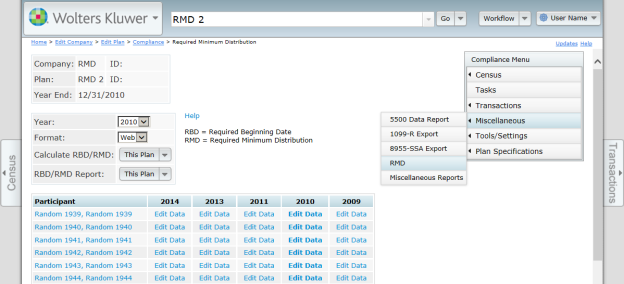
Overview
The Required Minimum Distribution (RMD) rules were created to ensure that the payment of benefits is not postponed indefinitely. These distributions are generally required within a certain time frame once a participant reaches the applicable RMD age. The distribution amount a participant must take is called the Required Minimum Distribution (RMD). The date the participant must take their first RMD is called the Required Beginning Date (RBD).
For the system to calculate the RBD and RMD correctly, the following data must be in the system (as applicable):
- Participant’s account balance for the valuation calendar year
- Participant’s date of birth
- Participant’s ownership data as of the calendar year they attain RMD age
- Termination date and reason for termination
- Beneficiary’s date of birth
Transactions/Statement Menu
The value of the participant’s account balance is determined in the valuation calendar year. To obtain a participant’s account balance for the valuation calendar year, account balance activity must be posted in the Transaction Menu for that year. Additionally, statements need to be run in order for the system to be able to pick up the balances. Please note: if the valuation calendar year is a conversion year with the only activity on the system being an ending balance batch, the system will not recognize those balances for RMD purposes. In this instance the account balance will need to be overridden and manually entered. Please refer to the RMD override section for additional instructions.
Do Data Scrub/Elig Calc
The following census data must be uploaded or keyed into the system in the distribution calendar year: participant date of birth, beneficiary’s date of birth, participant’s ownership, termination date and reason for termination (as applicable). The data scrub must be run before the RMD Menu will become available.
Calculate RBD/RMD
Select the year (either the current year or the next year) for which the RBD/RMD should be calculated for. Then select the format of which you would like to view the RBD/RMD report. If “Web” is selected, the report will open in a web page. If “CSV” is selected, the report will print in .csv format for you to view in an appropriate viewer, such as MS Excel.
If the user has administrative rights, the RBD/RMD can be calculated on either a plan level or global level. The default is to calculate for the current plan only (simply click “This Plan” next to the calculate option). To calculate on a global level, click the arrow next to the button that reads “This Plan” and click “All Plans”.
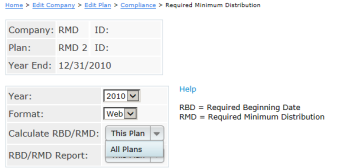
If the user is not a designated administrator, the RBD/RMD may only be run for the current plan. The option to run for “All Plans” is not available.
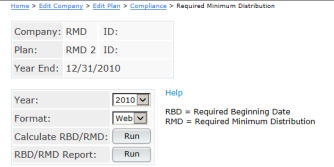
When the calculation is run, the system calculates the following (as applicable):
- RBD
- 5% Owner for RMD purposes
- Death Date
- Date that the participant attains RMD age
- 1st Distribution Cal Year
- Non 5% Term Date
- RMD factor
- Total account balance
- Vested account balance
- RMD
When the calculation is run a pop-up box will open. This lists every participant with an error. For example, if a participant’s beneficiary’s birth date is missing, an error message will appear on this screen to alert the user of invalid data.
NOTE: To review the actual calculations, you must close this box and print the RBD/RMD report.
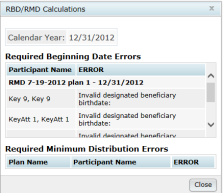
Print RBD/RMD Report
After running the RBD/RMD calculation, you must print the RBD/RMD Report. The top section of the report displays the Required Beginning Date information, showing all participants who have attained the applicable RMD age. The Required Minimum Distribution section of the report lists all participants who the system evaluates should receive a RMD. Users also have the option to open this report in excel format by clicking “csv” next to the report.
RBD/RMD Report in web format
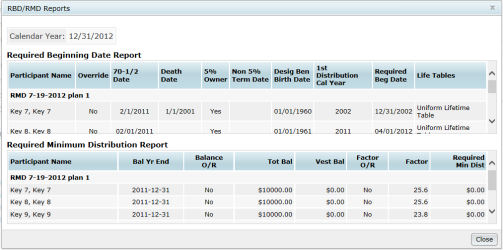
RBD/RMD Report in .csv format

RBD Definitions
RBD calculation for a 5% Owner for RMD purposes
The RBD for a participant who is a 5 percent owner for RMD purposes is April 1st of the calendar year following the year that the participant attains RMD age.
RBD calculation for a non-5% Owner for RMD purposes
The RBD for a participant who is a non-5% owner for RMD purposes is April 1st of the calendar year following the year that the participant attains RMD age or, if later following the year in which he or she terminates employment.
RBD calculation for a deceased participant
The RBD for a participant who dies before attaining age the applicable RMD age will be calculated as December 31st in the calendar year following the year in which the participant died.
The RBD will already have been calculated by the system for 5 Percent Owners who die on or after attaining the applicable RMD age and for non-5 Percent Owners who die on or after attaining RMD age and have terminated employment.
RBD Overrides
A link, displaying participants names, appears when the RBD/RMD calculation is run. Clicking on this link opens a screen where the RBD and the data on the screen below can be edited for a given participant.
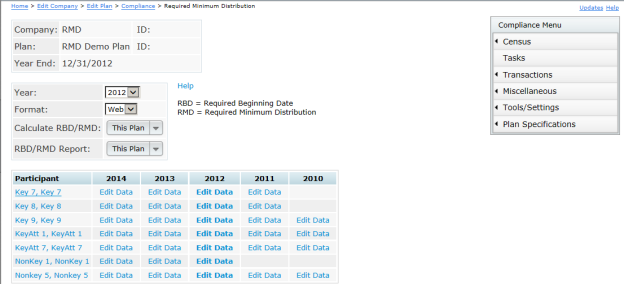
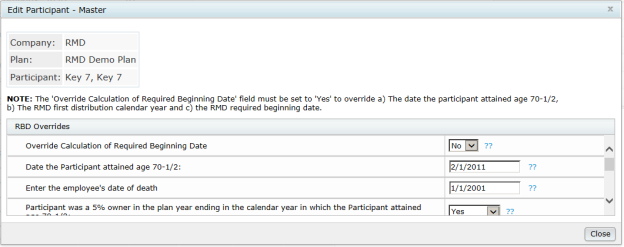
Override Calculation of Required Beginning Date
The “Override Calculation of Required Beginning Date” should be set to “Yes” if the user wishes to bypass the recalculation of:
- Date the Participant attained RMD age
- Date of death
- RMD first distribution calendar year, or
- RMD required beginning date for the year
Date the Participant attained the applicable RMD age
The “Date the Participant attained RMD age” field equals the date the participant reached the applicable RMD age in MM/DD/YYYY format. It is based on the participant’s date of birth in the system and is calculated when the RBD calculation is run. To override the system calculation of this value in the year the participant attains the applicable RMD age, enter a valid date (MM/DD/YYYY) and set “Override Calculation of RMD” to “Yes”. To override the system calculation of this value in any other year, simply enter a valid date (MM/DD/YYYY).
Enter the employee’s date of death
The date of death field will populate (in MM/DD/YYYY format) if a valid termination date is in the system with the reason of termination due to death. The date of death is calculated when the RBD calculation is run if it is not already populated with a value. To delete this date entirely the user must set “Override Calculation of RBD” to yes.
Participant was a 5% owner in the plan year ending in the calendar year in which the Participant attained RMD age
The system will calculate whether or not a participant was a 5% owner for RMD purposes if the value of 5% Owner for RMD purposes equals “unknown” and the participant has attained RMD age. If census data is not in the system for the year the participant has attained RMD age, the 5% Owner for RMD purposes field will be set to no.
If not a 5% owner for purposes of RMDs, Termination date of Participant after the Participant attained RMD age
If a participant is marked as a non-5% owner for RMD purposes and has a valid termination date, this field will populate with that termination date when the RBD calculation is run.
Birth Date of Designated Beneficiary
The designated beneficiary’s date of birth is used to calculate the factor when the Single Life Table is selected and also used with the participant’s date of birth to determine the factor when Joint and Survivor Life Table is selected. To override this field simply enter a new date of birth in MM/DD/YYYY format in the RBD overrides menu.
Another option is to Other Import/Export/Reports from the Compliance Menu, select the *ftw Beneficiary fields grid, press update, then enter the dates directly in the grid or download/upload the spreadsheet with this data. This method is best used when there are multiple participants that you need to enter data for.
Life expectancy table to use
Life expectancy tables determine what factor will be used to calculate the RMD. The Single Life Table, Uniform Lifetime Table, or Joint and Last Survivor Table will be populated by the system when the RBD calculation is run. This selection is based on individual circumstances of the participant. To override this field use the drop-down box to select a different lifetime table to use.
Enter the RMD first distribution calendar year
RMD first distribution calendar year field equals the calendar year in which the participant reached RMD age. The value is calculated when the RBD calculation is run. To change the system calculation of this value the user may enter a valid four digit year (YYYY). Link to FAQ
Enter the RMD required beginning date
This field equals the date the participant must take their first RMD. The value is calculated when the RBD calculation is run. To change the system calculation of this value, simply enter a valid date (MM/DD/YYYY). Link to FAQ
RMD Overrides
To edit a participant’s balance data or the RMD factor, click on “Edit YYYY Data”. The YYYY is the distribution calendar year for the RMD.
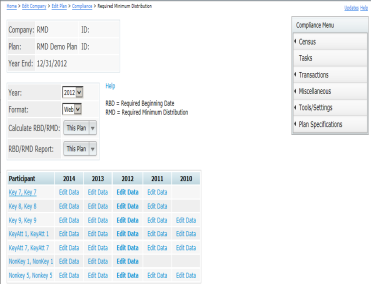
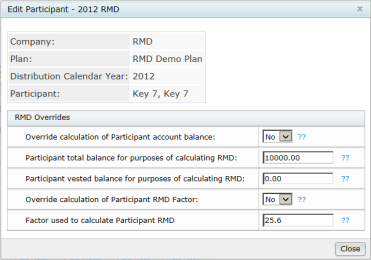
Override calculation of Participant account balance
If “Override Calculation of Participant account balance” is set to “Yes”, the system will calculate the RMD based on the balance data manually entered in this screen. If set to “No”, when the RMD calculation is run, the account balance data will repopulate based on the data in the system.
Participant total balance for purposes of calculating RMD
This field equals the participant’s ending balance in the valuation calendar year. To override, set “Override Calculation of Participant account balance” to “Yes” and enter the new total account balance.
Participant vested balance for purposes of calculating RMD
This field equals the participant’s ending vested balance in the valuation calendar year. To override, set “Override Calculation of Participant account balance” to “Yes” and enter the new vested account balance.
Override calculation of Participant RMD Factor
If “Override Calculation of Participant RMD Factor” is set to “Yes”, the system will calculate the RMD based on the factor manually entered in this screen. If set to “No”, when the RMD calculation is run, the factor will repopulate based on the data in the system.
Factor used to calculate Participant RMD
This field equals the factor that will be used to calculate the RMD. To override the system calculated factor, set “Override calculation of Participant RMD Factor” to “Yes” and enter the new factor you wish to use.
RMD Definitions
Valuation Calendar Year:
The valuation calendar year is the calendar year prior to the distribution calendar year.
Distribution Calendar Year:
The distribution calendar year is the calendar year in which an RMD is due.
5% Owner for RMD purposes:
A participant will be considered a 5% owner for RMD purposes if they have an ownership percentage greater than 5% in the calendar year that they turned RMD age.
Note: If the RBD calculation is run for a future year the 5% owner calculation will be determined based on current plan year data. Once this field is calculated, the user must override if ownership changes prior to the year a participant attains RMD age.
Non- 5% Owner for RMD purposes:
A participant will be considered a Non-5% owner for RMD purposes if their ownership percentage is not greater than 5% in the calendar year that they turned RMD age.
Note: If the RBD calculation is run for a future year the 5% owner calculation will be determined based on current plan year data. Once this field is calculated, the user must override if ownership changes prior to the year a participant attains RMD age.
Single Life Expectancy Table:
If the participant is deceased, the system will default to the Single Life Table. The system uses the designated beneficiary’s date of birth to calculate the life expectancy factor. Note: If a participant dies after this has already been populated with Uniform Life Table, the user must override to change the Life Expectancy Table to Single Life Table. Link
Uniform Life Expectancy Table:
If the participant is alive the system will default to the Uniform Lifetime Table. The system uses the participant’s date of birth to calculate the life expectancy factor. Link
Joint and Last Survivor Life Expectancy Table:
If a participant’s spouse is the sole beneficiary and the spouse is ten years younger than the participant, the Joint and Last Survivor Table must be used to determine the factor that will be used in the RMD calculation. The user must manually change the Life Expectancy Table option to Joint and Last Survivor Table in this instance. The system uses both the participant’s and the designated beneficiary’s date of birth to calculate the life expectancy factor. Link
Death Date:
To determine if a participant is deceased the system will look to see if a valid “death date” is entered. If no death date is found, the system will check the service history for a termination date due to death. If a valid death date is found or there is a termination date due to death in the service history, the system will assume the participant is dead.
RBD/RMD FAQ’s
How does the system determine if a participant is a 5% Owner for RMD purposes?
To determine if a participant is a 5% owner, the system first finds a year end that is less than or equal to the calendar year end in which the participant turned RMD age. The system then looks to see if the participant was a 5% owner in that plan year. The system performs this calculation if the 5% Owner for RMD purposes variable is equal to “Unknown” and if the participant turns RMD age in the calendar year. Please note that if no census data is found for that person for the year end, 5% Owner for RMD purposes will be set to “No”.
When will the system calculate the RBD for a participant?
The system calculates the RBD if the participant has a valid date of birth, the RMD first distribution calendar year field is blank, the Required Beginning Date field is blank, and if the participant is a 5% owner and turns RMD age in the calendar year or if a non-5% owner attains RMD age and terminates employment or if the participant dies.
I’ve overridden the RBD, how do I make the system recalculate it?
First make sure that the “Override Calculation of Required Beginning Date” is set to “No”. Then delete the RBD and 1st Distribution Calendar Year fields in “Edit Participant Master File Data” screen. Finally, re-run the RBD calculation.
How does the system determine if a participant is RMD age?
The system looks to calculate the date the participant attained RMD age if there is not a valid date in the system already. If there is no valid date in the system, the system will look at the participant’s date of birth to determine if the participant has reached RMD age. If they have, the date the participant attained RMD age is recorded.
What are the rules of IRC §401(a)(9)-5?
How is the RMD calculated if the participant is alive?
The RMD is equal to the account balance as of the last valuation date in the valuation year divided by the RMD factor. The factor is determined by the age of the participant as of the distribution year. The default life expectancy table used to obtain the RMD factor will be the uniform table.
Note: If the spouse is the sole beneficiary and is greater than ten years younger than the participant, the regulations state that the Joint and Last Survivor Table must be used to obtain the RMD factor. In this situation, the user must override and change the table to the Joint and Last Survivor Table.
Note: The RMD will calculate even if the Required Begin Date setting in the document is “Election of later of RMD age or retirement”.
How is the RMD is calculated if the participant is deceased?
The RMD is equal to the account balance as of the last valuation date in the valuation year divided the RMD factor.
In general, if death occurs before the RBD, the benefit should be distributed over the life expectancy of the designated beneficiary as outlined in IRC §401(a)(9). In the system, the user must set the override calculation of Participant RMD Factor to “Yes” and enter the user determined factor in the “Factor used to calculate Participant RMD” field. When the RMD calculation is run, the RMD will be calculated based on the manually entered factor.
Note: If death occurs before the RBD and there is no designated beneficiary, the 5-year method should be used. The 5 year method requires that the entire vested balance must be distributed in full by the end of the calendar year that contains the 5th anniversary of the participant’s death. In this case, the factor must be manually entered. For example, if the balance must be distributed in three years (two payments have already been made), the user should enter “3” for the factor so the RMD is correctly calculated.
If death occurs on or after the RBD, the user must determine the correct factor that should be used, using the Single Life Table as outlined in IRC §401(a)(9)-5. In the system, the user must set the override calculation of Participant RMD Factor to “Yes” and enter the user determined factor in the “Factor used to calculate Participant RMD” field. When the RMD calculation is run, the RMD will be calculated based on the manually entered factor.
Why does the RMD report factor show "Manual Override" and what do I do to fix it?
When a participant has a death date, the user must set override calculation of Participant RMD Factor to “Yes” and enter the user determined factor in the “Factor used to calculate Participant RMD” field. When the RMD calculation is run, the RMD will be calculated based on the manually entered factor. Please review the regulations for additional information about how the RMD factor should be calculated for a deceased participant.
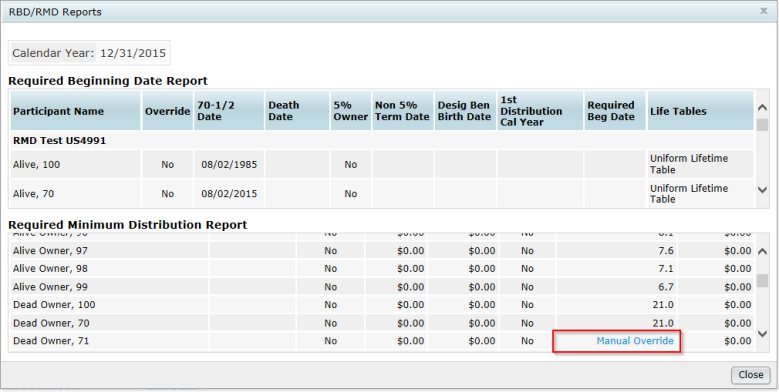
8.5. Miscellaneous Reports
Vesting Export Reports
There are four vesting report options. The links for these reports are located under Miscellaneous from the Compliance Menu and will become available only after the data scrub has been run. Note: These reports will populate with data only after sources have been set up in Plan Specifications à Sources and Inv Accounts.
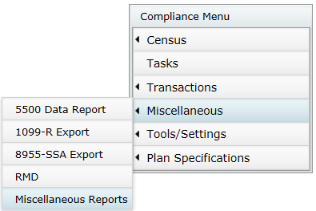
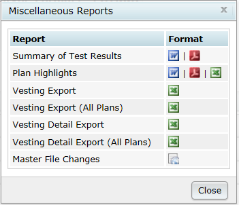
The “Vesting Export” report contains data for a single plan that is used to help calculate a participant’s vested account balance. The “All Plans” option will print all of the data in the “Vesting Export” report for all plans. FTW Company Number, FTW Plan Number and Customer ID columns were added to the “All Plans” reports to help users identify and sort companies and plans easier.
- Participant Name, SSN and Birth Date: This data will populate from uploading it through a census grid.
- Yrs Service: This column shows the total number of years (current plus prior years) of vesting service attained.
- Participation Start: Populates with the earliest date of participation from the participant master record if normal retirement age includes a service requirement. The system will not calculate earliest participation date for those who have not attained the age component of NRA
- NRA: This populates with “Yes” if the participant has attained normal retirement age and “No” if they have not.
- NRA Date: If a participant has attained normal retirement age, this column will populate with the date they attained it. If a participant has not yet reached normal retirement age this column will show “N/A”.
- FTW Source: These are the sources that are setup/available as selected in General Features/Sources and Inv Accounts.
- External Source: If you upload transaction data from an external source, the sources must be mapped from the external source to the FTW sources. This will have been done in the Transactions/Statements menu. This column shows which external sources were mapped to each FTW source.
- Vesting Override: This will populate with “Yes” only if the vesting percentage was overridden in the vesting override screen.
- Prior Distribution: Include distributions in years ending before the plan year begins. This includes distributions, in-service, loan default, ADP/ACP corrections (that are coded as such in the Transactions/Statements menu as such).
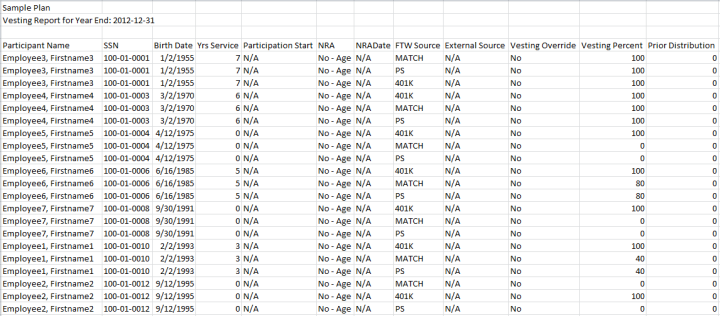
The “Vesting Detail Export” report is very similar to the “Vesting Export” report. It includes all of the same columns for a single plan, but also adds two historical columns.
- Hire/Term History: The first row for each participant will display the hire date and any termination dates applicable to the participant.
- Service History: The first row for each participant will display service hours earned for each year. If no historical data was entered for years prior to the first plan year on the system, the system will show “9999” hours earned to denote 1 year of service, then will show the number of prior years of service earned. For example, “2011-12-31 =>9999/6; 2012-12-31=>2080” means that a participant earned 6 prior years of service plus one year of service for 2012, for a total of 7 years of service as of 2012.
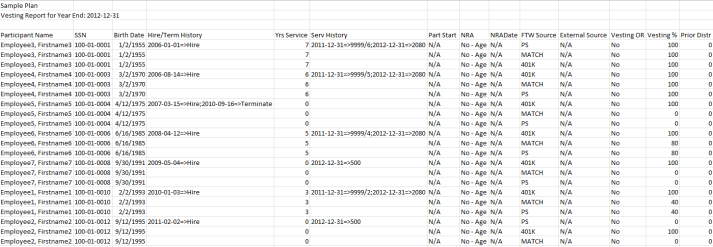
The “All Plans” option prints the same data as the “Vesting Detail Export” for all plans. Additionally, FTW Company Number, FTW Plan Number and Customer ID columns were added to the “All Plans” reports to help users identify and sort companies and plans easier.
Summary of Test Results
The Summary of Test Results report gives an overview of the results of compliance tests run. It will also let the user know if a test had not been run.


Limits test
The limits test includes:
- IRC §415 test – Tests to make sure no participant exceeds the annual additions limit for the applicable plan year.
- IRC §402(g) test – Tests to make sure no participant exceeds individual deferral contribution limit set for the applicable plan year.
- Plan limit test – Tests to make sure no participant exceeds plan limits set by the plan document (as applicable).
Each test will show either, “Not run”, “PASS” or “FAIL”. If any of the tests fail, the overall result will be FAIL.
410(b) Ratio Percentage Test
The 410(b) Ratio Percentage Test includes a separate coverage test for:
- Elective Deferrals
- Match
- Non-Elective
Each test will show either, “Not run”, “PASS” or “FAIL”. If any of the tests fail, the overall result will be FAIL.
Deduction Limit
The Deduction Limit tests to total employer contributions against total eligible compensation to verify that the deduction limit for the plan has not been exceeded.
Each test will show either, “Not run”, “PASS” or “FAIL”.
Compensation Testing
The Compensation Test includes a separate test for:
- Match
- Non-Elective
The tests compare the applicable HCE compensation ratio with the applicable NHCE compensation ratio to verify that the difference is not greater than the de minimis amount entered.
Each test will show either, “Not run”, “PASS” or “FAIL”. If either of the tests fails the overall result will be FAIL.
ADP Test
The ADP test will either show “PASS” or “FAIL”. If the plan is a safe harbor plan, the ADP test will not appear in this report. If the ADP test shows a “PASS” result, then the “Refunds due” and “Estimated QNEC” will show as “N/A”. If the ADP test shows a “FAIL” result, the “Refunds due” will show a dollar amount of total refunds due to be distributed. If the ADP test fails and the plan specifications permit a QNEC as a correction method, the “Estimated QNEC” will show a dollar amount equal to the total amount estimated to provide a passing result.
ACP Test
The ACP test will either show “PASS” or “FAIL”. If the ACP test shows a “PASS” result, then the “Refunds due” and “Estimated QNEC” will show as “N/A”. If the ACP test shows a “FAIL” result, the “Refunds due” will show a dollar amount of total refunds due to be distributed. If the ACP test fails and the plan specifications permit a QNEC as a correction method, the “Estimated QNEC” will show a dollar amount equal to the total amount estimated to provide a passing result.
Associated Match Forfeitures
If the ADP test fails and refunds result in associated match forfeitures, the total amount of associated match forfeitures will appear here. If no associated match forfeitures are required this row will show “N/A”.
General Test
The General Test shows a separate test for:
- Rate Group Test (at 70%) – Note: if the Rate Group Test passes at midpoint, this line will not appear on the report.
- Rate Group Test (at midpoint)
- Gateway Test
- General Test – Average Benefits Test – Note this line will appear if Rate Group Test (at 70%) fails.
Each test will show either, “Not run”, “PASS” or “FAIL”.
Top Heavy Test
The top heavy test will show either “Not run”, “PASS” or “FAIL”. The Top Heavy Percentage will show the key employee asset percentage in comparison to the total assets in the plan as outlined in the IRC for either a “PASS” or “FAIL” result. If the top heavy test was not run the Top Heavy Percentage will show “???”.
Part 9: Tools/Settings
9.1. Clone
The “Clone” feature allows you to make an exact copy of a plan, within the Compliance software. You will first need to add a plan to the database - this will be the destination plan; you may clone plan specifications only, or both plan specifications and participant data.
- Clone Plan Specs and Participant Data – in addition to copying plan parameters, investment accounts and sources, census data, transaction batches and participant loans will also be copied.
- Clone Plan Specs Only – this will copy plan specifications for the current plan year, including plan parameters, investment accounts and sources. Please note that census data, transactions and loans will not be copied with this option.
The “Clone feature” is located in the Compliance Menu, under “Tools/Settings”.
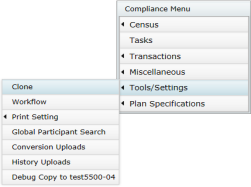
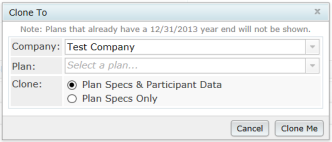
The “Clone Me” feature will create a copy of the plan Compliance module data to another plan. Below are the suggested steps to clone a plan year end.
- Create the destination plan – the plan that you wish to copy the original plan to.
- Select the original plan and go to the Compliance software.
- Click the “Clone” link
- Select the Company and Plan you wish to copy the existing plan to.
- Select “Clone Plan Specs only” or “Clone Plan Specs and Participant Data”.
- When you see “Plan is cloned”, return to the previous screen.
- Navigate to the clone.
- If you cloned participant data you will need to run the data scrub, allocations & testing.
9.2. Workflow
The Workflow Grid is located in the Compliance Menu, under “Tools/Settings”, by clicking “Workflow”.
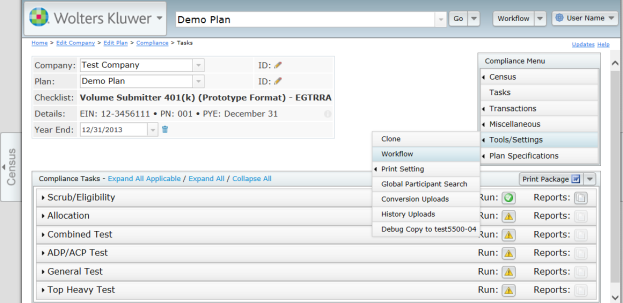
This is a global grid, listing each plan under a customer’s account to which a year end has been added in the Compliance software and showing whether or not each task has been run. Most entries in the grid are automatically updated by the software when the task in question is performed. Note that you can sort any column by clicking on the column name; you can also export the grid to Microsoft Excel via the “Download Spreadsheet” link.

The grid includes the following columns:
- Plan Name
- Year End
- Census Prep - whether the census has been prepared and posted to the portal (for portal customers only).
- Census Send - whether the census has been sent to the client via the portal (for portal customers only)
- Census Rec - whether the census has been uploaded
- Scrub - whether the data scrub has been run
- Alloc - whether the allocation has been run.
- ADP/ACP - whether the ADP/ACP tests have been run.
- Comb - whether the Combined Test has been run.
- Gen Test - whether the General Test has been run.
- Top Hvy - whether the Top Heavy Test has been run.
- C Pack - whether the Client Package has been prepared.
- Resp - for customer use to indicate whether responsible for the plan.
- Admin - for customer use to assign an Admin to the plan. All system users with Admin access will be available to select from the drop-down box.
9.3. Print Settings
From the Compliance Menu, hover over “Tools/Settings” à “Print Setting”, then press either “Plan Level” or “Global”. The “Global” settings can also be accessed from the top of the “Select Printing Parameters” page by clicking on the link “Global Printing Parameters”.
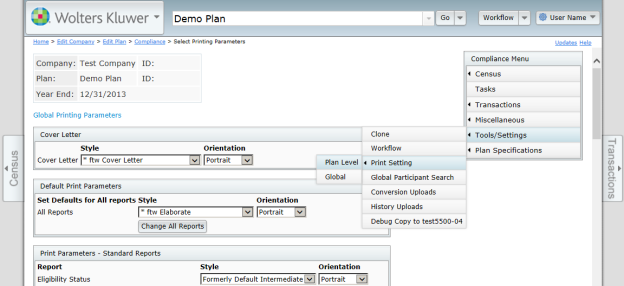
9.3.1. Global
You can design your own styles and save them as options for future selection for individual plans, modify the default client letter and add custom language in global settings.
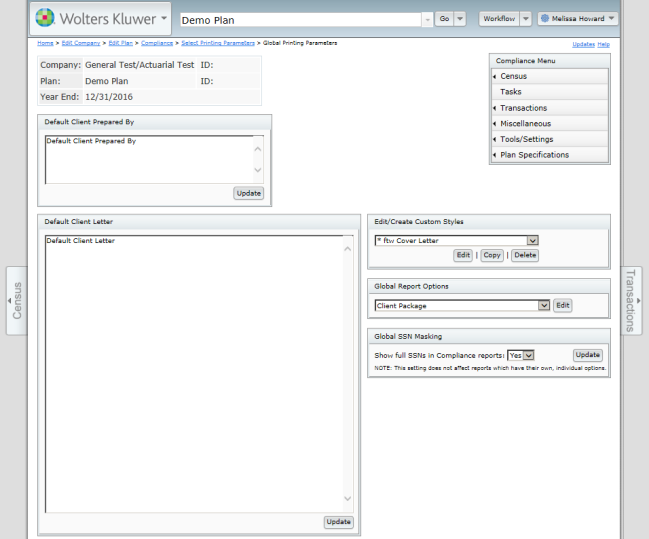
Set Default Client Letter
Click on the “Global Printing Parameters” link on the “Select Printing Parameters” screen (or from “Tools/Settings” in the Compliance Menu, clicking the “Global” option under “Print Setting”). Here text for a default global letter can be added and will be available for use with all your clients. Type or paste the text for the letter in the lower block of the “Default Client Letter” section, then click “Update”. This letter can be the default for all of your clients so you will just need to customize it for the particular client and package you are sending.

Edit/Create Custom Styles
Click on “Global Printing Parameters” at the top of the “Set Printing Parameters” page or select the “Global” print setting option from the Compliance Menu under “Tools/Settings”. The first box on the “Global Printing Parameters” screen is where you can edit/design one or more custom styles for your client letter and reports. The style options include using one of the default styles already set up, or adding your own custom style. You’ll see the following options in the drop-down box on this screen:
- *ftw Cover Letter
- *ftw Plain
- *ftw Intermediate
- *ftw Elaborate
To create your own custom client letter style, select “*ftw Cover Letter” in the drop-down box on the “Edit/Create Custom Styles” box and click “Copy”.
Custom Cover Letter Styles
You will see the “Custom Styles” screen shown below. You should edit the description field to indicate who owns it (e.g. call it “John’s Cover Letter”), then you can change the font type, margins and font size to reflect your own preferences. After you click “Return” this new style will be available to select for all your client letters. Please note that you cannot edit a default style; you need to copy it and then you can edit the copy.
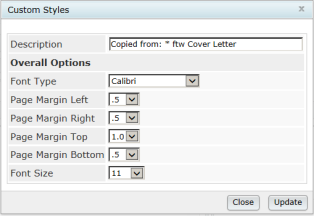
Custom Report Styles
You can also set a default style for your reports and statements from the same screen as the default letter style (the “Edit/Create Custom Styles” page). There are three default styles set up already - “*ftw Plain”, “*ftw Intermediate” and “*ftw Elaborate”. Again these are not editable but you can either use one of them as is, or you can copy and edit one or more of them to create your own custom styles. To do this, select one of the three default styles from the drop-down box and select “Copy This Style”. You can change the description to reflect who created it and what style it was copied from. You can also select the font type, color and size for the different sections of the reports as well as margin width. To the right is the top of the screen that you’ll see when you select a style and elect to copy (or, if it has already been copied, edit it):
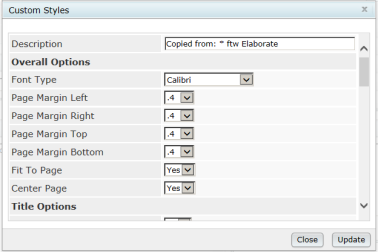
Custom Report Styles - Statement Options
As well as selecting a print style for your statements as described above, you can include plan specific messages on the statements and also display the investment related notice language required by the 2006 Pension Protection Act (PPA) for certain plans. Plans are required to provide the statement if the plan is an individual account plan (other than a one-participant plan) and allows participants/beneficiaries to direct the investment of assets in his or her account under the plan.
You may now use the Custom PPA Message /Message 3 when Include Default PPA Information is "No". This is valuable when PPA is not needed and you have a larger communication to be included in the statements.
See the screen shot below - this is the statement section of the “Edit Print Styles” screen and is available for both statement formats, the Individual Participant Statement and the Custom Participant Statement.
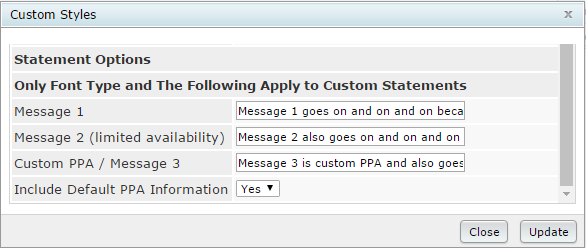
There’s more information about the difference between the two formats below.
The text you enter in the “Message 1” box shown above will be printed at the top right of the first page of the statement. Please note that the “Message 2” box is only available for the Custom Participant Statement (hence the note about limited availability) and prints in the section “Your Account at a Glance”.
You can select whether or not to add the PPA investment language by setting “Include PPA Information” to “Yes”. If you opt to include it, the text that will be printed on the statements is as follows:
“To help achieve long-term retirement security, you should give careful consideration to the benefits of a well-balanced and diversified investment portfolio. Spreading your assets among different types of investments can help you achieve a favorable rate of return, while minimizing your overall risk of losing money. This is because market or other economic conditions that cause one category of assets, or one particular security, to perform very well often cause another asset category, or another particular security, to perform poorly. If you invest more than 20% of your retirement savings in any one company or industry, your savings may not be properly diversified. Although diversification is not a guarantee against loss, it is an effective strategy to help you manage investment risk.
In deciding how to invest your retirement savings, you should take into account all of your assets, including any retirement savings outside of the Plan. No single approach is right for everyone because, among other factors, individuals have different financial goals, different time horizons for meeting their goals, and different tolerances for risk.
It is also important to periodically review your investment portfolio, your investment objectives, and the investment options under the Plan to help ensure that your retirement savings will meet your retirement goals.
Department of Labor information. For more information regarding individual investing and diversification, see the internet website of the U.S. Department of Labor at: www.dol.gov/ebsa/investing.html”
There is also an option to add your own custom PPA related message, which will appear above the standard PPA language on the statement. You enter this in the “Custom PPA Information” box.
Global Report Options
From within Global Printing Parameters, users can customize a variety of options for each of the available reports. The ability to customize reports is located under the "Global Report Options" box. To select a report to edit, press the drop down arrow next to the edit button, select the applicable report and press the edit button. Checking the box next to an option will include the option in the specific report for all plans. Leaving a box blank (or removing the check mark from the box) will exclude the option for that specific report for all plans. When done making selections, press "Save & Close". Below will describe the individual reports and options available for those reports.
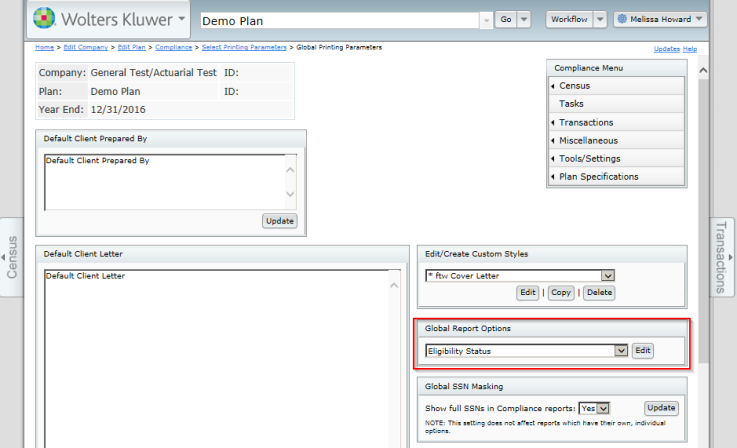
The Client Package has the option to individually include or exclude the Client Letter, Cover Page or Table of Contents. This means that the options selected here will be the options seen when the Client Package is printed for every plan.
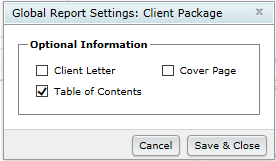
Eligibility Status Report can be sorted by name, status, compensation, or hours, in either ascending or descending order. Additionally, certain information can be included or excluded from the Eligibility Status Report. This information includes, participant SSNs (masked or full), compensation, deferrals, Roth, and the columns that display whether initial or continuing eligibility has been overridden. Dollar signs can also be included or excluded from the report. The options selected here will display or not be displayed in the Eligibility Status Report for every plan.
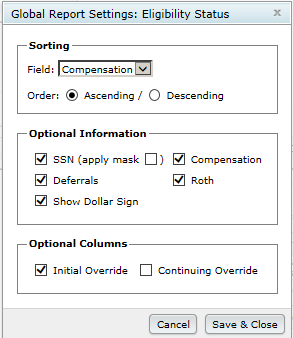
Allocation Report can be sorted by name or status, in either ascending or descending order. Additionally, certain information can be included or excluded from the Allocation Report. This information includes, participant SSNs (masked or full), division and status. Dollar signs can also be included or excluded from the report. The options selected here will display or not be displayed in the Allocation Report for every plan.
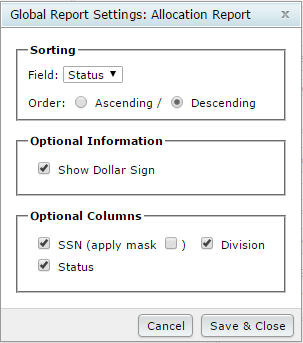
Transaction Reports and Statements can also be customized. Every transaction report/statement option that can be edited has its own global report setting. This means that different options can be selected for different statements/reports. Below, for example, are the options available for "Statements - Custom Individual Participant". The options here can be set differently than those set for "Statements - Individual Participant" or other statement options. Options available for statements include sorting by name and status, including or excluding employee SSNs or employee number (as defined in Plan Specifications --> General Features), dollar signs and fees. Including fees will carve out the fees from the earnings or gain/loss column and display them in a separate fees column.
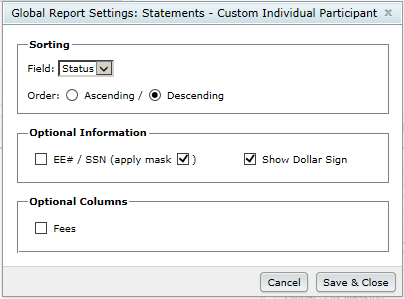
The ADP/ACP Test Detail Report can be sorted by name (alphabetically), compensation or status. Users can choose to have dollar signs appear and to include or exclude employee SSN (masked or full) or employee number (as selected in Plan Specifications --> General Features), division and status columns.
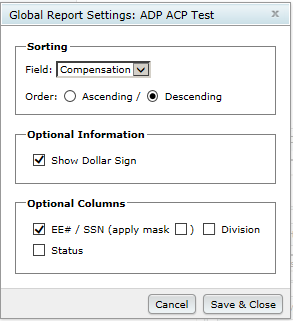
The ADP/ACP Test Corrections Report can be sorted by name (alphabetically), compensation or status. Users can choose to have dollar signs appear and to include or exclude employee SSN (masked or full) or employee number (as selected in Plan Specifications --> General Features), 402(g) catchup and status columns.
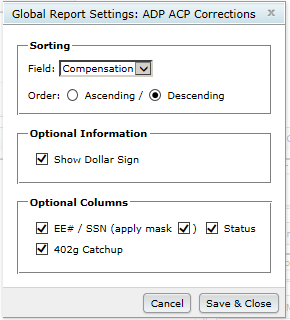
The Estimated QNEC report can be sorted by name (alphabetically), compensation or status. Users can choose to have dollar signs appear and to include or exclude employee SSN (masked or full) or employee number (as selected in Plan Specifications --> General Features), division and status columns.
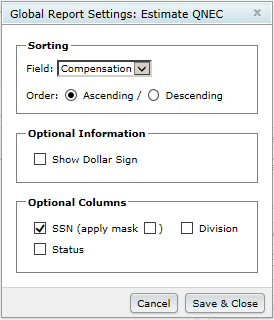
9.3.2. Plan Level
In the "Select Printing Parameters" screen are options to add a default cover letter, select a printing style and orientation for this cover letter and each of the reports.
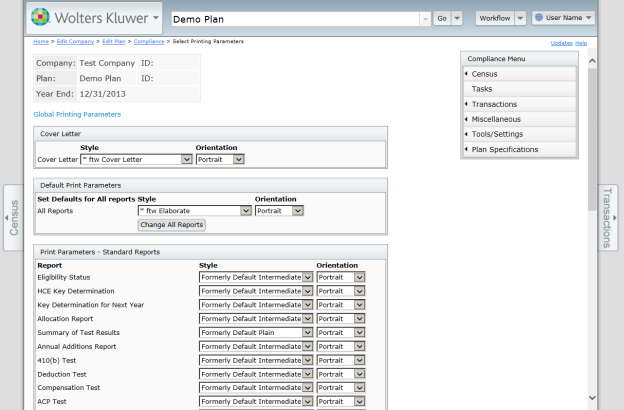
Having designed custom styles for the client letter and reports, the next step is to select a style or styles to use and their orientation. The custom styles previously created will display as options in the drop-down box within the “Select Printing Parameters” screen. On this screen you can select a print style for your client letter, and for each of your reports and statements. You can either select one style for all reports and statements or you can select the styles individually for each report and each statement type. See the screen shot below - the box in the middle allows you to select a single style for all reports and statements whereas the box below is where you make the individual selections for reports. A further option is the orientation for the report - whether you prefer Portrait or Landscape

See the screen shot below - this is the statement section of the “Edit Print Styles” screen and is available for both statement formats.
If you opt to make individual style selections for statements, you do this directly below where you select report styles.
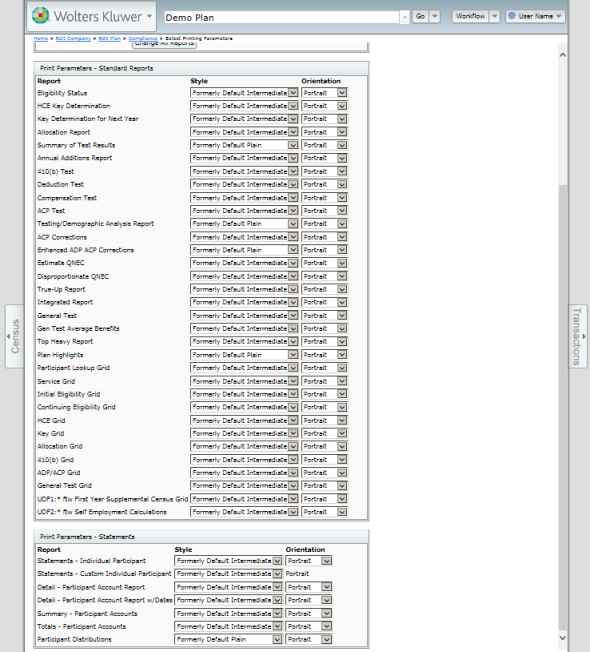
9.3.3. Custom Reports
Certain reports in the Compliance Module are able to be customized, giving the ability to add, move and remove columns; change table column widths; change font type, size and color; filter to show only certain data; and change sort order. These changes can then be saved and used for all of your plans.
Accessing Custom Reports
Custom reports are located throughout the software. Below is a list of current reports and where they are located.
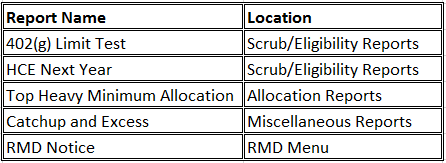
Editing Custom Reports
Custom reports can be edited by clicking on the custom report icon (![]() ) that appears next to all custom reports. This opens the report in a web view, where the user can add or remove columns, change text font type, sizes or colors, rearrange column positions, filter the report to only show certain criteria or change the sort order.
) that appears next to all custom reports. This opens the report in a web view, where the user can add or remove columns, change text font type, sizes or colors, rearrange column positions, filter the report to only show certain criteria or change the sort order.
Below is a screenshot of the Scrub/Eligibility Report window. There are two custom reports here; the 402(g) Limit Test and HCE Next Year. Both of these reports have the custom report icon (![]() ), which will access the web view of the applicable report.
), which will access the web view of the applicable report.
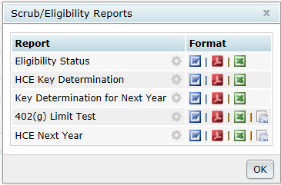
Clicking on a column within the web view will make the formatting options appear for that column. The left most icon has three options: Formatting, Hide column, and Show columns.
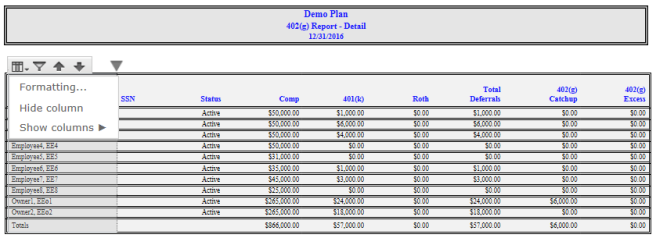
Clicking on the formatting option will open a new window with all of the font style, color and sizing options. Alignment options and conditional formatting options are also here. Note that changes will apply to the headings, detail rows or total rows as selected from within the window.
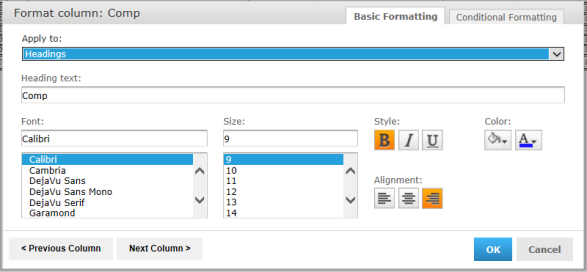
Clicking the option to hide a column will hide the column that you clicked on.
Hovering over the option to "Show columns" will expand the list of columns that are available to be added. You can select the option to add all available columns, or select one at a time.
Saving Custom Reports
After editing a custom report, you can save the report by clicking the save icon (![]() )in the upper left corner of the web view. You will save your reports in the folder tree under your company name by selecting the "save as" option. Note: See Permissions for additional information regarding who is permitted to save reports.
)in the upper left corner of the web view. You will save your reports in the folder tree under your company name by selecting the "save as" option. Note: See Permissions for additional information regarding who is permitted to save reports.
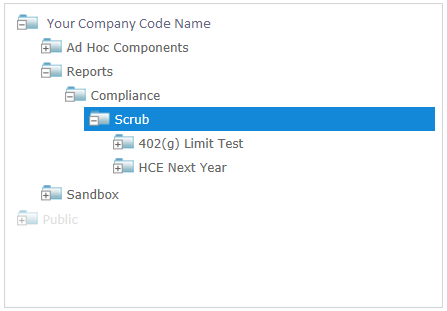
Printing a Custom Report
There are multiple print format options available for each custom report, such as rtf, pdf and excel. Simply click on the applicable icon next to the custom report to print the format of your choosing.
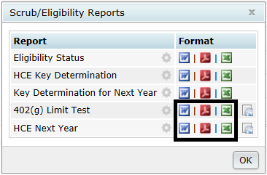
Custom reports can also be printed directly from the web view by clicking the export button in the upper left corner, then selecting the applicable format.

Global Custom Report Styles & Custom Report Selection
To view the current global report style and selected report for a custom report, click the gear icon next to the custom report. This will allow you to see the options selected for that report. Note that the Global Report Style that is selected applies to all custom reports.
![]()
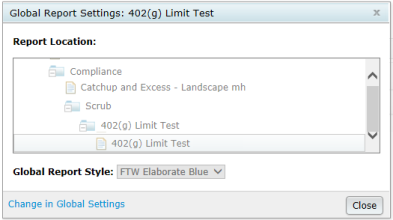
To change these settings, Designated Admin users may either click the "Change in Global Settings" link or navigate to the Global Report Options from the Compliance Menu.
Print styles that are selected within the web view, will apply for reports printed from the web view only. To specify a specific print style for a report to use in the client package or individual print, the style must be selected from the Global Report Options.
Custom Reports Permissions
Custom Reports permissions determine whether or not a user can save a custom report and, if permitted to save, the location where they are permitted to save reports. The "Permissions" box in the Edit Users screen has a drop down next to "Custom Reports", containing options of Admin, Intermediate and Read Only.
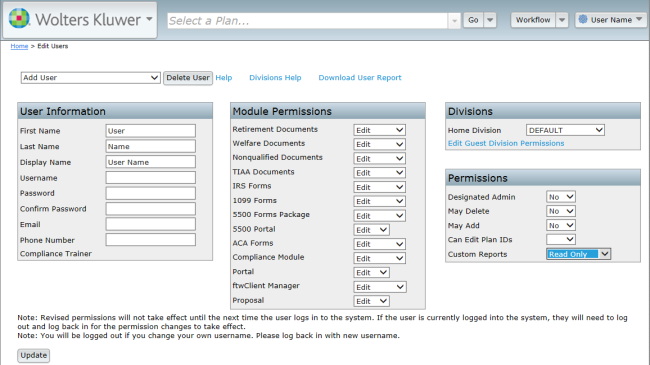
When in the Custom Reports web view:
- Users with “Admin” selected for Custom Reports are allowed to save reports in any repository folder.
- Users with “Intermediate” selected for Custom Reports are allowed to save reports in the Sandbox folder only.
- Users with “Read Only” selected for Custom Reports are not allowed to save reports in any repository folder.
Note: Any user with “Yes” selected for Designated Admin, receives “Admin” permissions for Custom Reports by default. All other users receive “Read Only” by default. Changes to these permissions would need to be made by a Designated Admin in this screen.
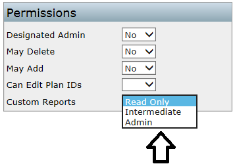
9.4. Global Participant Search
Click “Global Participant Search” from the Compliance Menu under “Tools/Settings”.

The Global Participant Search enables a user to search for a participant across all companies and plans within a user’s company code. Then, with the click of a button the user can be directed to the plan in which the participant belongs.
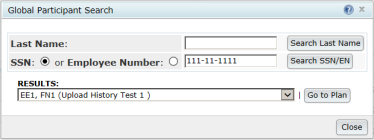
Search Options
Inside Global Participant Search, the user has three search options: last name, social security number or employee number. If searching by social security number or employee number the participant(s) who exactly match the number entered will be listed in a drop-down box. That is, no partial searches are done for those two options. If you search by last name, however, you can type in the entire last name or just part of and the search results will contain all participants matching your entry.
Note: If the total participant count from all companies and plans combined is less than 100, only the drop down box will appear. That is, there are no search options.
Selecting a participant/plan
Once you have entered your search criteria and pressed the search button, all participants matching that criteria will be listed in the “Results” drop-down box. Click on the drop-down box to review the list of participants. The plan that each participant is associated with is shown in parenthesis next to the participant name. To go to that plan, select the participant and click “Go to Plan”.
Note: If divisions are used and a participant is located in a plan the user does not have accessibility rights to, the user will be able to see that a participant is in that plan but will not be able to access the plan.
9.5. Conversion Uploads
Conversion Uploads are accessed from the Compliance Menu, under “Tools/Settings”.
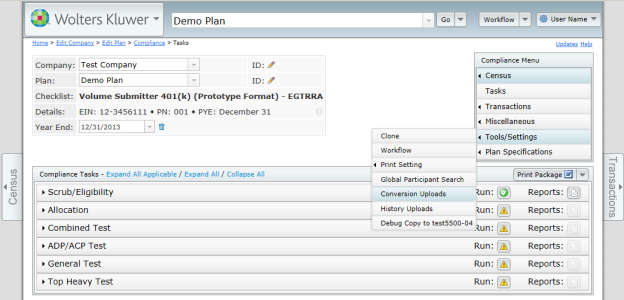
The options “Map DC Sources” and “DC Windows” are for upload of Datair participant information and end of year balances. You first need to click “Map DC Sources” and enter the two digit codes for each Datair source according to the appropriate ftwilliam source, indication where it should be mapped. Once you have done that you can click on “DC Windows” and upload your Datair file.
The options “Create DER Template” and “Upload DER” are for importing data from Relius. You will first need to click “Create DER Template”; this will open a Microsoft Excel spreadsheet formatted for entering data from the Relius system. You can then downloaded your data and enter it into the spreadsheet and save the spreadsheet as a .csv file. Next you would upload it using the “Upload DER” link.
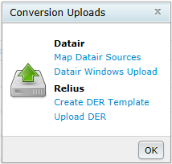
9.6. History Uploads
History Uploads are located under “Tools/Settings” from within the Compliance Menu.

The History Upload options give users the ability to upload service, compensation, contribution and distribution records from the inception of the plan to the current plan year. If you will be uploading the history records in the first year the plan is in the ftwilliam Admin, you will need to continue to use your conversion grid or a supplemental grid to upload the cumulative years of service fields. Please note if the plan has multiple years in the ftwilliam system you may upload the history records in the current year, remembering to include in the history file the data for any prior years in the system.
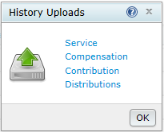
Service History Upload
Click on the ‘Service’ link to access the ‘Service History Upload Menu’, where you may select a file to upload the service history for all plan years up to the current plan year. There are four types of service history that can be uploaded here:
- A - Hire/Terminate
- E - Eligibility Service
- V - Vesting Service
- B - Benefit (participation) Service
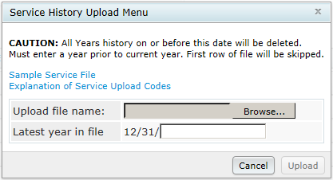
A sample service history file can be downloaded to show the user how the data must be uploaded.
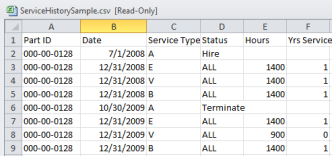
To enter a hire/terminate record:
- Column A – Enter participant’s social security number
- Column B – Enter the date of hire or termination (in mm/dd/yyyy format)
- Column C – Enter ‘A’
- Column D – Enter ‘Hire’ or ‘Terminate’ as applicable
- Columns E and F – Leave Blank
To enter a eligibility/vesting/benefit history record:
- Column A – Enter participant’s social security number
- Column B – Enter the date (in mm/dd/yyyy format) of the applicable plan year end
- Column C – Enter ‘E’, ‘V’, or ‘B’
- Column D – Enter ‘All’ for all sources; ‘ED’ for elective deferral source; ‘MT’ for match source; and ‘NE’ for non-elective source.
- Column E – Enter the hours earned during the applicable year.
- Column F – Enter the years of service earned during the applicable year.
So in the above example, participant 000-00-0128 was hired on 7/1/08. In 2008 she had 1400 hours and one year of service of service for eligibility, vesting and participation. She terminated on 10/30/09; in 2009 she had 1400 hours and one year of service of service for eligibility and participation, and 900 hours for vesting with no service.
Note: The history for multiple years should be uploaded in one history file. All history in year or prior to the year entered will be deleted.
The service history will be updated with current year data when the Do Data Scrub task is done.
There is also a link to an ‘Explanation of Service Upload Codes’ for additional help.
Compensation History Upload
Click on the ‘Compensation’ link to access the ‘Compensation History Upload Menu’, where the user may select a file to upload the compensation history for all plan years up to the current plan year.
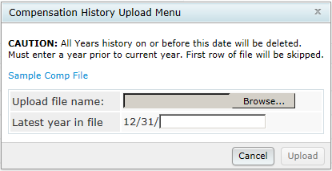
To enter a compensation record:
- Column A – Enter participant’s social security number
- Column B – Enter the date (in mm/dd/yyyy format) of the plan year end
- Column C – Enter gross compensation for the participant
Note: The history for multiple years should be uploaded in one history file. All history in year or prior to the year entered will be deleted.
The compensation history will be updated with current year data when the Do Data Scrub task is done.
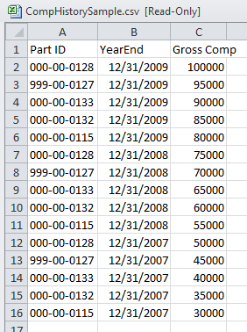
Contributions History Upload
Click on the ‘Contributions’ link to access the ‘Contributions History Upload Menu’, where the user may select a file to upload the contributions history for all plan years up to the current plan year.
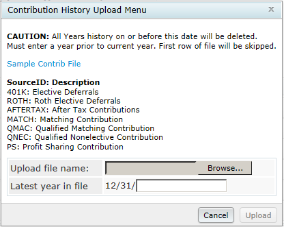
To enter a contribution record:
- Column A – Enter participant’s social security number
- Column B – Enter the date (in mm/dd/yyyy format) of the
- Column C – Enter applicable contribution amount for the participant
- Column D – Enter the applicable SourceID (as shown in the Contributions History Upload Menu)
Note: The history for multiple years should be uploaded in one history file. All history in year or prior to the year entered will be deleted.
The Contribution history will be updated with current year contributions when the contribution transactions are posted and the user “Prints” any report in the Transaction Menu with the Statement Dates of the first and last day of plan year.
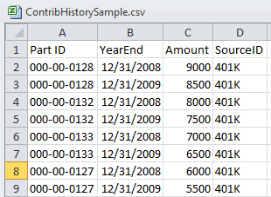
Distributions History Upload
Click on the ‘Distribution’ link to access the ‘Distribution History Upload Menu’, where the user may select a file to upload the distribution history for all plan years up to the current plan year.
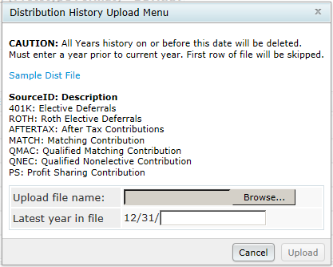
To enter a distribution record:
- Column A – Enter participant’s social security number
- Column B – Enter the date (in mm/dd/yyyy format) of the
- Column C – Enter applicable contribution amount for the participant
- Column D – Enter the applicable SourceID (as shown in the Contributions History Upload Menu)
Note: The history for multiple years should be uploaded in one history file. All history in year or prior to the year entered will be deleted.
The Distribution history will be updated with current year distributions when the distribution transactions are posted and the user “Prints” any report in the Transaction Menu with the Statement Dates of the first and last day of plan year.
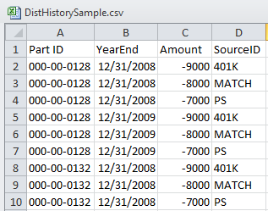
Part 10: Special Topics
10.1. Use of the system for the first testing year
Click here for more information on adding historical data
This section will take you through some special steps you should complete for the first year the plan is on the ftwilliam.com Compliance system. In general, once these set up steps are completed, you should not have to repeat them for future years unless plan specifications change or you choose to capture different census data for a plan.
If it is not the first plan year a plan is in existence, the system will not have a history of service, compensation and other information that may be necessary for testing. There are therefore a few extra steps to take when setting up an existing plan for testing on the ftwilliam.com Compliance system. These steps will also be explained below.
New plan
If it is actually the first year for a given plan, you must select this in the Plan Specifications menu under "General Features/Accounts and Sources" you will find the question "Indicate if this is the first Plan Year for a new plan" in the first section (General Plan Features). For the first plan year, most of the information necessary to do calculations and make determinations will be provided in the census and plan specifications. There may be a few extra pieces of information that you will want to include through the Other Import/Export/Reports Menu, depending on how extensive your census spreadsheet is (ownership information, etc.).
If you enter information into the Other Import/Export/Reports Menu necessary for the census data scrub, you must first upload census data information, second upload/enter "Other Import/Export/Reports" data and finally, run the data scrub. This is because uploading a new census will clear out any current year testing data (fields marked with an "R") that may be entered on the "Other Import/Export/Reports" menu.
Existing plan
If it is not the first plan year for a plan but only the first year the plan is on the ftwilliam.com Compliance system, then there are at least a few extra data fields and/or spreadsheets that we suggest uploading to the system for proper testing (e.g. beginning balances and a variety of census data like earliest date of hire, cumulative years of service for vesting purposes, prior year compensation, etc.). Some different options are discussed below:
- Census Data Supplemental. The system has a default grid "Census Data Supplemental" that is set-up with a number of fields that are useful for a plan with multiple years of history. You can view/change the fields that are in the Census Data Supplemental grid under the Work With Data Entry Grids menu.
To upload or enter data into the Census Data Supplemental grid, you should first upload your census data for the plan. After that information is uploaded, you can go to the Other Import/Export/Reports Menu. You will need to select the Census Data Supplemental grid from the drop down box in one of the grids provided (you may want to select this for a User Defined Grid "UD Grid") and click on "Select Grids" towards the bottom of the page. Once the grid is selected you will have options to Edit data (where you can manually enter the information directly in the system), download a blank spreadsheet, upload a spreadsheet and print the grid. Once the census data and supplemental data have been entered into the system, you can do a Census Data Scrub to process the information.
The order you enter information is important because uploading a new census will clear out any current year testing data (fields marked with an "R") that may be entered on the "Other Import/Export/Reports" menu. Review the errors and census data reports carefully to ensure you have provided sufficient information to properly test the plan.
- First year census. As an alternative to the supplemental census, you could set-up a "first-year" census to use for plans new to the ftwilliam.com Compliance system that combines the normal census information, plus supplemental census data under the Work With Data Entry Grids menu. Under this scenario, little to no data would need to be uploaded via the Other Import/Export/Report Menu before a census data scrub is run.
- Prior year end. If possible, we also suggest adding plan year end data for at least the prior plan year to assist in providing a more full history for the system to use (including ownership and family relationship information; ending balances in the transaction menu; for example).
Depending on the amount of information you enter in the prior year-end, you will have more testing power in the current testing year. For example, if you would like to test top-heavy status for the current testing year (2009, for example) then it is necessary to know the balance of participants” accounts in the plan (ending balances under the transactions menu) as of the determination date for the testing year (12/31/08 for a calendar year plan).
For the first year on the system, you will need to enter an earliest date of hire at a minimum to account for service history. Some service history defaults that may apply in the first testing year depending on the extent of prior year data loaded on the system (each of these defaults will appear as an error after a census data scrub if applicable):
- If service is not known, the system will assume full-time work but will actually show "9999" as hours earned in the Eligibility history link. You can view the eligibility history link in the Service history grid under the Other Import/Export/Report Menu (more specifically, here).
For example, if it is the 2009 plan year end and you have a 2001 hire date without any hours of service provided before 2009, the system will decide that this person has 8 years of eligibility service history. In the Eligibility history link, the 2001 hire date will appear; and eligibility for each contribution type will appear with 9 years of service earned and hours of "9999".
- If a person has a hire date before the first day of the plan year, the person is eligible for the contribution and the entry date is not known, the system will use the day before the plan year as the entry date.
- Date met will default to the first day of prior plan year if a participant is found eligible and specific entry date is not known (not in the plan year end being tested, prior plan year ends on the system and not in the supplementary/first testing year census). Exception: if no service required, date met will be the same as the earliest date of hire.
10.2. Use of ftwilliam.com Compliance system after the first year the plan is on the system
Closing out the Previous Year
- Make sure the old year is clean & complete on the testing side. Whether this was the first year on the system or not, before closing out the year you should make sure that the data is correct since it will provide a basis for the next year. You should not see any warnings or error messages on the home page or any other screen. In particular:
- The data scrub should be run.
- The top heavy test should be run, unless this year was the conversion year from the prior record keeper.
- Add an ending balance batch on the transaction menu and post it – this will allow you to add a pre-populated beginning balances batch when you go to the new year.
Adding the New Year
- Add the new year end by clicking the link “Add New Year End” at the top of the home page; the date will default to the end of the current year so be sure to change it to the correct year end. If the plan is on an ftwilliam.com document, you’ll get an option to copy plan specifications from the document, or from the prior year on Compliance. Plan specifications only copy from the plan document when you add a new year-end, so if you made any mid-year changes to the document, these would not automatically copy to Compliance. If copying from the document, review general features, date formats and accounts & sources.
- Review your census grid. If the previous year was a conversion year from your prior vendor, you will need to switch to a standard grid – we suggest one of our “core” grids as follows:
- * ftw Primary 1 Census (comp and comp after elig) (c1eb549) - for plans using entry date compensation for plan purposes
- * ftw Primary 2 Census Statutory Comp Only (f0e744e) - for plans using full year compensation for plan purposes
- * ftw Primary 3 Census Fiscal Plan Year (efb0e0a) - for non calendar year plans
- * ftw Primary 4 Census exclude certain comp(414s comp test) (d915e5d) - for plans using a non 414(s) compensation definition
- Download the census grid – the “Download prior” link will produce a spreadsheet pre-populated with last year’s data that you can forward to the client. They will need to add any new employees as well as hours, compensation and deferrals for the new year, and any termination dates that occurred in the new year. They will also need to confirm officers, ownership, and family coding.
- If processing the new year as a subsequent year on the system, overrides should not be necessary for eligibility, years of service or HCE/key determinations; the software will do these calculations.
- If you are uploading an employer contribution on the census, remember to set the appropriate overrides on the Set Allocation Parameters screen before running the data scrub.
- On the Transactions menu screen, add the beginning balances batch and post. Note that provided you added the ending balances batch in the prior year you will have an option to “Create Beginning balance from Prior Year’s Ending Balance”.
10.3. Eligibility History
The system will calculate eligibility based on the plan specifications (age, service and entry dates) set in the Compliance system. For the first year on the system, you will need to enter an earliest date of hire at a minimum to account for service history.
Defaults (each of these defaults will appear as an error after a census data scrub if applicable):
- If the system does not have a hire date for an employee, it will set the hire date to the first day of the plan year.
- If service is not known, the system will assume full-time work but will actually show "9999" as hours earned in the Eligibility history link. You can view the eligibility history link in the Service history grid under the Other Import/Export/Report Menu (more specifically, here).
For example, if it is the 2009 plan year end and you have a 2001 hire date without any hours of service provided before 2009, the system will decide that this person has 8 years of eligibility service history. In the Eligibility history link, the 2001 hire date will appear; and eligibility for each contribution type will appear with 9 years of service earned and hours of "9999".
- If a person has a hire date before the first day of the plan year, the person is eligible for the contribution and the entry date is not known, the system will use the day before the plan year as the entry date.
- Date met will default to the first day of prior plan year if a participant is found eligible and specific entry date is not known (not in the plan year end being tested, prior plan year ends on the system and not in the supplementary/first testing year census). Exception: if no service required, date met will be the same as the earliest date of hire.
10.4. Recalculate Initial Eligibility
In the first plan year of the system, to have the system recalculate initial eligibility on a global basis, simply reupload the census, setting "Reset Entry Dates" to yes from within the Census Upload box. Then run the data scrub. Review the "Eligibility Status Report" to confirm that eligibility is correct.
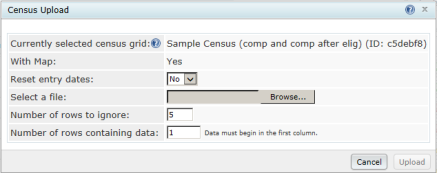
Eligibility should always be correct in the first year of the system so that subsequent years are also correct. There are cases where, in subsequent years in the system, eligibility may need to be recalculated; such as when an amendment has changed eligibility requirements. In these cases, initial eligibility can be recalculated on a global or individual basis by using the "Initial Elig - Recalculate (Yes/No) Upload" tool that is found in Tools/Settings from within the Compliance Menu.
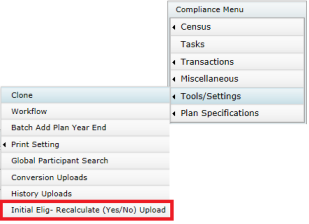
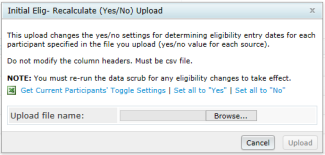
To have the system recalculate all sources for all participants in the census, click the 'Set all to "Yes"' link. This will automatically update every source for every participant to "Yes", recalculate. Close the box, then rerun the data scrub.
To have the system recalculate initial eligibility for only certain sources and/or certain participants, click the "Get Current Participants' Toggle Settings" link, and save this file to your computer. Open the file and change the individual sources/participants to "Yes" for those sources/participants for which you wish the system to recalculate eligibility. Note that leaving these fields blank will have the same effect as entering "No". Upload this file by clicking the "Browse" button from within the "Initial Elig - Recalculate (Yes/No) Upload" window. Close the box, then rerun the data scrub.
When the data scrub is now run, eligibility, dates met and entry dates will be recalculated for applicable participants/sources that were selected to be recalculated.
Please note that running the data scrub automatically resets all participant's recalculation fields to "No". Users can also click on the "Set all to 'No'" link to change the recalc field for all sources and all participants to "No".
10.5. Plan Aggregation
The plan aggregation option will take separate plans either within a single company or from multiple companies, combine certain data in a master plan and permit the user to run compliance tests and print reports using that combined data. The following steps assume that the user has already created each of the individual plans within the aggregation group. Additionally, for each of the individual plans, the user must have already setup the plan specifications, allocation formulas and imported/entered the census and transaction data as they normally would for a non-aggregated plan.
Set-up General Aggregation Specs
In order to aggregate multiple plans, the user must first setup the aggregation options in each individual plan. To do so, open the first plan in the aggregation group and click on “Set Combined Test Parameters” in the Compliance Menu. In the Aggregation/Disaggregation menu box, change the drop-down box next to “Testing Aggregation used:” to “Yes”. In the next box, enter a unique Testing Aggregation group ID. FT William suggests that the group ID be descriptive of the plans you are combining. Then set the “Plan containing combined census:” field to “Other Plan”.
Return to the Compliance Menu once the general aggregation set-up is complete. Run “Do Data Scrub/Elig Calc” and “Do Allocations”.
Repeat these steps for each of the individual plans in an aggregation group.
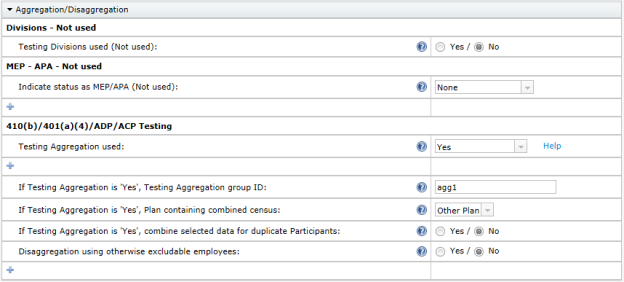
Set up Master Plan
Next the user will need to add a “Master Plan” to the system. The master plan is where certain census data will be combined and compliance tests run for a specific aggregation group. To add a new plan simply return to the Select Plan screen and click “Add Plan”.
The user must now setup the census grid, sources, and any plan specifications applicable to testing. Allocation parameters must be setup prior to setting up the aggregation option. First, set the match and non-elective overrides to “Yes”. Since the allocations are either uploaded or calculated in the individual plans, this will have no effect on the contributions brought in from the individual plans. Rather, if corrections are required, such as a QNEC for a failed ADP test, the override will prevent the combined contributions from being overwritten. Next, if an ACP test will be run and all of the plans in the aggregation group use the same match formula, enter the match formula into the Match allocation parameters. If a match formula is not entered any Associated Match Forfeitures will not calculate correctly. If the general test will be run, the user must enter the non-elective allocation percentages by group. If these percentages are not entered the auto correct options will not calculate correctly.
Once the new plan has been setup, click on "Set Combined Test Parameters", in the Compliance Menu to setup aggregation settings. In the Aggregation/Disaggregation menu box, change the drop-down box next to “Testing Aggregation used:” to “Yes”. In the next box, enter the Testing Aggregation group ID that was decided upon in setting up the general aggregation specs. To make this plan the master plan, set the “Plan containing combined census:” field to “This Plan”. “Combine selected data for duplicate Participants” gives the user the option of combining compensation for duplicate participants. If this box is set to “No”, the user will instead have the option of selecting the plan from which the compensation will be copied, disregarding compensation in the other plan(s). If it is set to “Yes”, compensation from all plans will be combined.
Caution: To be very clear, the master plan should be a new plan that never contained individual records. Clicking on “Combine Census in This Plan” will delete all master file and current participant records in this plan and replace them with records from aggregated plans. You MUST NOT click this button if the Plan was tested as an individual (non-combined) plan for any other Year End.
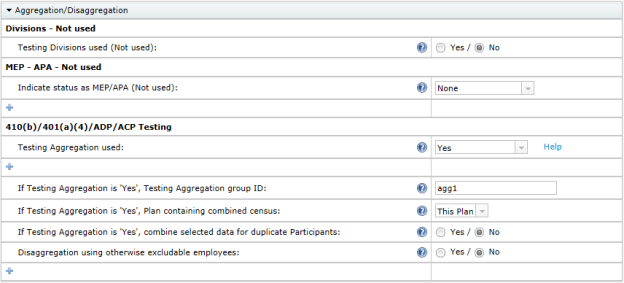
Combine Census for Aggregation Group
Upon returning to the Compliance Menu, the user will see that the “Select Task” menu box no longer contains the options to run “Do Data Scrub/Elig Calc” and “Do Allocations”. Instead there is a new option to “Combine Census for Group: Group ID”.
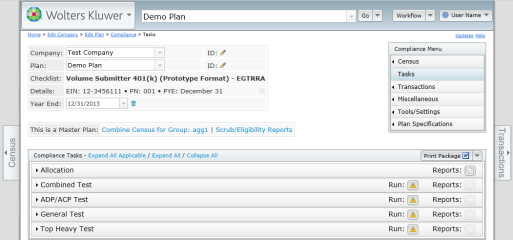
Pressing “Combine Census for Group: Group ID”, will take the user to a new screen to view the list of plans in the aggregation group, scrub and allocation status and plan specifications for those plans. Any warnings or errors will be listed here as well. Also in this screen will be a list of duplicate participants from any of the plans in the aggregation group. In this box the user will choose which plan to take the eligibility status, Key status, HCE status and (if not combining) compensation from.
Once the user has reviewed the plan specifications, any warnings or errors and selected which plan duplicate participant data should transfer from, the user should press “Combine Census in This Plan” and review any errors on the results page. When the “Combine Census in This Plan” button is pressed, contributions from all plans are combined, compensation from all plans is combined if the option in the setup screen was selected to do so, and all transactions from the Transactions Menu from each plan are brought to this plan.
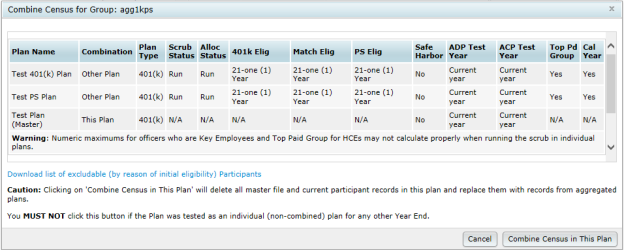
Compliance Tests and Reports
The user may now run the applicable compliance tests and corrections as normal and print the reports.
Miscellaneous Tasks
The RMD Menu, 1099-R Menu and 8955-SSA Menu are not available in the Master Plan. These tasks may only be run in the individual plans.
10.6. Aggregation of non-ftw plan with ftw plans
Overview
Users may combine non-ftwilliam.com (non-ftw) summary testing data with plans in ftwilliam.com (FTW) by entering the applicable non-ftw data in either the Combined Test Parameters page and/or ADP/ACP Test Parameters screen, so that those entered amounts can be aggregated with the amounts in the current plan for 410b, deduction and ADP/ACP testing. The following steps assume the plan specifications, source data and census data are already set up in the FTW plan.
Setup
To identify a plan in FTW as an aggregated plan, go to " Set Combined Test Parameters". The aggregation options are in the “Aggregation/Disaggregation” box and can be changed using the options for “Testing Aggregation Used”. The options for "Testing Aggregation used:" are:
- "Yes" (aggregate data at the participant level – plans on Ft. William),
- "No" (no aggregation) and
- "Yes - Non ftw plan" to indicate that aggregation will be performed using summary testing data from other Plans.
To aggregate a plan with a non-ftw plan, set “Testing Aggregation used:” to “Yes – Non ftw plan”, then press “Refresh”.

Enter Combined Test Data
Once the aggregation is set to “Yes – Non ftw plan” and the user has pressed the “Refresh” link, the “Review/Edit Non-ftw Data” link will appear.
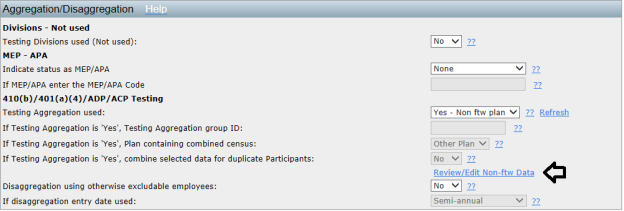
Clicking the “Review/Edit Non-ftw Data” link will take the user to the Combined Test Non-ftw Data screen. In this screen, users can enter data for the 410(b) Ratio Percentage Test (Coverage Test) and the Deduction Limit Test. The data entered here will be aggregated with the FTW plan data to produce aggregated test results.
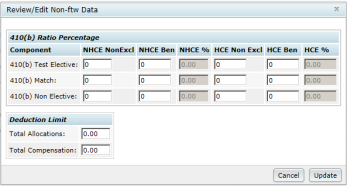
Enter ADP/ACP Test Data
To enter ADP/ACP test results for a non-ftw plan, click “Set ADP/ACP Testing Parameters”. In the second box of options, users will see “Plan Aggregation” set to “Yes – Non ftw plan” and a link to “Review/Edit Non-ftw Data”.

Clicking this link will take users to the ADP/ACP Non-ftw Data screen, where participant counts and total ADRs from Non-ftw plans can be entered.
- In the NHCE Cnt columns, the total number of NHCEs in the ADP/ACP test should be entered here.
- In the Total NHCE ADR/ACR columns, the total ADR for all NHCEs in the ADP test should be entered here.
- Similarly, in the HCE Cnt columns, the total number of HCEs in the ADP/ACP test should be entered here.
- In the Total HCE ADR/ACR columns, the total ADR for all HCEs in the ADP test should be entered here.
If the Non-ftw plan has collective bargaining agreement (Union) employees, click the “Add rows for CBA employees” button and complete the extra grid rows. Please note that clicking this button will appear to delete the data that was previously entered in this screen. The data has not been deleted. After completing all applicable boxes, press the “Update” button at the bottom of the screen.
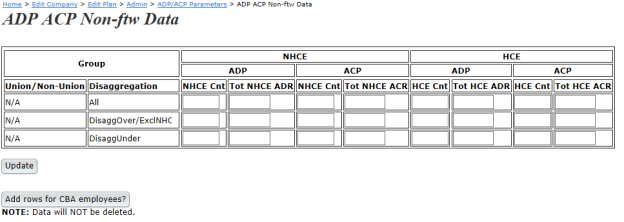
Now that all of the non-ftw plan data has been entered, users may run the data scrub, allocations, and tests as they normally would.
10.7. Disaggregation
The system has several fields that will display whether a person has met the minimum age and service requirements of Code section 410(a)(1)(A) (age 21 and 1 year of service) before the first day of the seventh month of the Plan Year. As provided in Treas. Reg. sections 1.410(b)-6(b)(3) and 1.410(b)-7(c)(3), a plan may treat a plan benefiting otherwise excludable employees (those not yet meeting age 21 and 1 year of service) as two separate plans for testing purposes.
The fields coded "disagg" will provide information about whether the Participant has met the minimum age and service requirements of Code section 410(a)(1)(A) before the first day of the seventh month of the Plan Year ("Eligible_Disagg", "Eligible_DisaggEligMet" and "Eligible_DisaggEntryDate" for example).
Eligible_Disagg will be "Yes" if a person is less than age 21 or has less than 1 year of service before the first day of the seventh month of the Plan Year. This means the participant will be in the disaggregated group for testing purposes.
Eligible_DisaggEntryDate will always be at the beginning of the year (1/1 for a calendar year plan). This is because Treas. Reg. sections 1.410(b)-6(b)(3) and 1.410(b)-7(c)(3) do not allow for "splitting participants" between different testing groups (i.e. if the disaggregation test allowed for semi-annual entry dates, a participant with a 7/1 entry date in a calendar year plan would be in the disaggregated group for the first six months of the year and in the other testing group for the second half of the year). In addition, informal conversation with the IRS has confirmed that disaggregated plans must use entry dates as of the first of the plan year.
10.8. HCE Determinations
HCE determinations are done at the time a census data scrub is run for a plan testing year. The system will not use top paid group determinations as a default. If you select top paid group determinations, you should ensure that this is selected for each year the plan is on the system.
The field "HCE" will display whether an employee is an HCE for current plan year testing purposes and "HCE Reason" will display a reason for the employee’s selection as an HCE. HCE determinations are made based on 1) ownership at any time during the current or preceding year and/or 2) the compensation in the preceding year.
For more information about how an HCE determination was made, select to "edit" the "HCE Data" grid under the "Other Import/Export/Report Menu". Here, you will see all the fields relevant to HCE determinations.
- For ownership determinations, "Percentage_Ownership", "Family_Group" and "Family_Group_Relation" are relevant fields.
- For prior year compensation, the field "Prior_Yr_Comp" is used.
Top paid group determinations
The field "HCE_TopPaidGrpPrior" is used to determine HCE status for current plan year testing purposes. The top paid group determination is entirely determined based on compensation rank in the prior year (HCE_TopPaidGrpPrior the first year a plan is on the system should not be used). The system will use the regular rules of math (rounding up if 0.5 or higher) to determine the number of employees that make up 20% of the workforce and sort the top paid group by compensation (those with highest compensation will be placed in the top paid group). In case of any employees with identical compensation, the system will select the employee with the highest ownership as the top paid group employee.
The field "HCE_TopPaidGrpCurr" will display the top paid group determination based on compensation in the current plan year (it is therefore not used for testing purposes until the next plan year). When the census is run for the next year, the system copies the HCE_TopPaidGrpCurr field from the prior year record and places it in the HCE_TopPaidGrpPrior field.
If selected as an option in the plan specifications, HCE_TopPaidExclCount is set to Yes when an employee is excluded in determining the total number of employees when doing the top paid group election (due to not reaching age 21, not completing 6 months of service, etc. in the preceding plan year).
Employee_Type (Full time, Part time more than 17.5, Part time less than 17.5 or Less than 6 months/yr) and Employee_Class (Normal, Union, Self Employed, Leased, Non Res Alien, Opt-out or Other) are both relevant to the HCE_TopPaidExclCount determination, if applicable.
10.9. Top Heavy
The system will calculate the top heavy status of the plan for the following plan year. In order to determine top heavy status, the system needs to calculate who is a key employee and know the value of such key employees” accounts as of the applicable determination date (typically the last day of the plan year). Key employee determinations and account balances will be discussed below - as well as some strategies to test top heavy status for the first testing year of an existing plan.
- Key employee determinations
Key determinations are done at the time a census data scrub is run for a plan testing year. For more information about how an Key determination was made, select to "edit" the "Key Data" grid under the "Other Import/Export/Report Menu". Here, you will see all the fields relevant to Key determinations.
"KEY_Employee_DetermDate" is the field used for the current plan year top heavy testing purposes. Key employees are determined based on ownership, officer status and compensation generally as of the last day of the preceding plan year.
If a field does not end in DetermDate, then it is an indicator based on current year data (generally, last day of the current plan year) and will generally be applicable in the next testing year.
For example: If you are testing the 2009 plan year, the Key fields marked with the "DetermDate" indicator are indicators for the 2009 testing year determination date (for a calendar year plan, this will typically refer to data as of 12/31/08). The key fields NOT marked with "DetermDate" indicator are indicators for the 2010 testing plan year (for a calendar year plan, this will typically refer to data as of 12/31/09).
If selected as an option in the plan specifications, "KEY_EmployeeOfficerExclCount" and "KEY_EmployeeOfficerExclCount_DetermDate" both indicate whether an employee is excluded for determining the number of officers that should be included as key employees. Under Code section 416(i)(1)(A), no more than 50 officers or the greater of 3 employees or 10% of employees will be considered key employees. 10% of employees will be determined by rounding to the next integer if the calculation results in a number that is not a whole number.
KEY_EmployeeOfficerGrp = Employee is in top officer group in current year
- Account balances
The Top heavy test will use the total account balances of participants” accounts as found in the Transaction Menu. You therefore must complete the transactions menu items and have correct balances as of the determination date to do an accurate top heavy test. The system will use the transactions that were posted with a contribution date that is on or before the determination date to calculate the value of key and non-key account balances. See the Transaction Menu for more information on how to set up and post transactions.
- Top heavy testing the first testing year for an existing plan.
For the first year a plan is on the system, Key employee determinations and top heavy tests cannot be performed for the determination date without additional information. The simplest way to accomplish this is to load a prior year census, update the transactions menu in the prior year to reflect ending balances as of the determination date and run the top heavy test in that year. The data will then be copied to the current year when the current plan year end is added.
NOTE: the top heavy test results displayed after clicking on the "Run” button next to the Top Heavy Test from the "Task" page are the results for the current testing year. If the plan year end being tested is 12/31/09 (and it is not the first year of the plan), the top heavy test results will display for the 12/31/08 determination date.
10.10. Compensation - Including Calculations for Self Employed Individuals
Adjusted Compensation
The system is set up so that compensation on the census will be entered as statutory compensation (compensation as used for 415 limits and other testing).
All employees will be assigned a compensation amount adjusted for the 401(a)(17) limit ("Compensation_Statutory_Adj") once the census data scrub is run.
Self Employed Individuals” adjusted compensation will generally be further adjusted for their share of employer contributions to the plan (based on ownership, "Compensation_NonElective_DeductShare"), their half of the deduction for the self-employment tax as determined on line 6 of Schedule SE (shown in Compensation_NonElective_SEDeduction") and their personal contributions to the plan (elective deferrals, match and/or nonelective contributions) once "Do Allocations" is run. (Self-employed individuals must be marked as "Self Employed" in the "Employee_Class" field.)
If the plan provides for nonelective and/or matching contributions and the self-employed individual is eligible for those contributions, their employer contributions generally need to be determined based on the self-employed person’s compensation adjusted for employer contributions to the plan. Since the data is inter-related, when "Do Allocations" is run for a self-employed individual, the system will run a series of iterations to determine the proper employer contribution and adjusted compensation for the self-employed individual.
Compensation for Allocations
Each contribution type has a corresponding compensation field that will be used when determining allocations ("Compensation_XXX", where XXX is the type of contribution and could be "Matching", "NonElective" or "ElectiveDeferral"). As a default, these will all be mapped to "Compensation_Statutory" but these can be collected on the census grid or custom calculated under the Plan Set Up - Work With Data Entry Grids menu.
The compensation fields used for allocations may also need to be adjusted for 401(a)(17). The field "Compensation_XXX_Adj" (where XXX is the type of contribution and could be "Matching", "NonElective" or "ElectiveDeferral") will be the same as the "Compensation_XXX" field but adjusted for 401(a)(17) if applicable.
Note that self-employed individuals” compensation for allocation purposes will be mapped from "Compensation_Statutory_Adj" and this definition of compensation will always be used to determine self-employed individuals” allocations under the plan (this is required under Code section 401(c)(2)).
414(s) compensation test
We suggest using the “Sample Census exclude certain comp(414s comp test) (6642cbb)” grid to upload the census data. There are three compensation columns in the grid: Statutory Compensation, Statutory Compensation from Entry Date and Plan Compensation. Enter full year statutory compensation in the Statutory Compensation column. Enter compensation earned from the entry date to the end of the plan year in the Compensation from Entry Date column. Enter compensation to be tested in the Plan Compensation column. Please note that all three columns MUST be completed. If your plan does not use compensation from entry date just complete the compensation from entry date column with the statutory compensation. If the plan does use compensation from entry date, please be sure the plan specifications permit excluding compensation before entry. To verify, go to Plan Specifications, click General Features/Sources and Inv Accounts, scroll all the way to the bottom of the screen and confirm that “Exclude pay earned before participation in Plan from definition of Compensation:” is set to yes and the following questions regarding match and nonelective are also set to yes (as applicable). Below is some information regarding the fields the compensation test uses and how the mapping works.
- Using full year compensation only – The compensation test will use the "Compensation_Statutory_Adj" field. Any comp field that ends in _Adj is ALWAYS computed in the scrub from the field without the _Adj. The field that ends in _Adj is the same as the field without the _Adj with a max of the 401(a)(17) limit. Compensation_Statutory will either be on the grid or mapped from another field – see Work with Data Entry Grids to determine.
- If plan excludes compensation before entry - The compensation test will use Compensation_Statutory_FromEntry_Adj. Any comp field that ends in _Adj is ALWAYS computed in the scrub from the field without the _Adj. The field that ends in _Adj is the same as the field without the _Adj with a max of the 401(a)(17) limit. Compensation_Statutory_FromEntry field will either be on the grid or mapped from another field – see Work with Data Entry Grids to determine.
The field "Compensation_Deduction" (and "Compensation_Deduction_Adj" if over the 401(a)(17) limit) is used for the 404 test (mapped from "Compensation_Statutory" as a default).
Top Heavy Testing. The field "Compensation_TopHeavy" will be used for determine whether the top heavy minimum allocation is met. This must be full year compensation and will be mapped from "Compensation_Statutory" as a default.
10.11. Overrides
Nearly every calculated field on the system has an option to "override" the way a field/data element is handled in the system. The "override" function may have different results in different circumstances. Some examples of how an override option will work are provided below:
- If the option "Override automatic determination of HCEs and Keys" (under the "General Features/Accounts and Sources" option of the "Plan Specifications") is set to "Yes", the system will not attempt to calculate HCE/Key status (as it normally does). Instead, you may enter HCE/Key information into the system and the data you enter will be used by the system and not be over-written.
- If the option "Override calculation of prior year eligibility service" (under the "Eligibility" option of the "Plan Specifications") is set to "Yes", the system will calculate years of eligibility service based on the earliest date of hire. The system normally relies on user-provided information for years of eligibility service and will not calculate it. This option will get updated to "Yes" during a census data scrub typically during the first year a plan is tested on the ftwilliam.com system where prior years of service have not been provided.
Some overrides can be done at a participant level and some can be done at a plan-wide level. Overrides will automatically be set to "No" unless you see an error indicating it was changed to "Yes" or a user changed the override to "Yes". Overrides will all be set to "No" when a new plan year end is added.
10.12. Excluding a Class of Employees
If the plan document provides for excluding a particular class of employee you can follow the steps below to code your census:
- From the Compliance Menu click “Plan Specifications”. Expand the Eligibility section and under “Exclusions - Other” select “Yes” for “Exclude other Employees from definition of Eligible Employee (any exclusion must satisfy Code section 401(a)).
- Enter the code you plan to use to identify those who are excluded, e.g. if you want to exclude interns from all participation in the plan, enter “Intern” for each contribution type. If you want to exclude temporary workers from employer contributions but allow them to defer, enter “Temp” for each employer contribution type but leave deferrals blank.
- Add the following column to your primary census grid: R:EmployeeClassOther; alternatively you can add a supplemental grid under “Other Imports/Exports/Reports” with the following columns:
- M:LastName
- M:FirstName
- M:SSN
- R:EmployeeClass
- R:EmployeeClassOther
- Select “Other” in the Employee Class column on your main census for these excluded individuals.
- Enter the name of the excluded class that the person is in the Employee Class Other column; e.g. “Intern” or “Temp” in the examples above.
- Select “Other” in the Employee Class column on your main census for these excluded individuals.
10.13. Vesting
Vesting Service Calculation
Vesting service is calculated when the scrub is run and is determined by the system as follows:
- Active Employees: If an employee is on the current year census “in the grid”, the system will first calculate vesting service for the current plan year based on plan specifications for vesting (current year will either be a 1 or 0). The software then adds this value to the “prior years of cumulative service for vesting” field to determine the total number of years of vesting service.
- Terminated Employees: Employees who terminate in a prior year will not be on the current year census. In this case, the system will first look in the service history file to see if there is any stored vesting history. If there are vesting history records in the system, the years of vesting service will be pulled from the “service earned column”. If there aren’t any records in service history file the system will show zero years of service.
Vesting Percentage Calculation
The vesting percent is calculated based on the years of vesting service and applicable vesting schedule. The system calculates the vesting percentage when either a transaction menu report or the Vesting Export report is run.
Vested Balance Calculation
For sources that are not 100% vested the system calculates the vested balance as follows:
- Vested balance = [(End bal + prior dist+ current yr dist + prior yr forfs + current yr forfs) * vesting percent] - prior dist - current yr dist
- Distribution history will now also include forfeitures. Distributions and forfeitures will appear in history after any transaction menu report is run.
To view the vesting balance review one of the report options in the “Transactions/Statements Menu.”
To view prior distributions review the Vesting Export report.
Vesting Overrides
- Active Employees:
- To override vesting service for active employees in the first plan year on the system: Click on “Other Import/Export/Reports and select the “*ftw First Year Supplemental Census Grid” grid under one of the user defined fields. Then press “Edit Data” and edit the “Prior_yos_vesting” column with the applicable number of years of service earned in years prior to the current plan year. Last, run the data scrub. The vesting percentage will calculate based on the new vesting service.
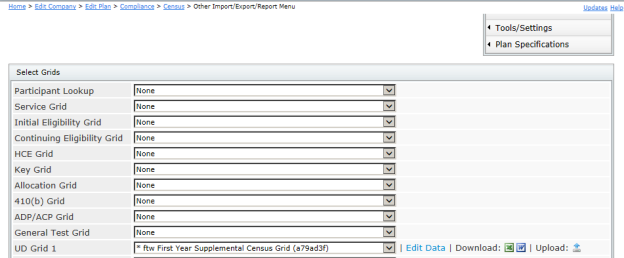
-
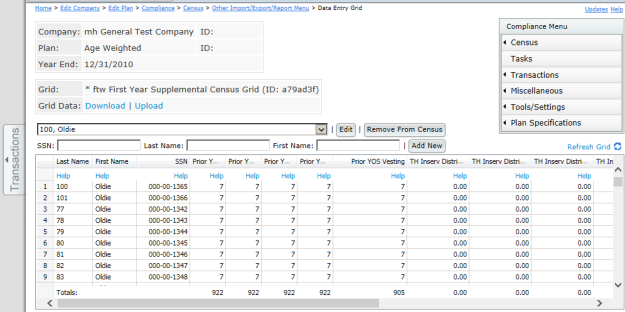
- Prior Year Terminated Employees (that are on your census upload):
- To override and hardcode the vesting percentage for an employee who will not accrue any additional vesting: click on “Census” from the Compliance Menu -> Select the participant from the drop-down box and press “Edit”. Click “Vesting Override” link -> Set override to “Yes” for each source you wish to override -> Enter the vesting percent for each source -> Press update.
- Note: The percent that is entered here will not change in future years under any circumstances until the percentage is again changed or the override is set back to “No”.
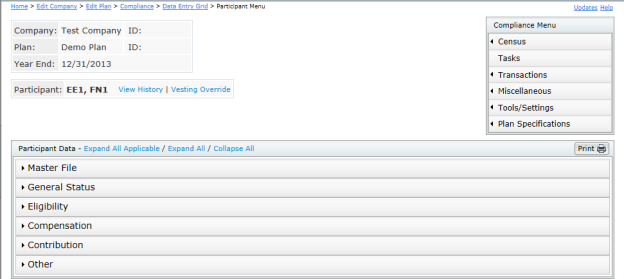
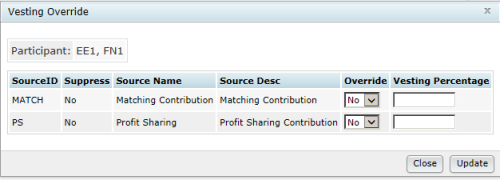
- Prior Year Terminated Employees (that are not on your census upload):
- To override vesting service for an employee terminated in a prior year the user will simply upload the vesting history via the “Service” upload history option and run the data scrub. For additional instructions for uploading vesting history, click here.
- The system will calculate the vesting service based on the history uploaded.
Subsequent Plan Years on the System
- Active Employees: To override individual vesting service override for active employees in subsequent years on the system: Edit Census -> Select Participant -> Eligibility -> First, set “Override calculation of prior year cumulative service for vesting purposes” to “Yes”. Then change the “Prior years of cumulative service for vesting” to the appropriate number of vesting years of service (prior to the current year). Last, run the data scrub.
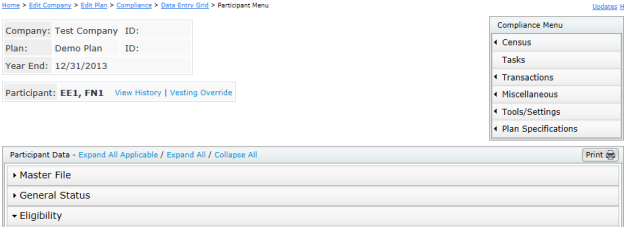

- Prior Year Terminated Employees (that are on your census upload):
- To hardcode the vesting percentage for an employee who will not accrue any additional vesting: click on “Edit Census” from the main Compliance Menu screen -> Select the participant from the drop-down box -> click “Vesting Override” link -> Set override to “Yes” for each source you wish to override -> Enter the vesting percent for each source -> Press update.
- Note: The percent that is entered here will not change in future years under any circumstances until the percentage is again changed or the override is set back to “No”.


- Prior Year Terminated Employees (that are not on your census upload):
- To override vesting service for an employee terminated in a prior year the user will simply upload the vesting history via the “Service” upload history and run the data scrub. For additional instructions for uploading vesting history, click here.
- The system will calculate the vesting service based on the history uploaded.
Vesting FAQ's
- FAQ: Why are my prior terms shown as being 0% vested? Check your current year census. No prior year terms should be on the census. To remove prior year terms from the census grid click “Edit Census” -> Select the participant from the drop-down box -> Press “Delete Participant”. These employees will now appear above the census grid.
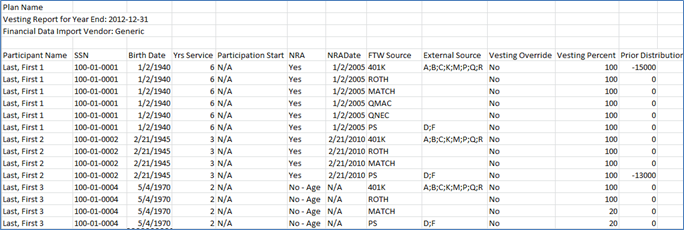
10.14. Age Weighted Allocations
The total company contribution shall be allocated to each Participant such that the equivalent benefit accrual rate (EBAR or EAR) for each Participant is identical. The actual calculation is that a participant will receive an allocation based on the ratio of his/her points to total points of all participants.
Points for each participant are equal to: Compensation * 1/(1 + interest rate)^years to retirement * annuity factor.
In Allocation Parameters, the “Allocation Type” should be set to “Dollar” the total dollar amount to be allocated entered in “Nonelective contribution in total dollars to be allocated:” in order to have the system calculate the age weighted allocation. The factor is calculated by the system. The user can enter the interest rate and actuarial table that should be used in the calculation.
Setting “Provide decrement for participants past NRA” to “Yes” means that any participants who have attained an age beyond the stated normal retirement age (NRA) will use the retirement age in the calculation rather than the participant’s actual attained age. This results in a lower allocation than would be allocated if actual age beyond NRA was used.
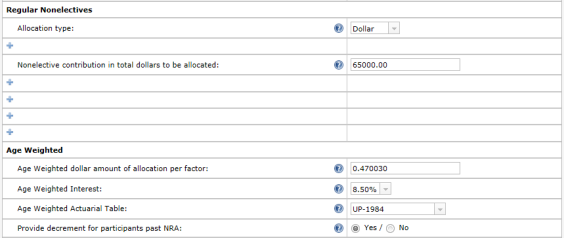
10.15. JH Rate of Return
Setup Plan Specifications
- Compliance Menu à Plan Specifications à Sources and Inv Accounts
- Set “Financial data import vendor” to “JH RoR”
- Enter “Financial data import ID code:”
- Click the “Work with Sources” link
- Verify all sources to be used in the plan are listed
- Press update

Setup ADP/ACP Test Parameters
- Expand “ADP/ACP Test” to view/edit parameters
- Set ADP/ACP Refund income calculation to “Percent”

Upload JH RoR
- Go to the Transactions Menu
- Click “Map John Hancock Sources” and set the JH sources for the applicable FTW sources.
- Click “Upload JH RoR Transaction File”
- Press “Browse” to search computer for upload file
Hint: Press “Click here for sample file” to review JH RoR transaction file format
10.16. Davis Bacon
Non-elective Davis Bacon Contributions
Plan Specifications
First, we need to verify that the plan is setup properly to permit Nonelective Davis Bacon contributions. From the main Compliance Menu, go to Plan Specifications and expand Contribution parameters bar. Scroll down to the Nonelective section. Under Nonelective - Contribution, "Nonelective Davis Bacon" determines if the plan is set to permit Nonelective Davis Bacon contributions. If changes are needed to be made to this setting, press the radio button next to the applicable setting. Pressing the radio button to the left of "Yes" indicates that Nonelective Davis Bacon contributions are permitted by the plan. Pressing the radio button to the left of "No" indicates that Nonelective Davis Bacon contributions are not permitted by the plan.
If the plan document permits Nonelective Davis Bacon contributions to offset regular Nonelective contributions, set the Nonelective Davis Bacon offset to "Yes". Note: “Profit Sharing Davis Bacon offset” will not be available until “Profit Sharing Davis Bacon” is set to “Yes”.

Work with Sources/Inv Accounts
The Nonelective Davis Bacon source should be in the list of sources in Work with Sources/Inv Accounts, for transactional/financial purposes.
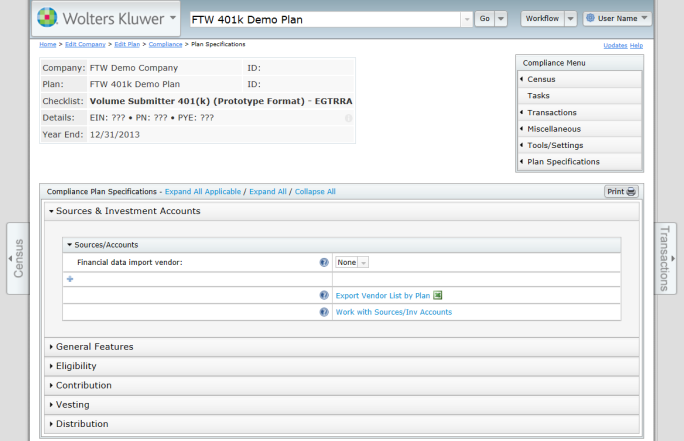
If the Nonelective Davis Bacon source (SourceID: PSDAVBAC) is not displayed in the list of sources upon your arrival to this screen, click the "Add Default Sources" link to have the system automatically add the missing source(s).

Set Davis Bacon Eligibility and Enter Davis Bacon Contributions
Eligibility for Davis Bacon contributions and Davis Bacon contributions themselves, must be explicitly entered into the ftwilliam.com system. From the Compliance Menu, hover over Census and Select Other Import/Export/Reports. Using the drop down box next to any of the user defined grids spots, select the "*ftw Davis Bacon" grid.
The NE Davis Bacon Eligibility column will be used in compliance tests such as the 410(b) Test, 415 Test, Deduction Test, etc. For example, if a participant's NE Davis Bacon Eligibility is set to Yes or No, they will be classified as a nonexcludable employee in the 410(b) Coverage test. Assuming that the NE Davis Bacon is the only type of non-elective source in the plan, if a participant's NE Davis Bacon Eligibility is set to No-Excl, they will be classified as an excludable employee in the 410(b) Coverage test. If a nonexcludable employee has an allocation amount entered in the NE Davis Bacon Contribution column, that person will be classified as benefiting within the 410(b) Coverage Test.

Creating Davis Bacon Allocations from Transaction Batches
As an alternative to manually entering Davis Bacon contributions, if Davis Bacon contributions have been entered or uploaded into the ftwilliam.com software and have been posted in the Transactions screen, users can use the "Create $x.xx Allocations" link to push the amounts from the Transactions screen to the Compliance testing area (contributions will then appear in the ftw Davis Bacon grid).

Allocation Parameters for Nonelective Davis Bacon Offset
In order for regular nonelective contributions to be calculated and offset, “Nonelective allocation manual override” must be set to “No”. “Nonelective allocation manual override” is located under Allocation parameters in the main Compliance screen.
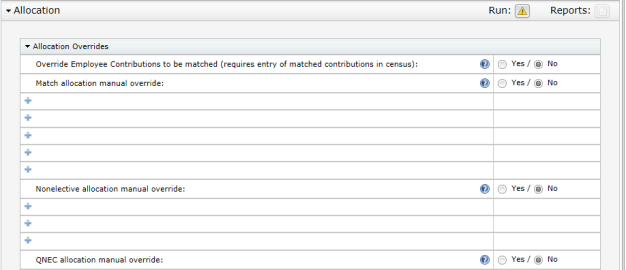
Additionally, a nonelective formula needs to be entered. This tells the system what percentage or dollar amounts should be allocated for each eligible participant. For example, in the screenshot below, I have set the pro rata formula for the regular profit sharing to 5%. When the allocation "Run" button is pressed, the system will calculate a 5% profit sharing allocation for all eligible employees, then reduce those amounts by the Nonelective Davis Bacon amounts previously entered, as applicable for each participant. The allocation report will display the combined allocations for all nonelective amounts in the "Allocate NonElec column".

QNEC Davis Bacon Contributions
Plan Specifications
First, we need to verify that the plan is setup properly to permit QNEC Davis Bacon contributions. From the main Compliance Menu, go to Plan Specifications and expand Contribution parameters bar. Scroll down to the QNEC section. "QNEC Davis Bacon" determines if the plan is set to permit QNEC Davis Bacon contributions. If changes are needed to be made to this setting, press the radio button next to the applicable setting. Pressing the radio button to the left of "Yes" indicates that QNEC Davis Bacon contributions are permitted by the plan. Pressing the radio button to the left of "No" indicates that QNEC Davis Bacon contributions are not permitted by the plan.
If the plan document permits QNEC Davis Bacon contributions to offset regular QNEC contributions, set the QNEC Davis Bacon offset to "Yes".

Work with Sources/Inv Accounts
The QNEC Davis Bacon source should be in the list of sources in Work with Sources/Inv Accounts, for transactional/financial purposes.

If the QNEC Davis Bacon source (SourceID: QNECDAVBAC) is not displayed in the list of sources upon your arrival to this screen, click the "Add Default Sources" link to have the system automatically add the missing source(s).

Allocation Parameters for QNEC Davis Bacon
Return to the main Compliance screen and expand the Allocation Parameters. Scroll down to the bottom of the screen to QNEC Allocation. The "Allocation Type" must be set to either "Dollar" or "Specified" if you will be uploading QNEC Davis Bacon contributions.

Set QNEC Davis Bacon Eligibility and Enter QNEC Davis Bacon Contributions
Eligibility for Davis Bacon contributions and Davis Bacon contributions themselves, must be explicitly entered into the ftwilliam.com system. From the Compliance Menu, hover over Census and Select Other Import/Export/Reports. Using the drop down box next to any of the user defined grids spots, select the "*ftw Davis Bacon" grid.
The QNEC Davis Bacon Eligibility column will be used in compliance tests such as the 410(b) Test, 415 Test, Deduction Test, etc. For example, if a participant's QNEC Davis Bacon Eligibility is set to Yes or No, they will be classified as a nonexcludable employee in the 410(b) Coverage test. Assuming that the QNEC Davis Bacon is the only type of non-elective source in the plan, if a participant's QNEC Davis Bacon Eligibility is set to No-Excl, they will be classified as an excludable employee in the 410(b) Coverage test. If a nonexcludable employee has an allocation amount entered in the QNEC Davis Bacon Contribution column, that person will be classified as benefiting within the 410(b) Coverage Test.

Creating Allocations from Transaction Batches
As an alternative to manually entering Davis Bacon contributions, if Davis Bacon contributions have been entered or uploaded into the ftwilliam.com software and have been posted in the Transactions screen, users can use the "Create $x.xx Allocations" link to push the amounts from the Transactions screen to the Compliance testing area (contributions will then appear in the ftw Davis Bacon grid).

Allocation Parameters for QNEC Davis Bacon Offset
In order for regular QNEC contributions to be calculated and offset, “QNEC allocation manual override” must be set to “No”. “QNEC allocation manual override” is located under Allocation parameters in the main Compliance screen.

Additionally, a QNEC formula needs to be entered. This tells the system what percentage or dollar amounts should be allocated for each eligible participant. For example, in the screenshot below, I have set the pro rata formula for the regular profit sharing to 5%. When the Allocation "Run" button is pressed, the system will calculate a 5% QNEC allocation for all eligible employees, then reduce those amounts by the QNEC Davis Bacon amounts previously entered, as applicable for each participant.

Appendix I: List of ftwilliam.com Grids
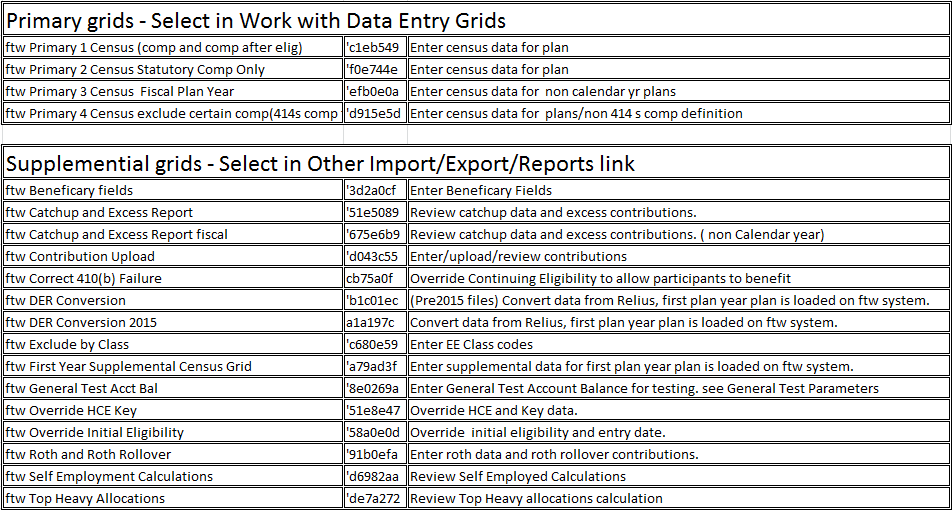
Appendix II: RMD Life Expectancy Tables
Single Life Table
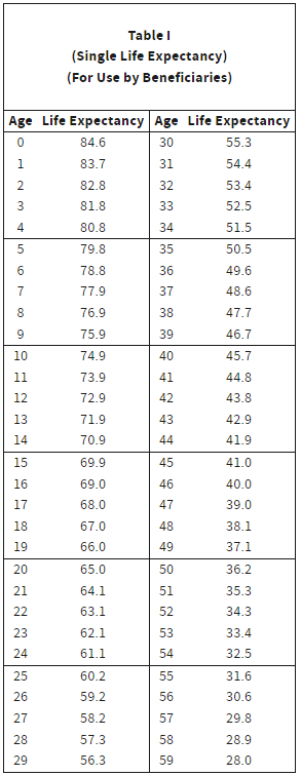
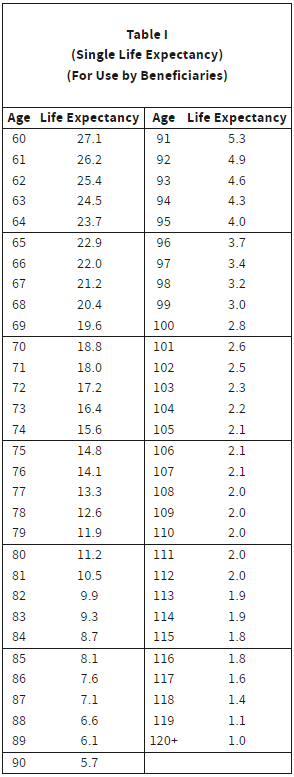
Uniform Life Table
